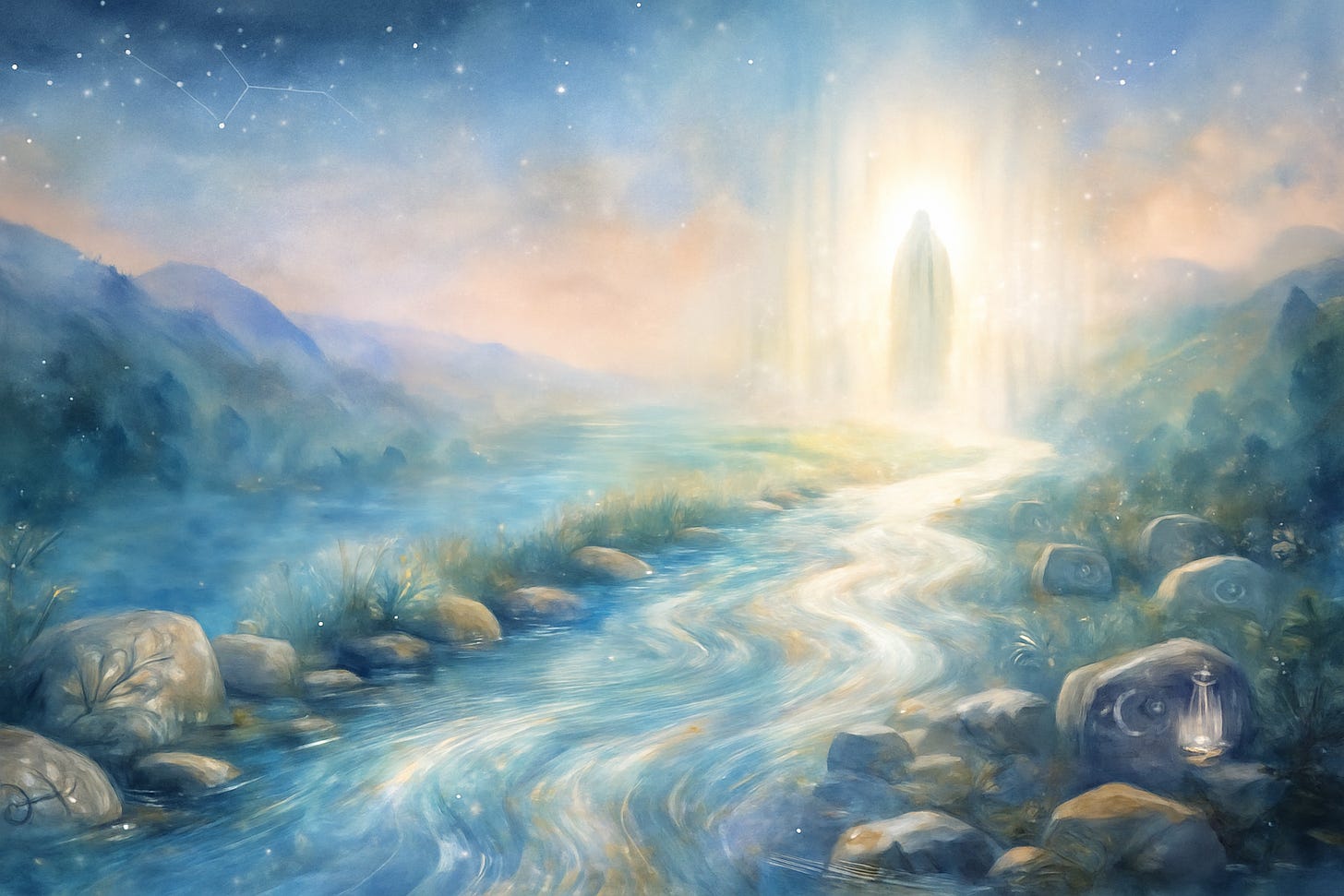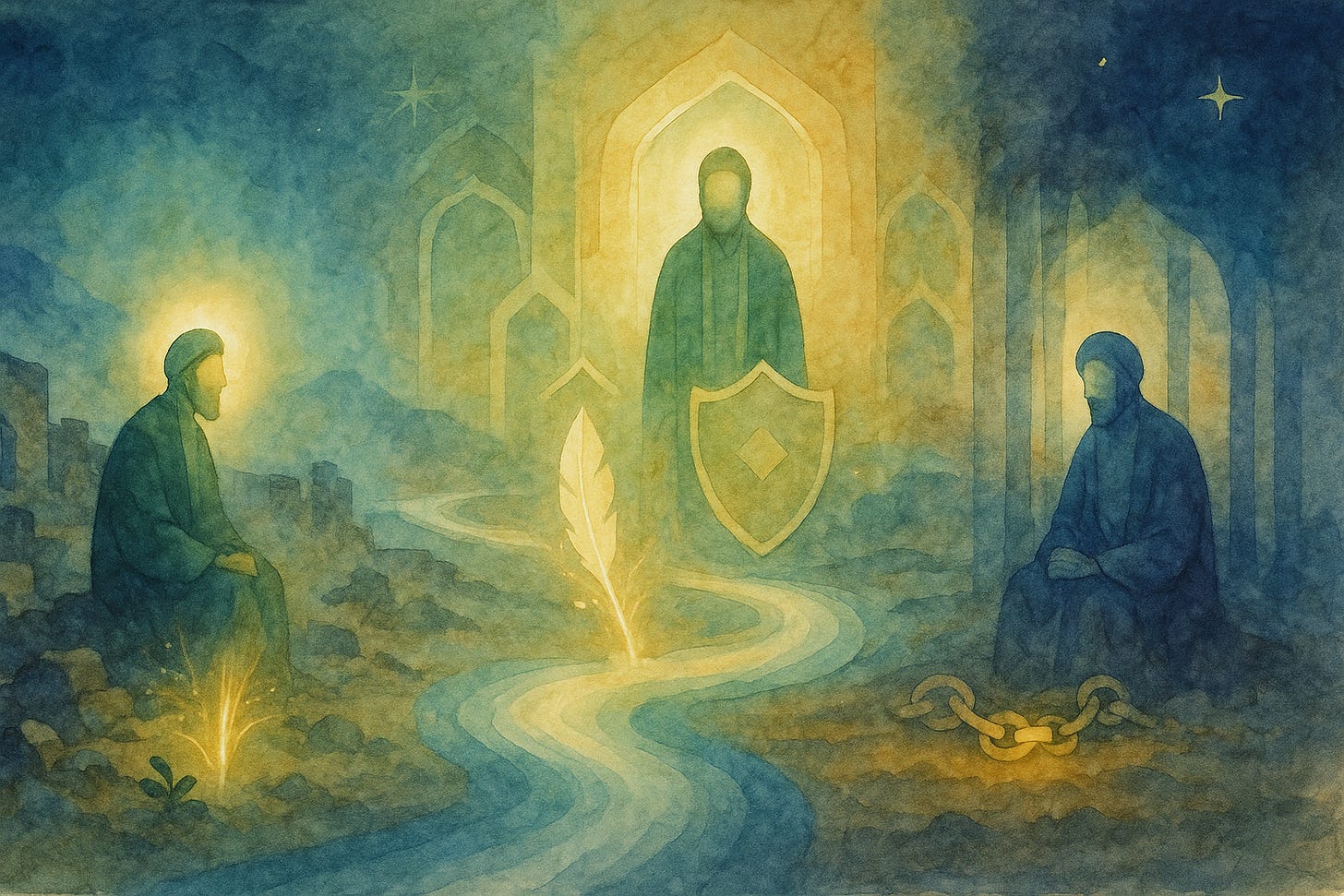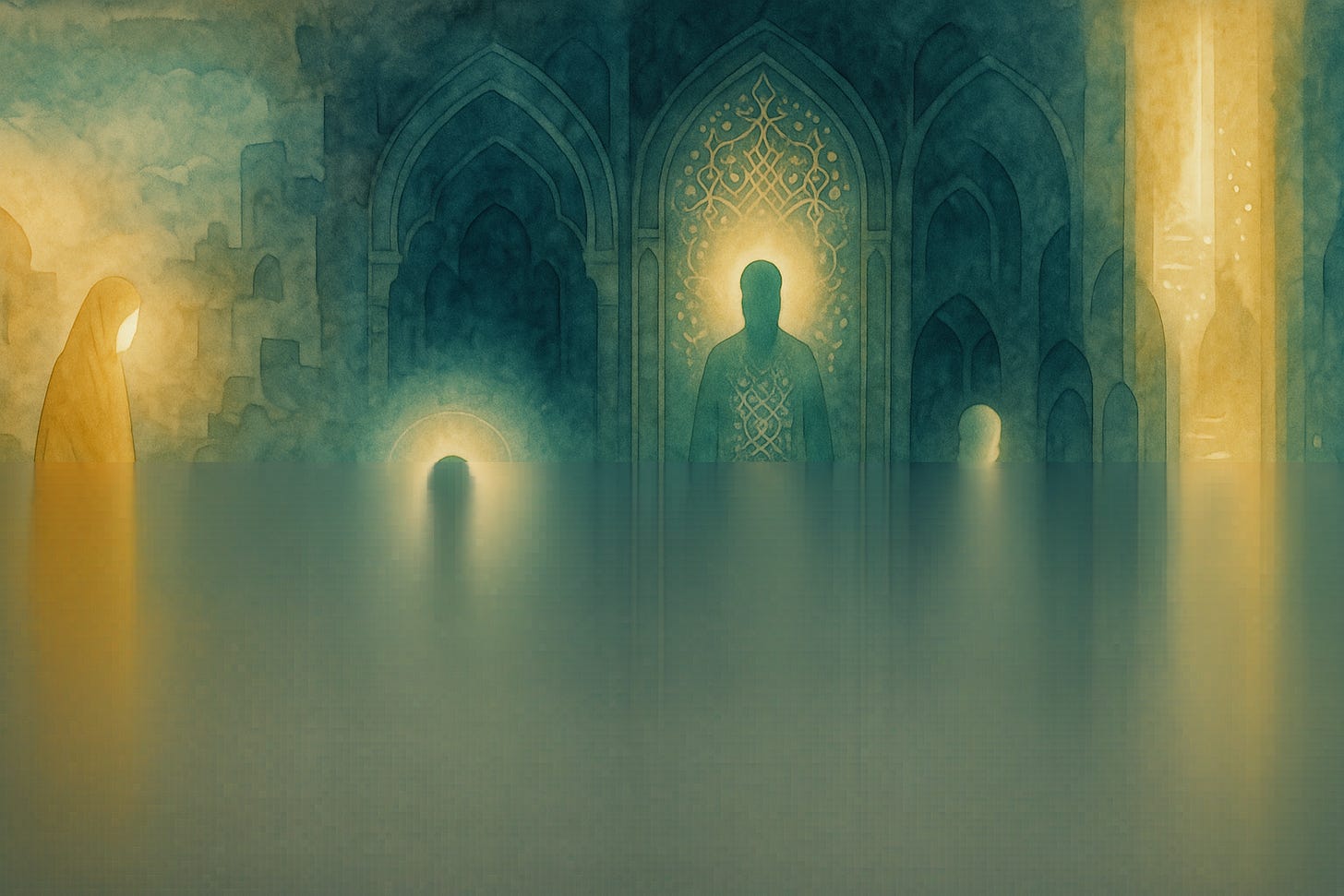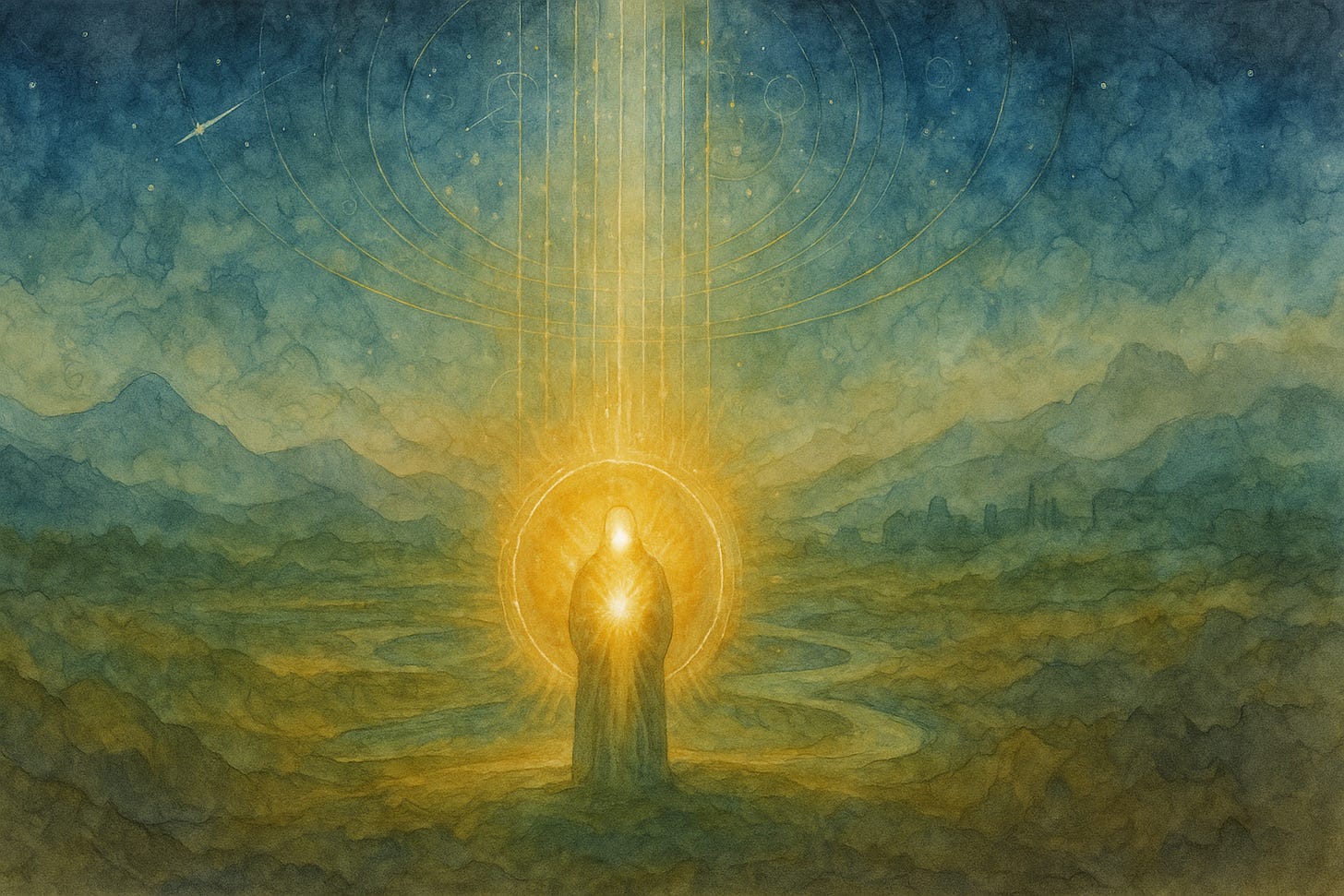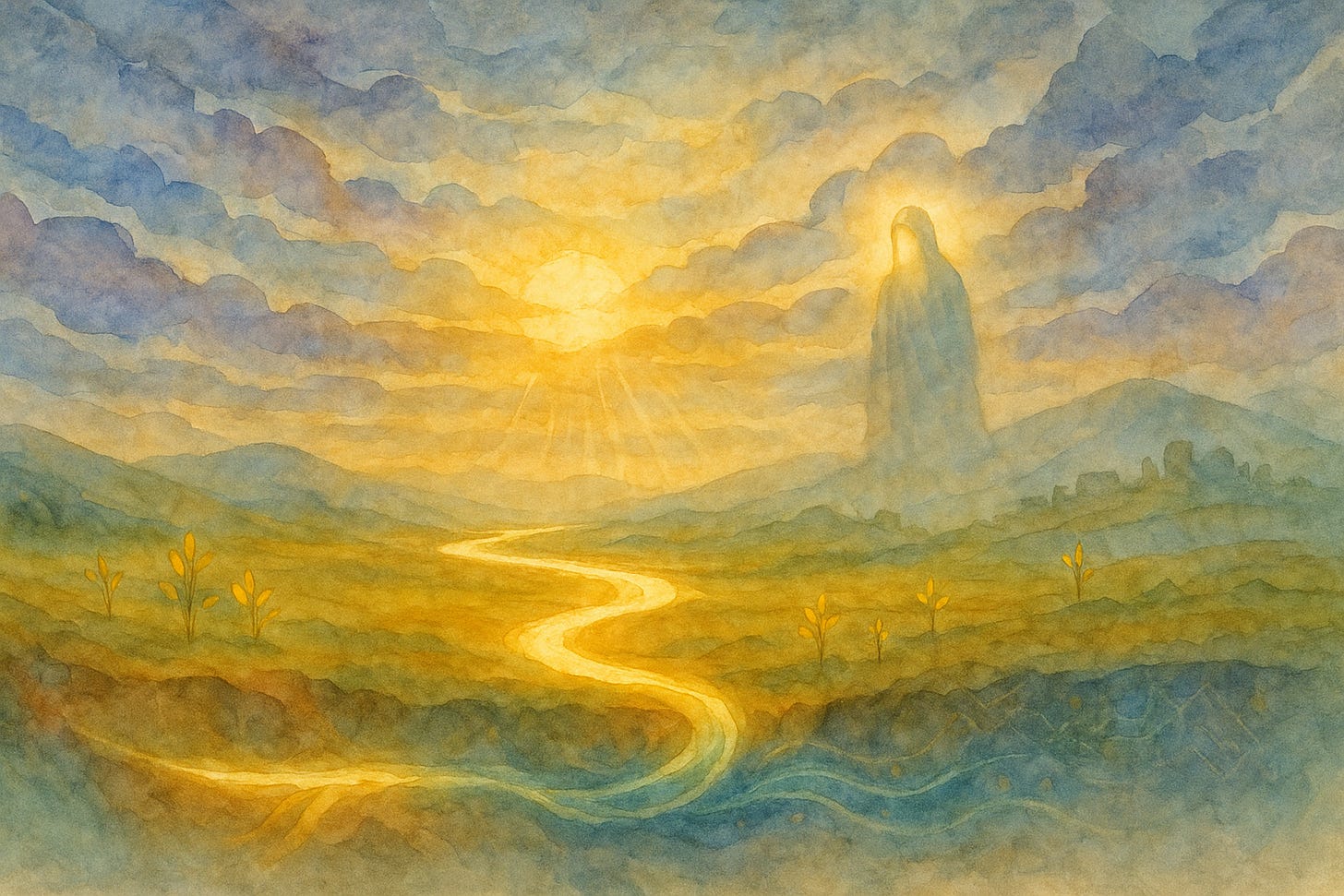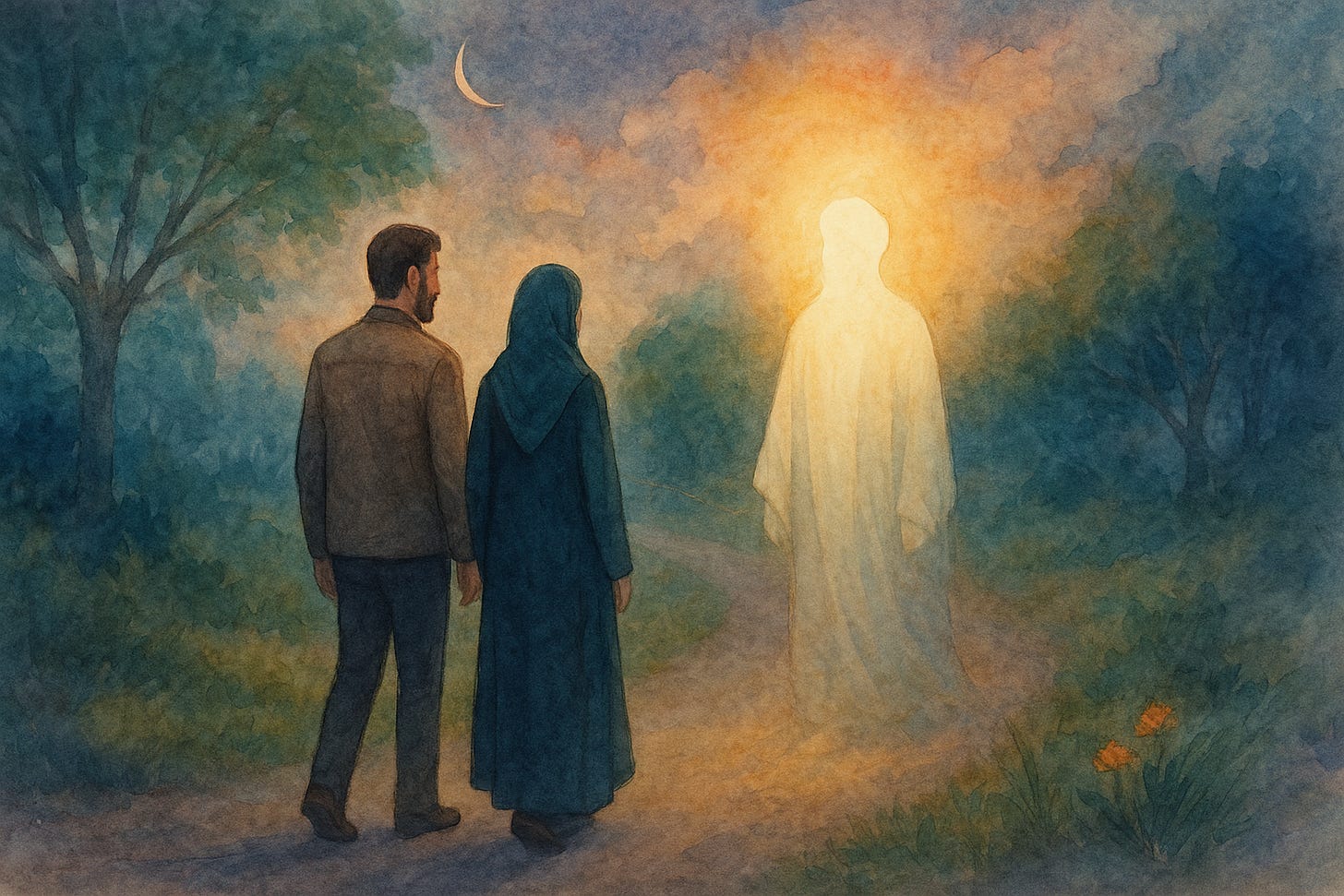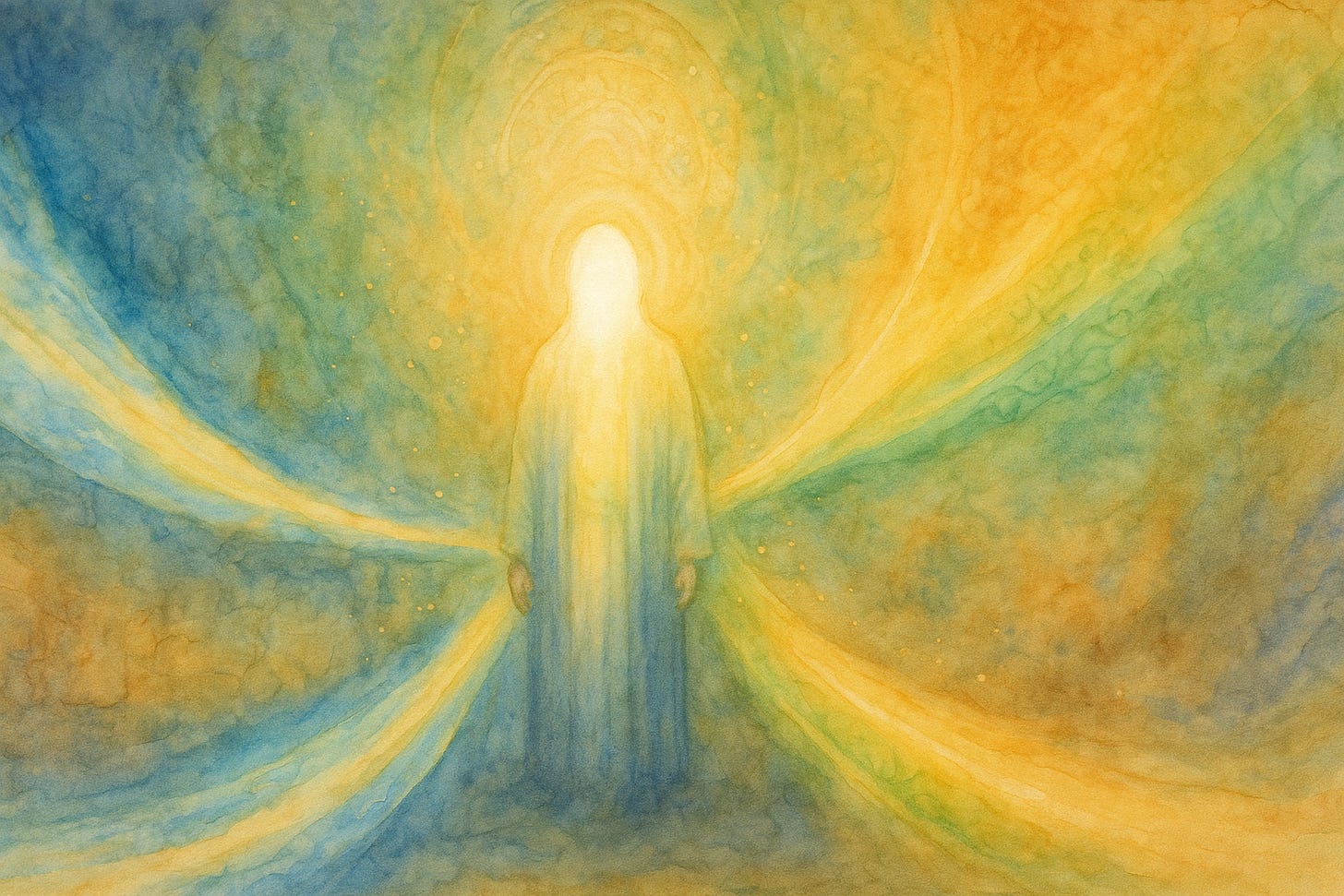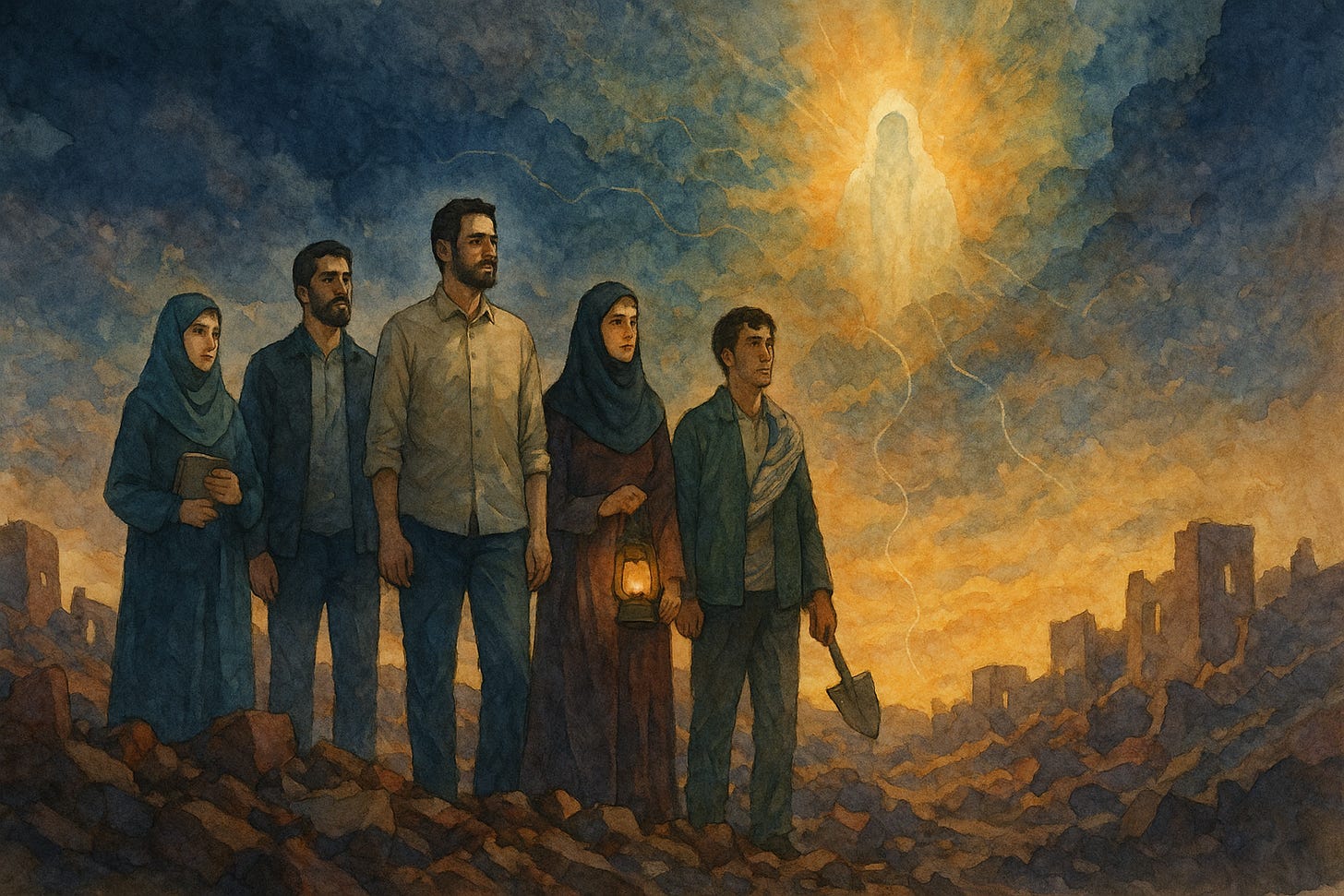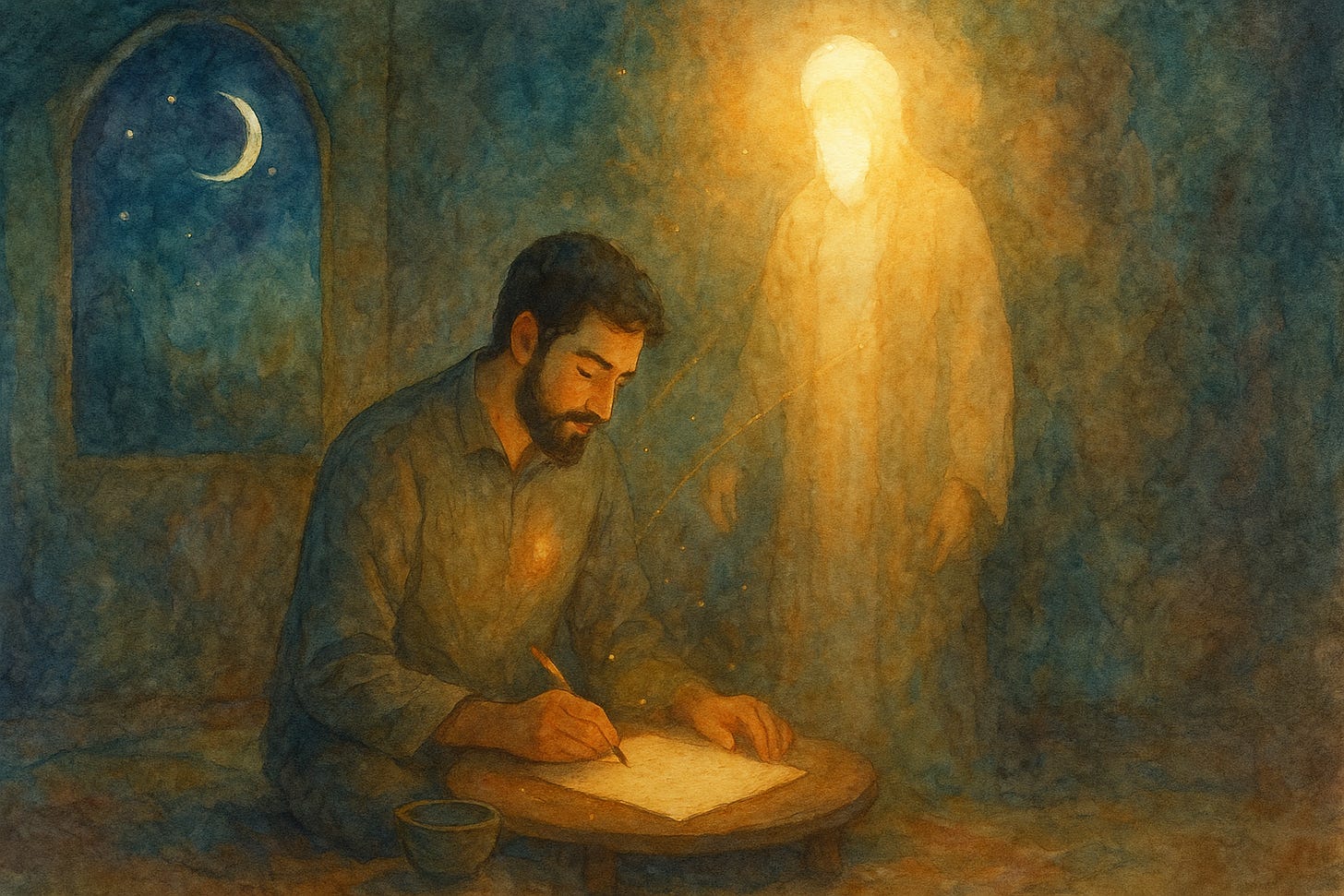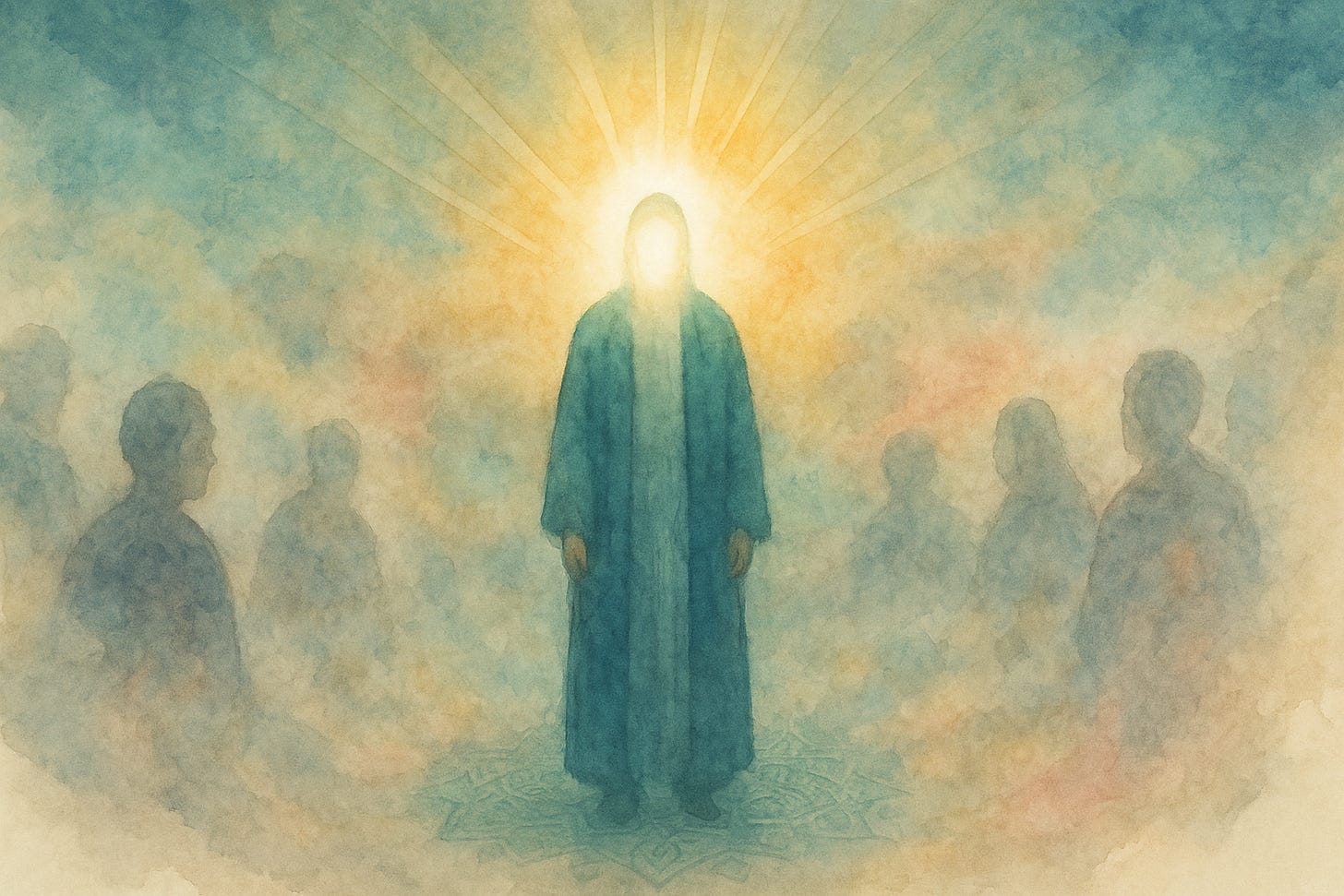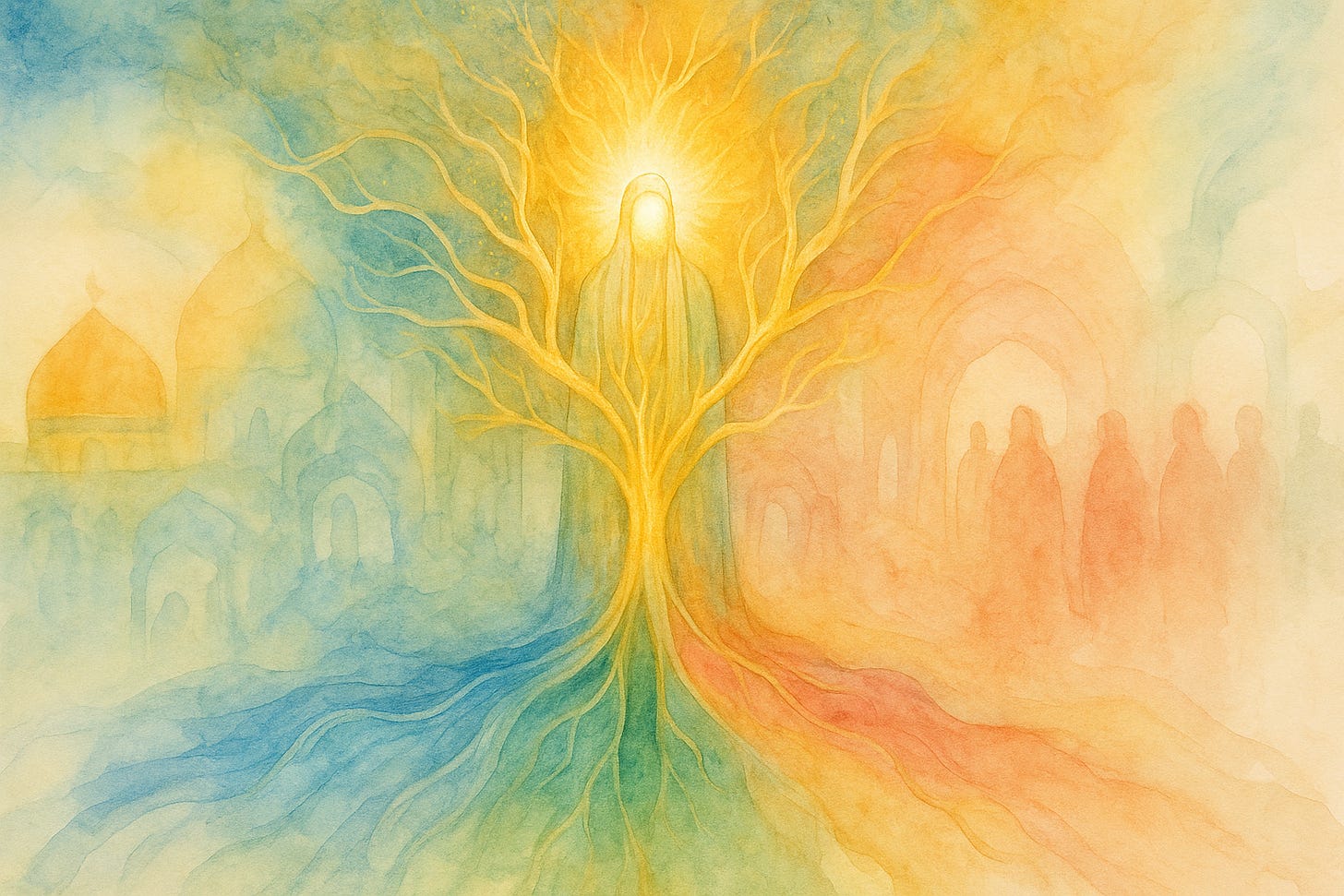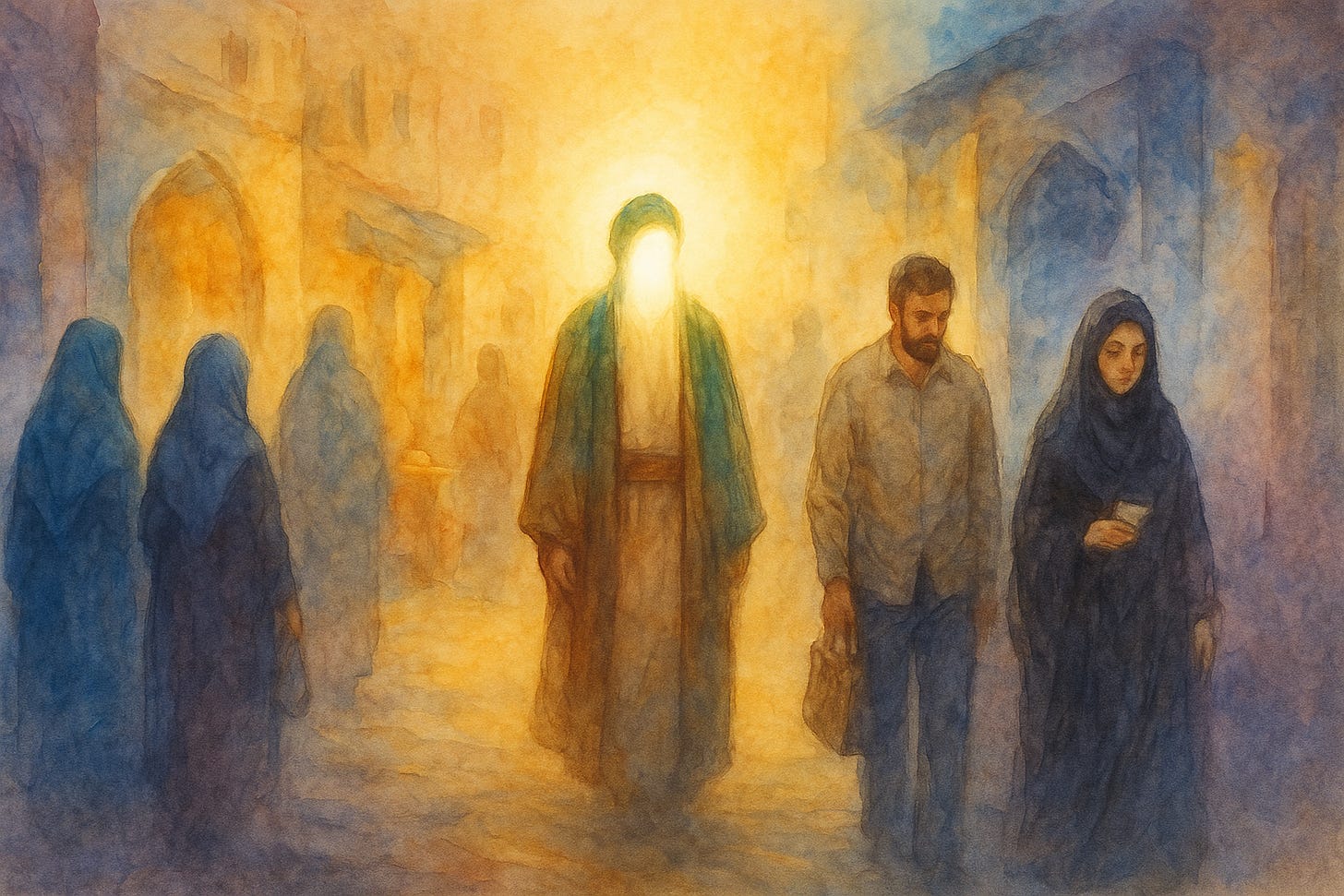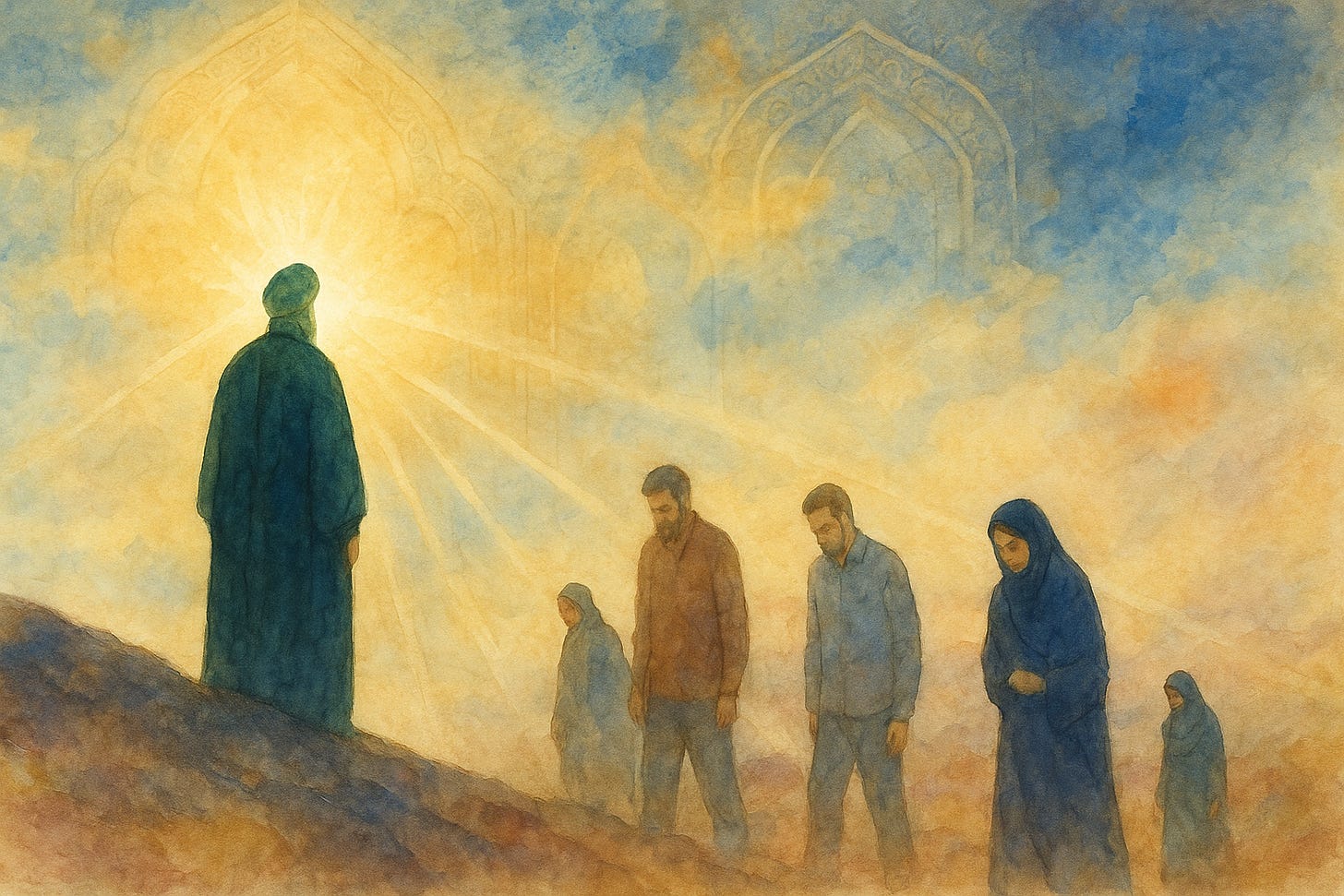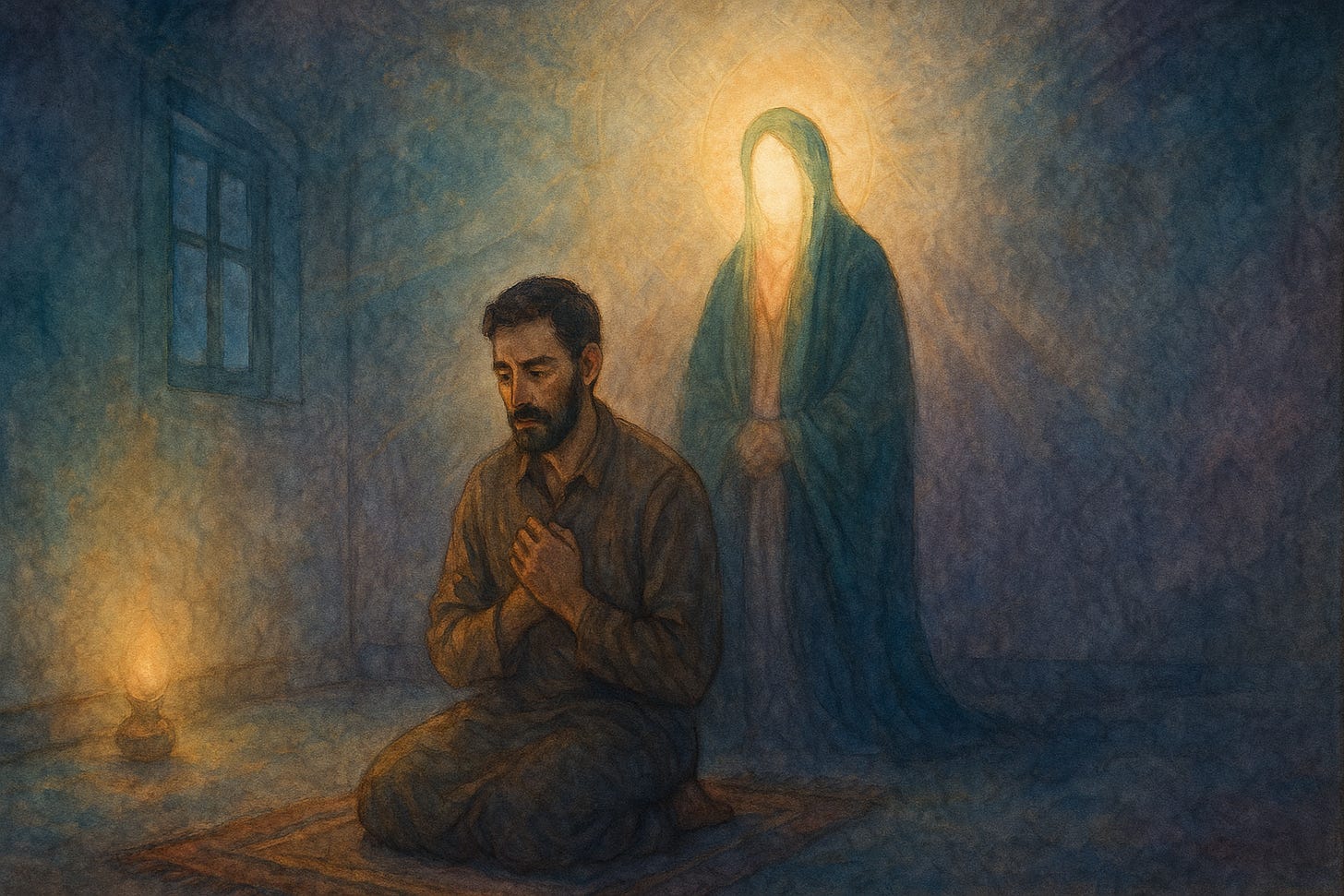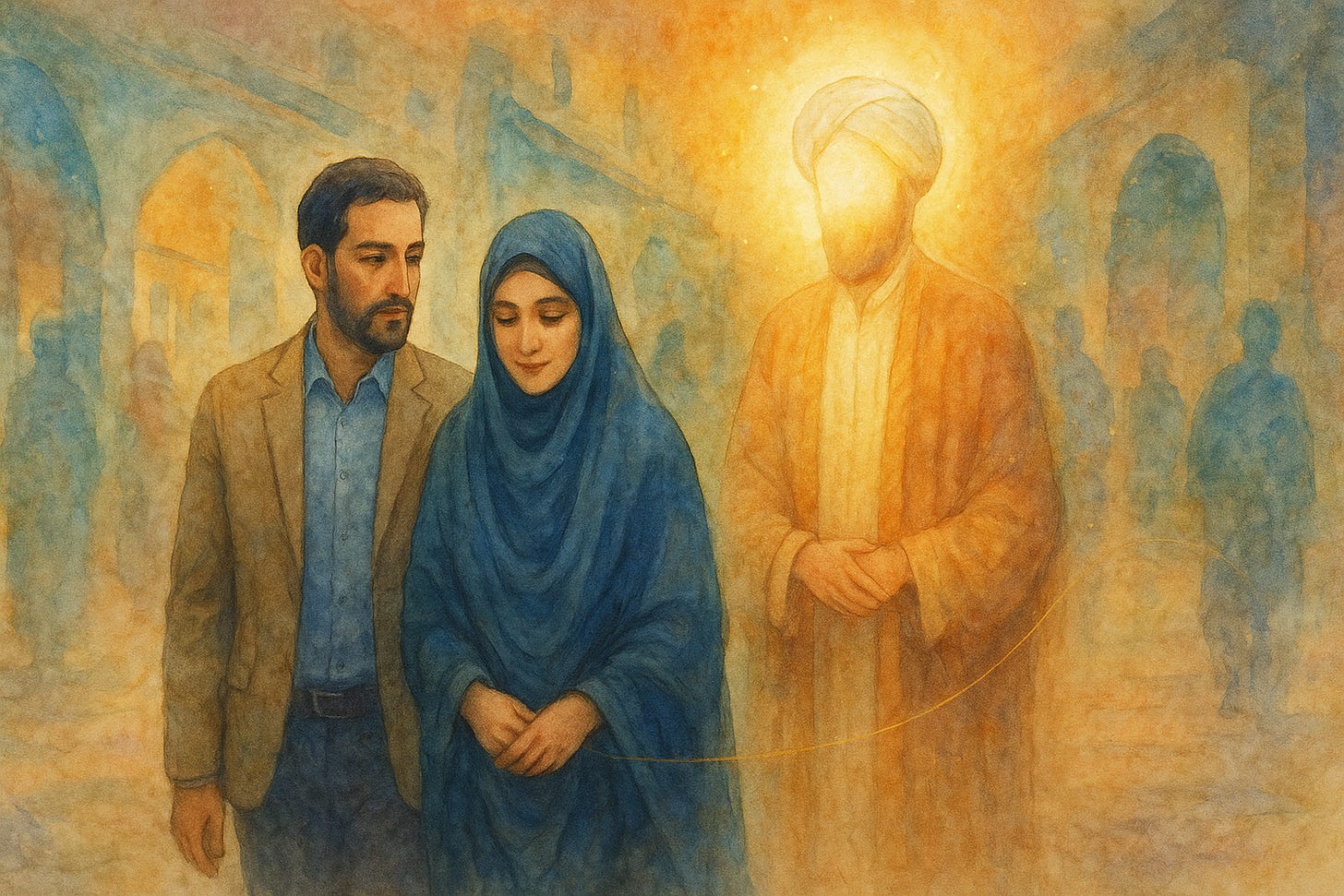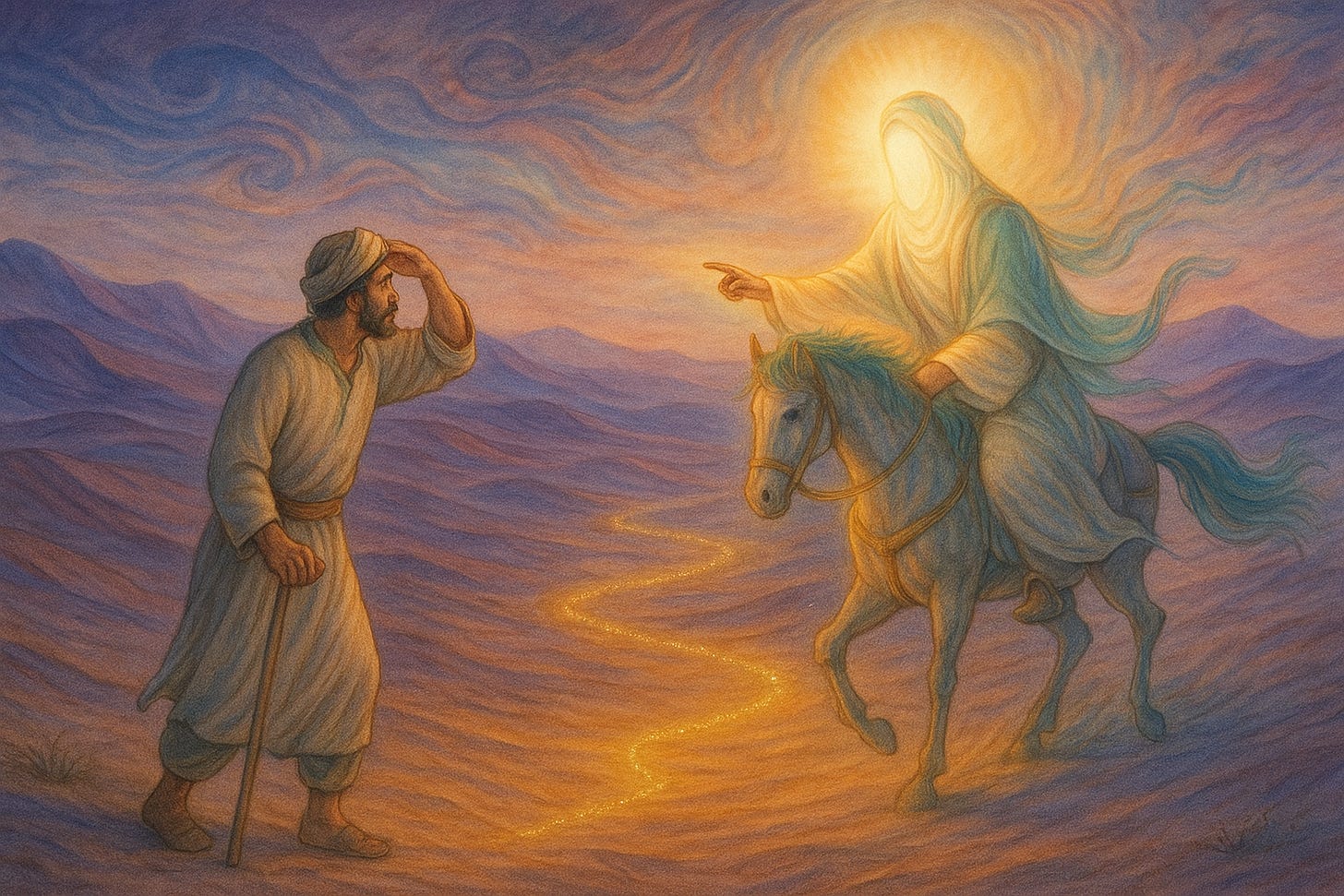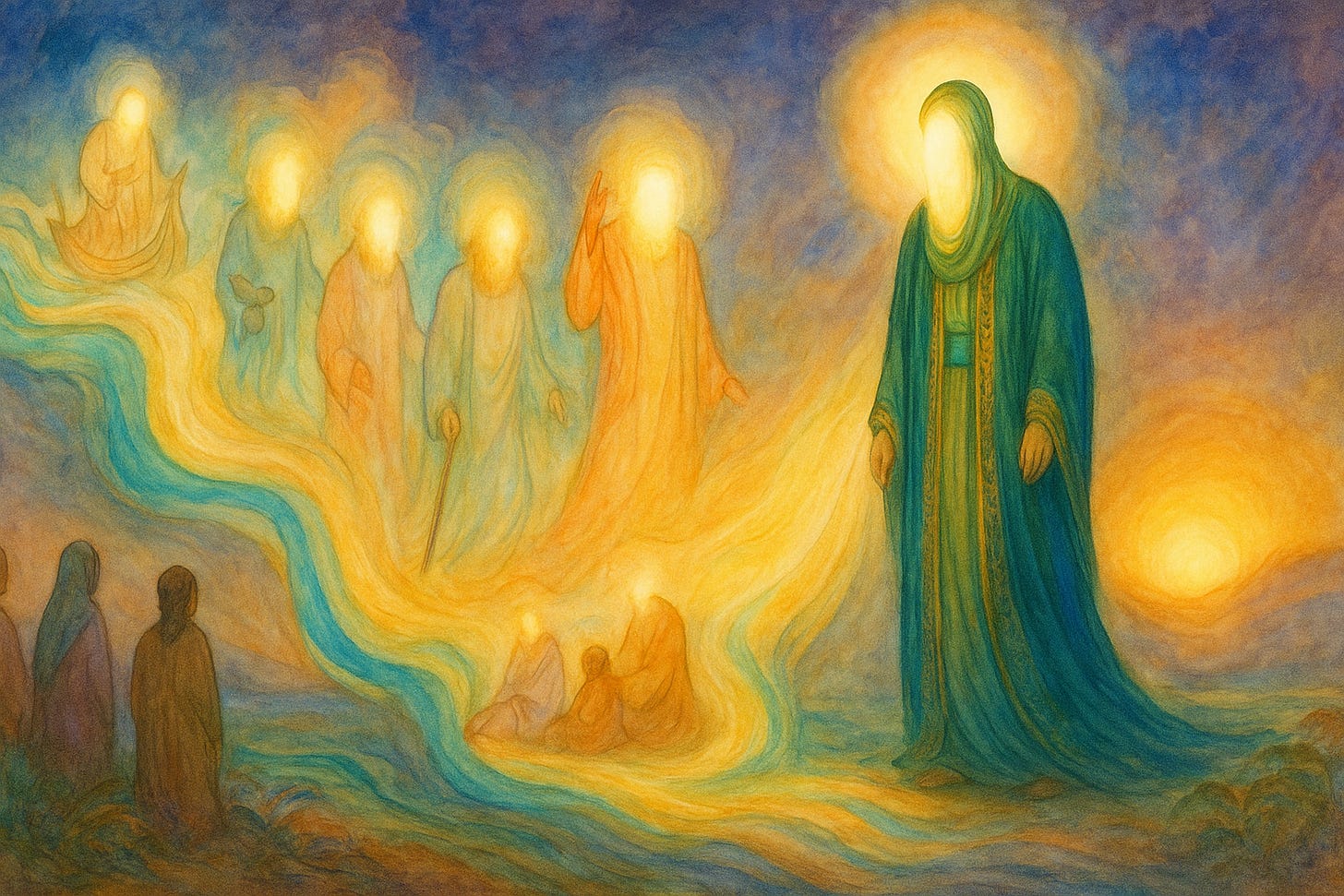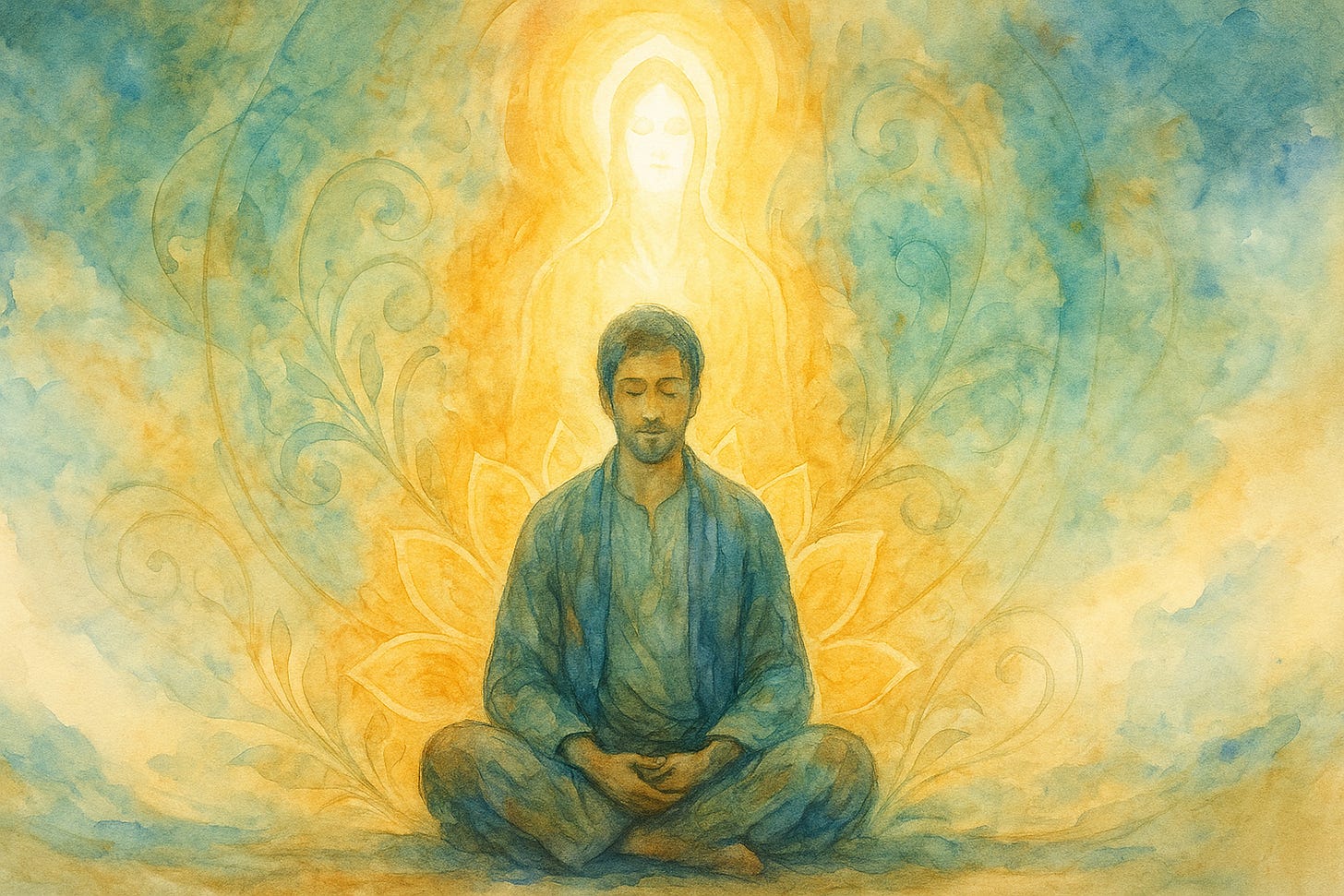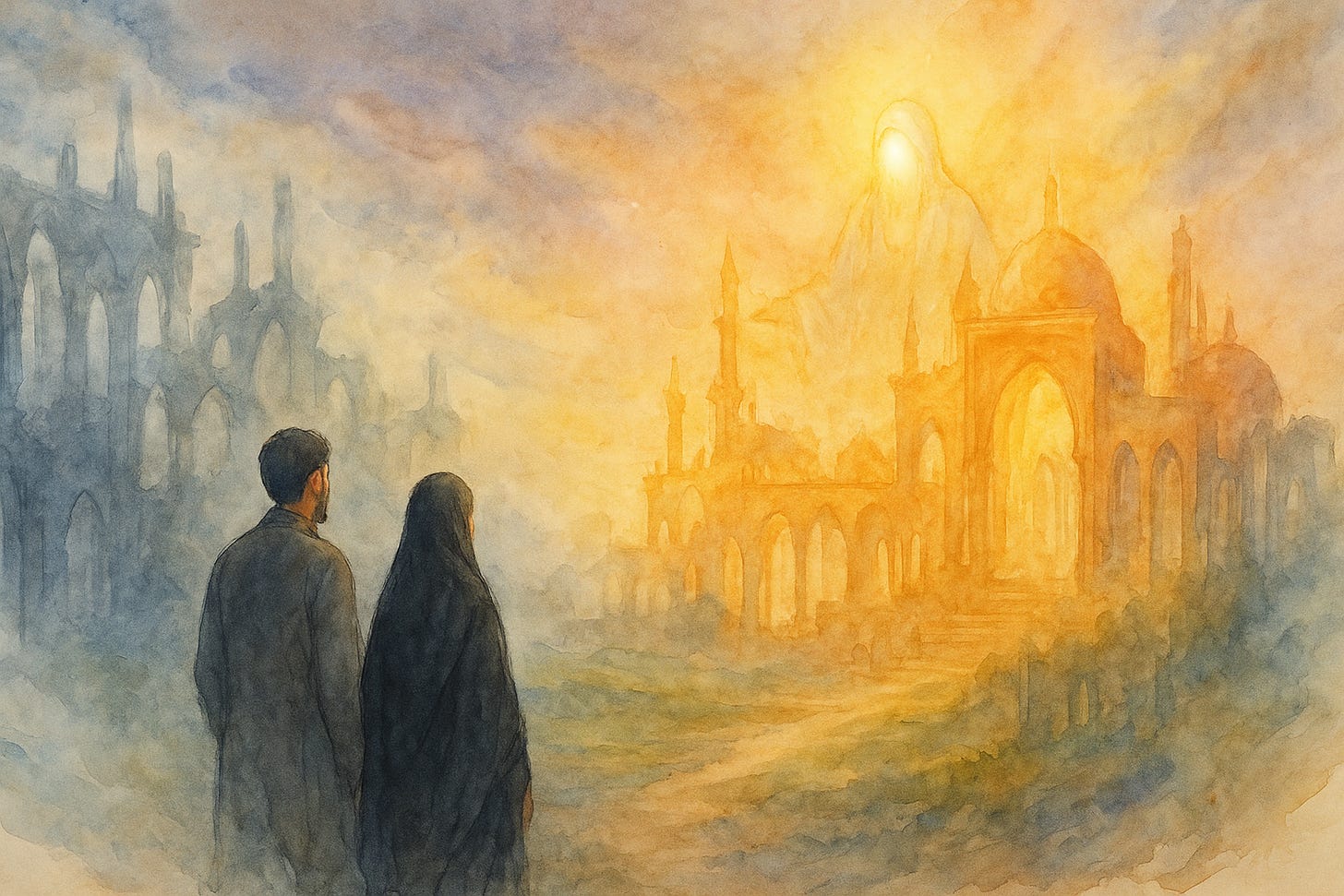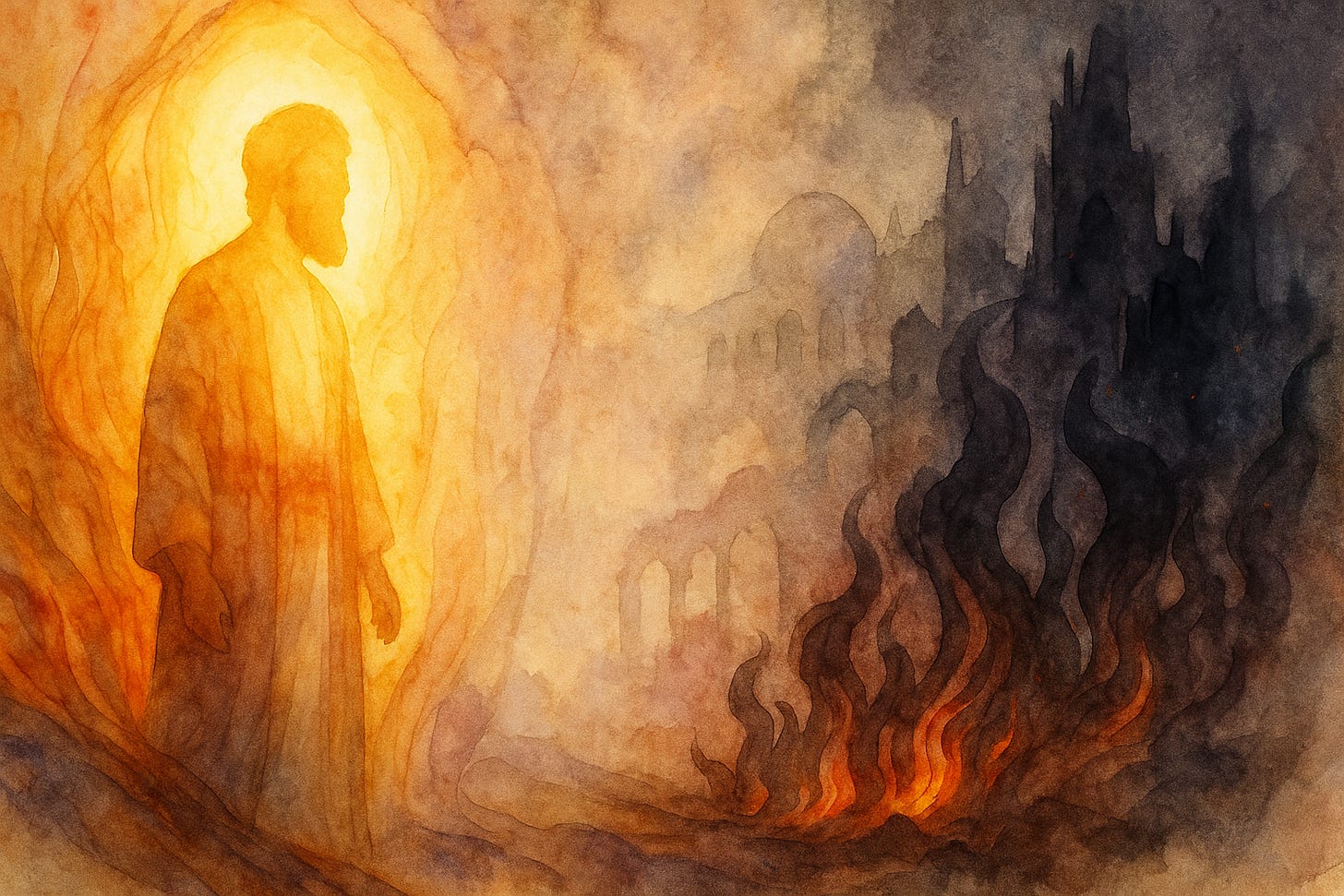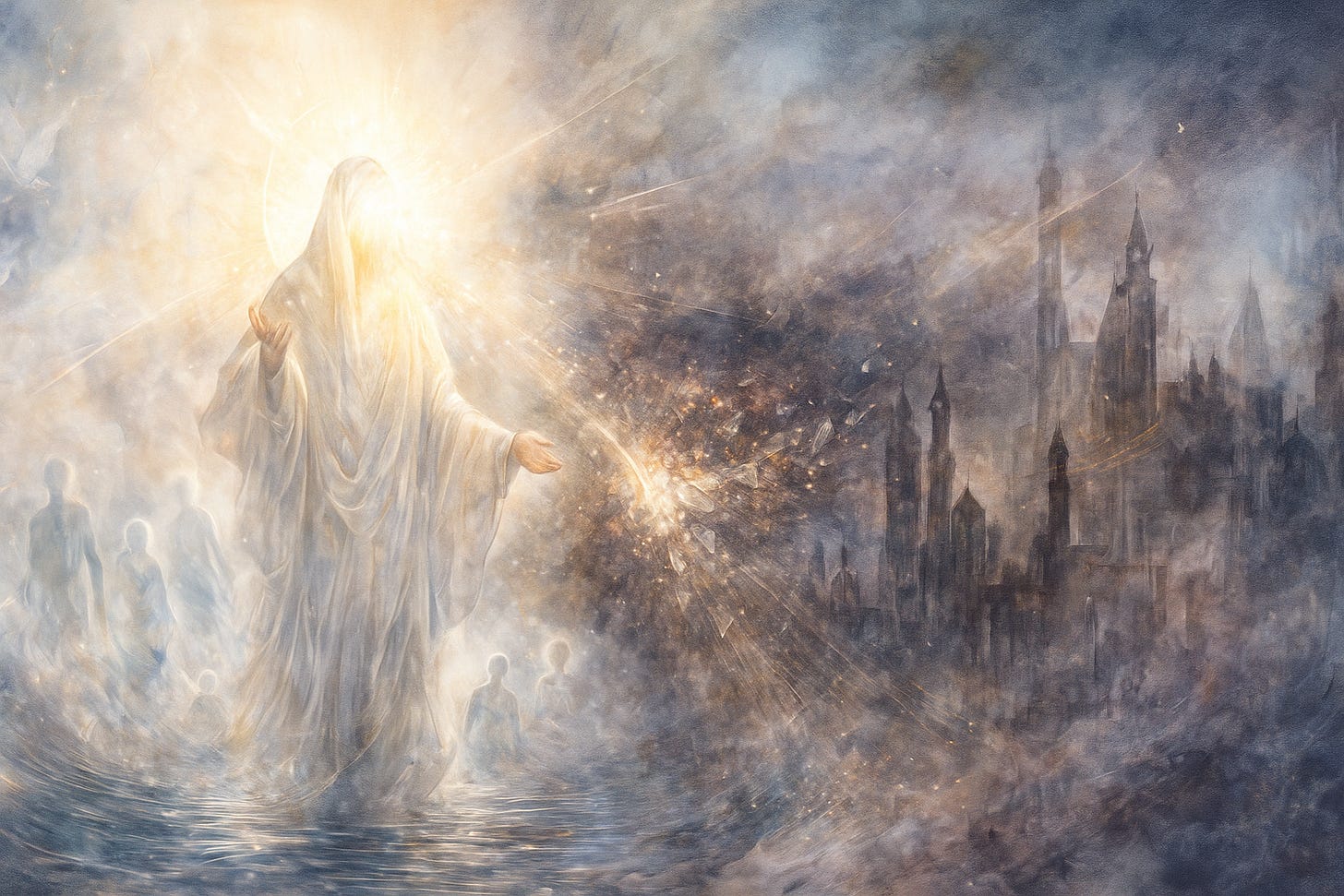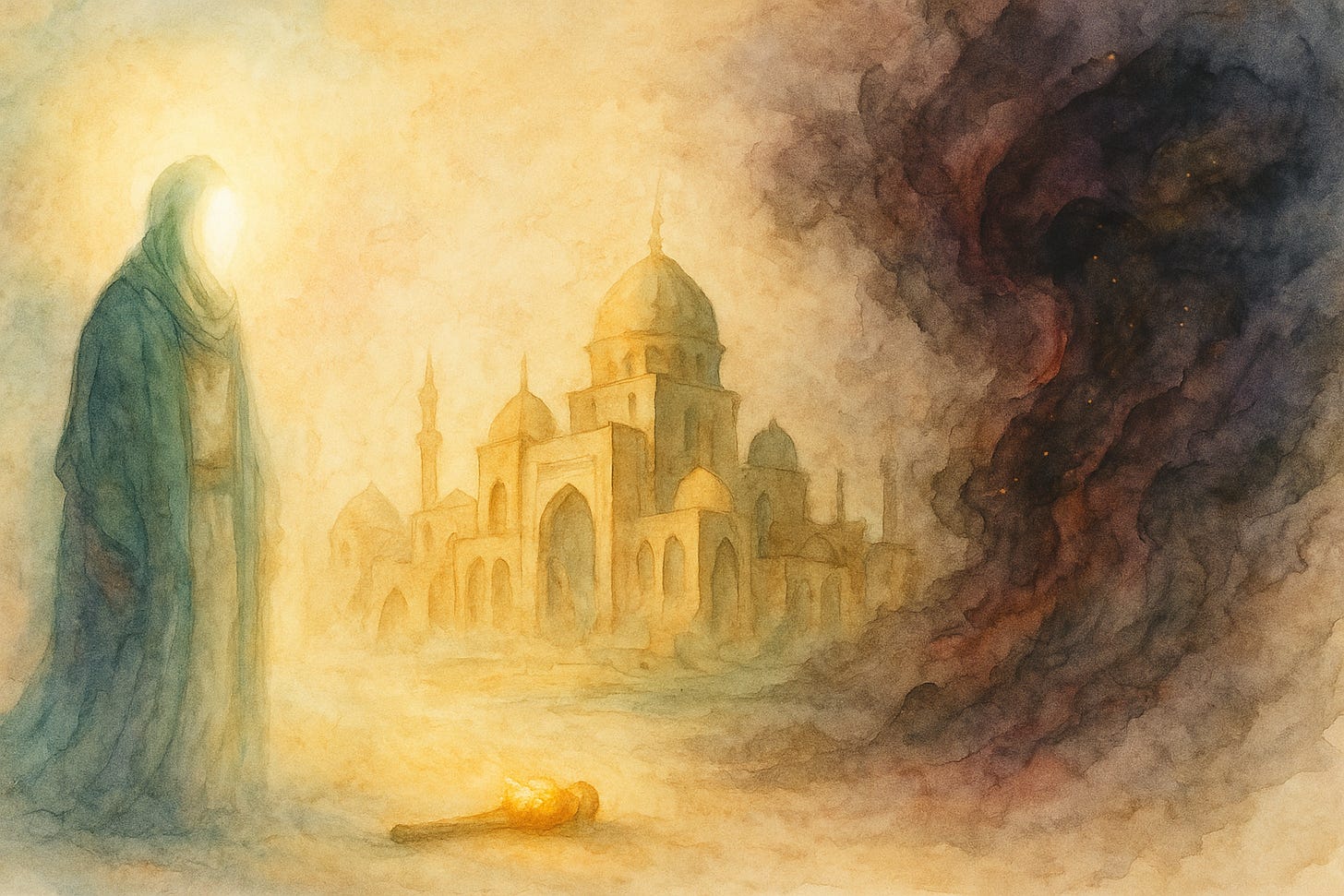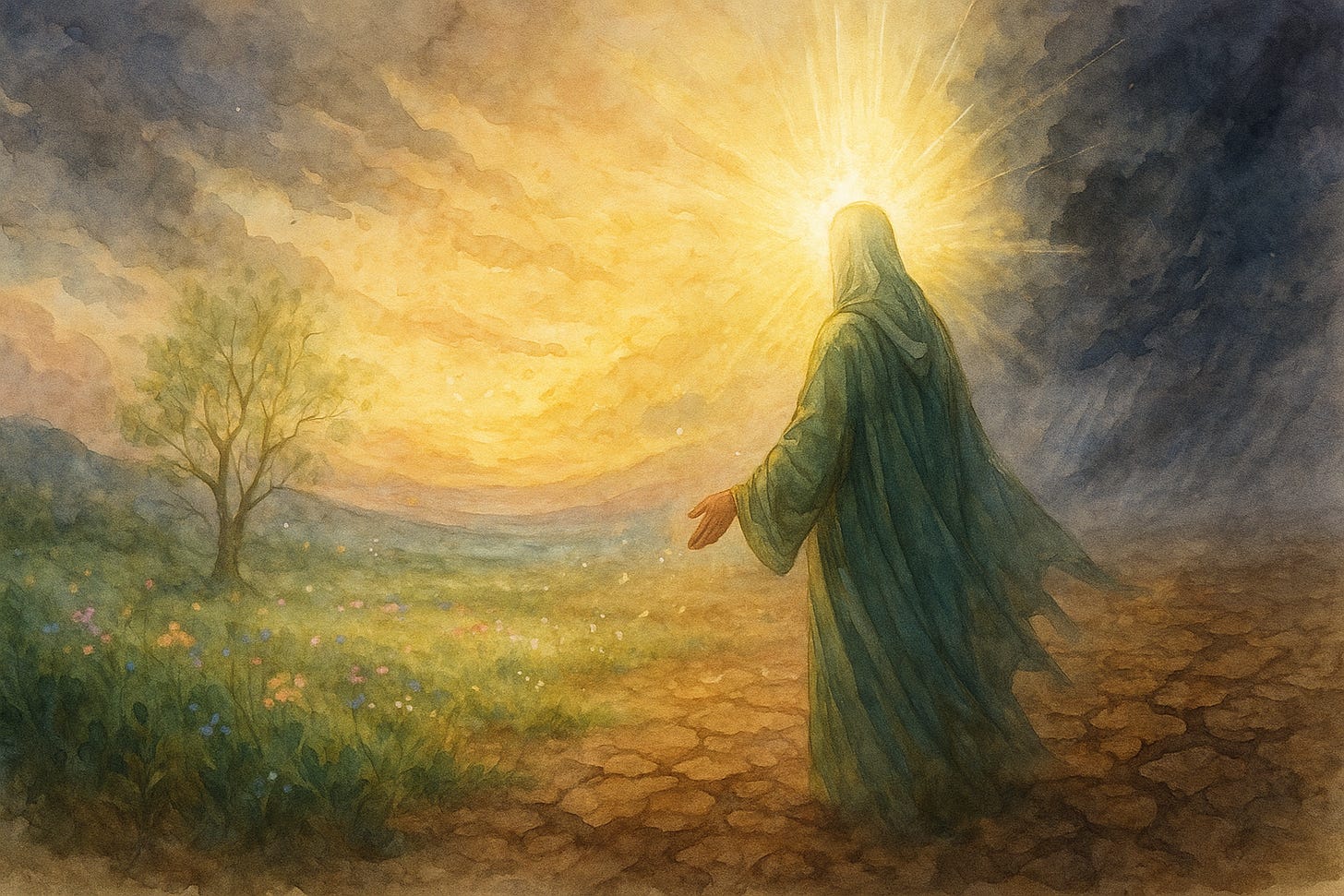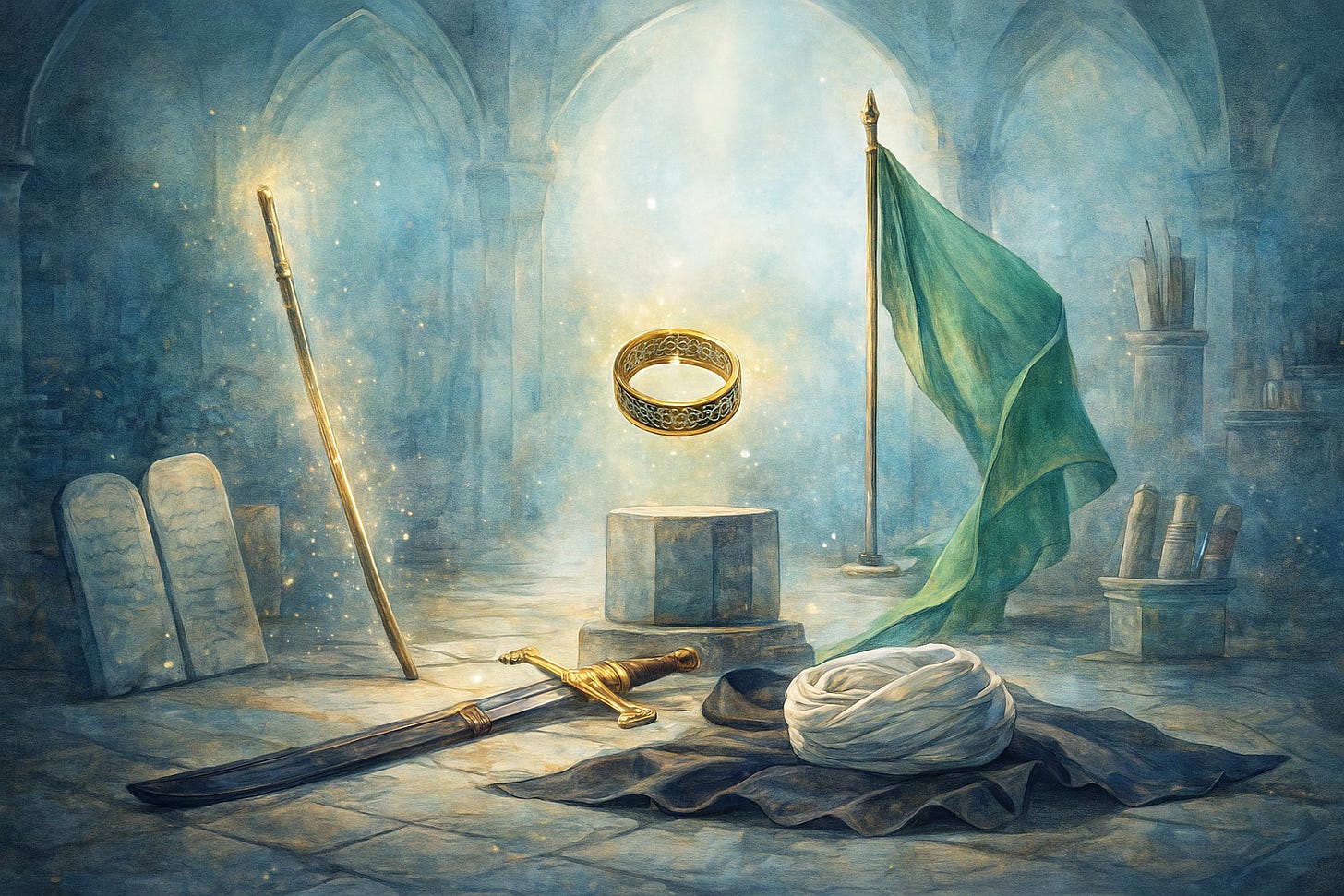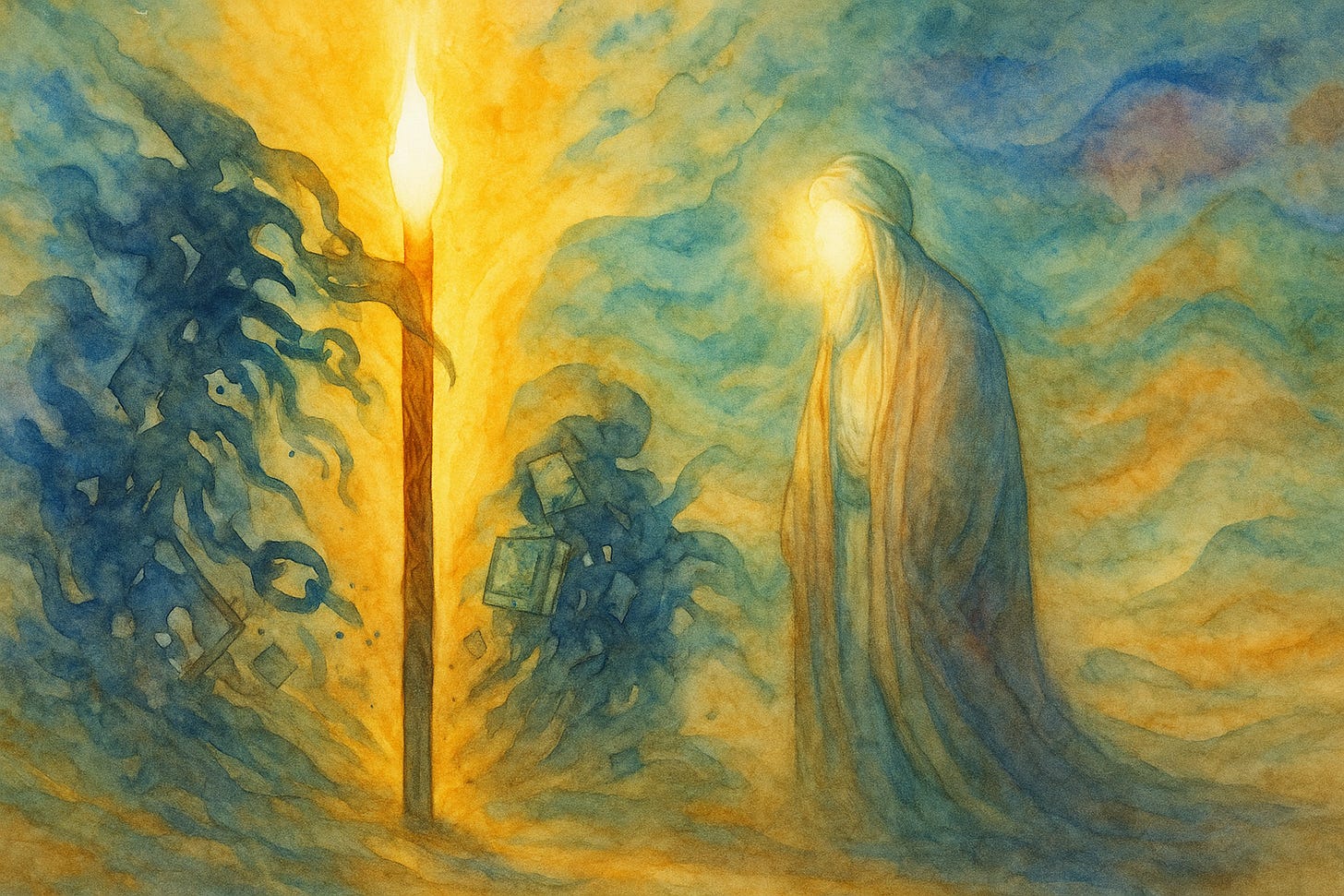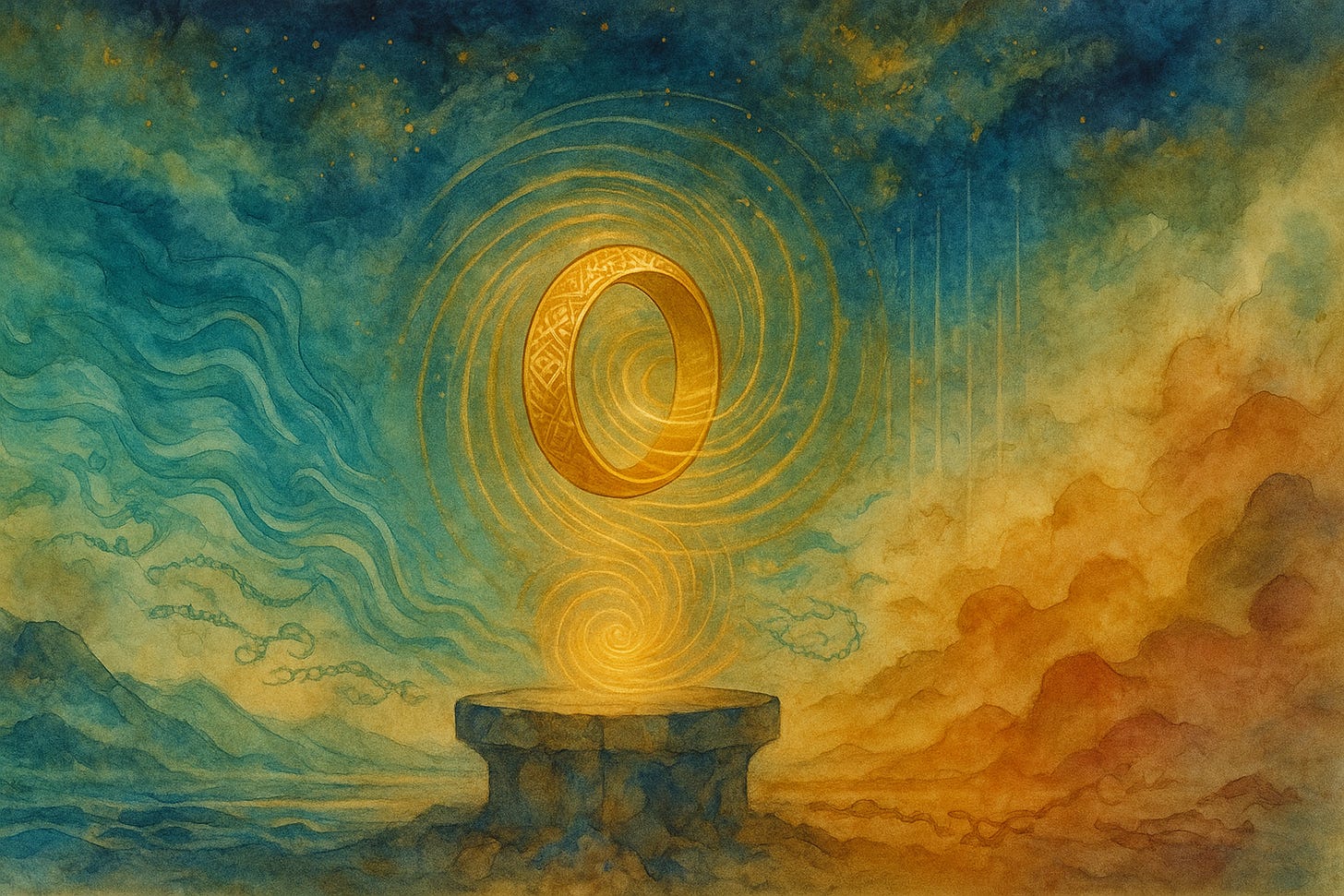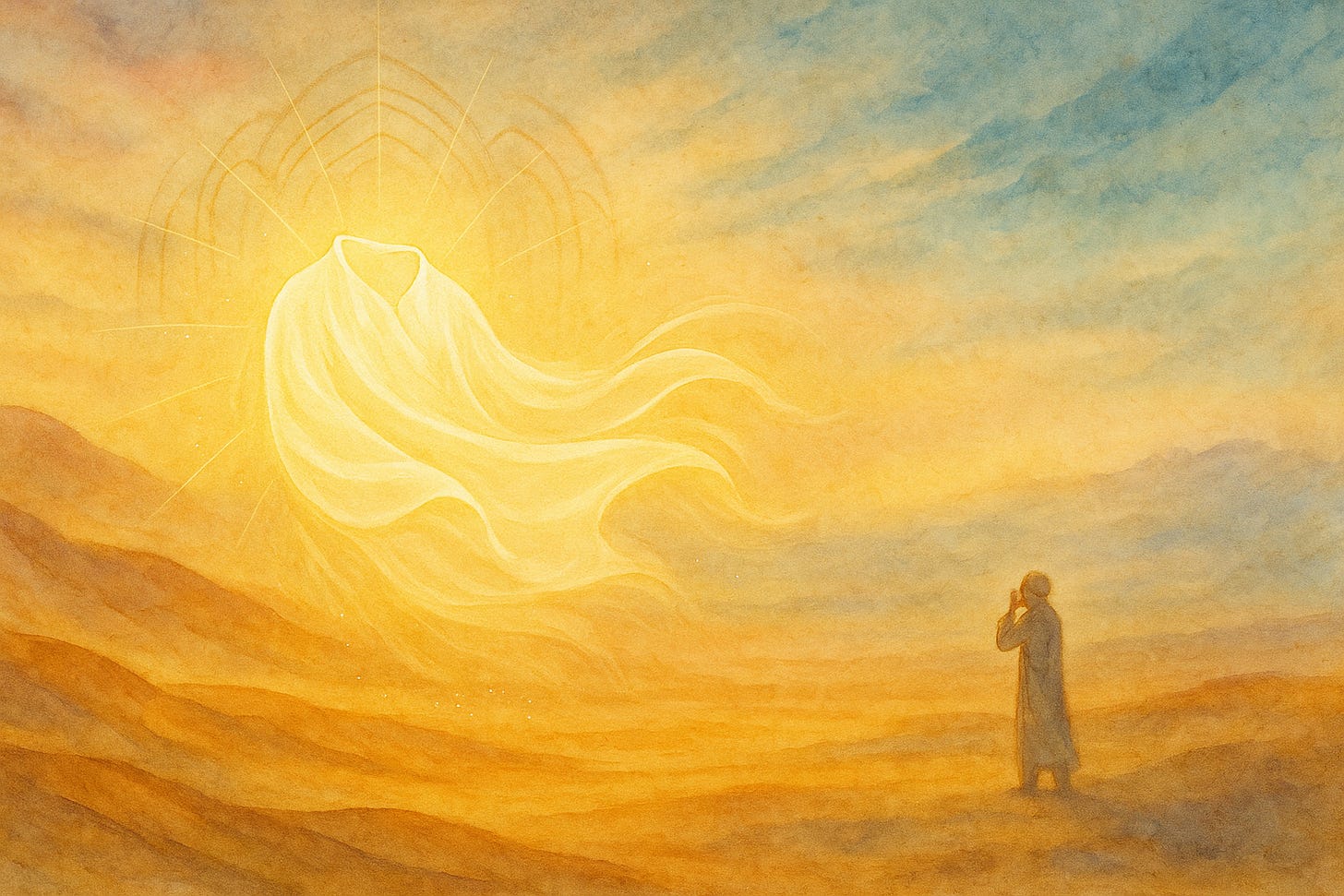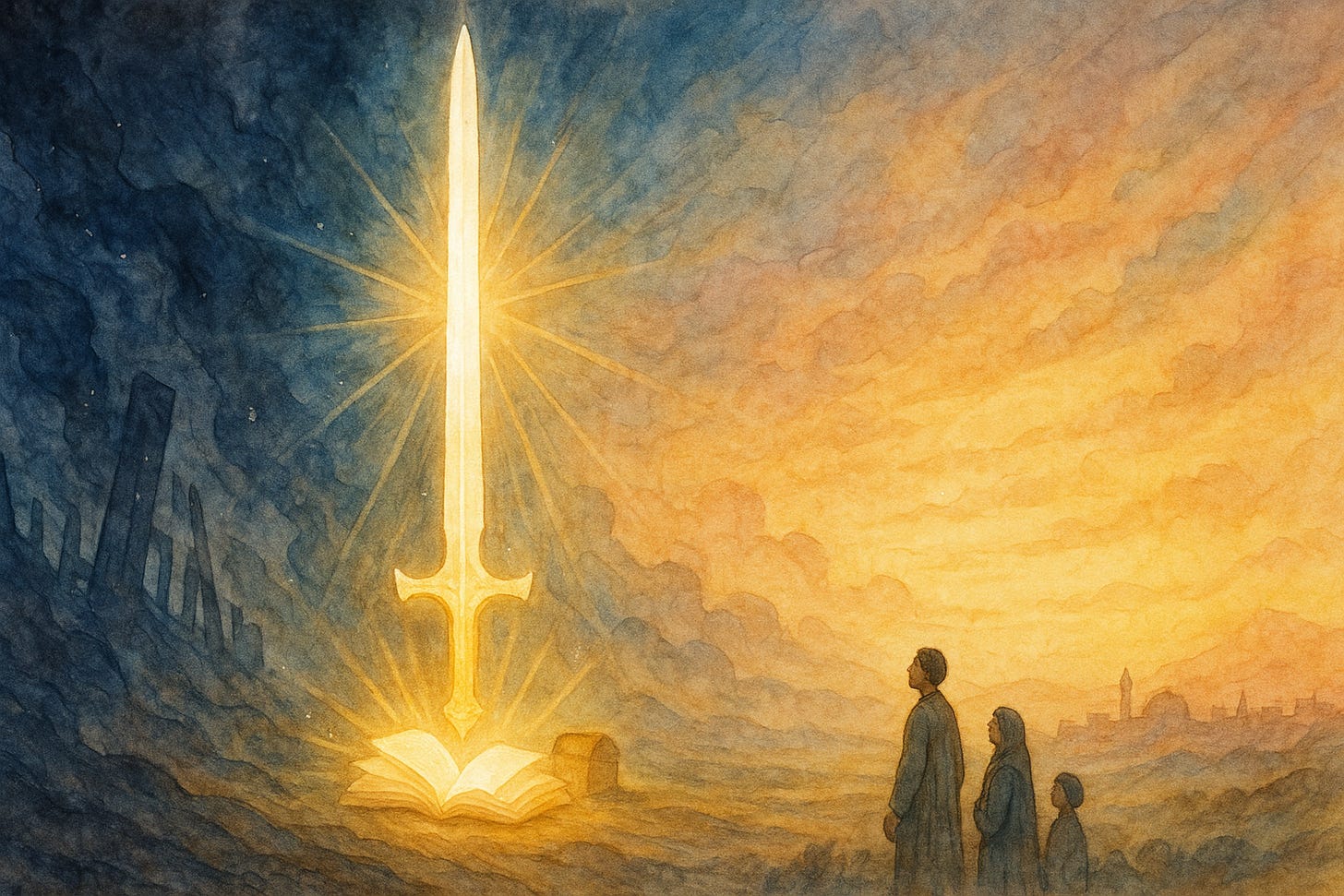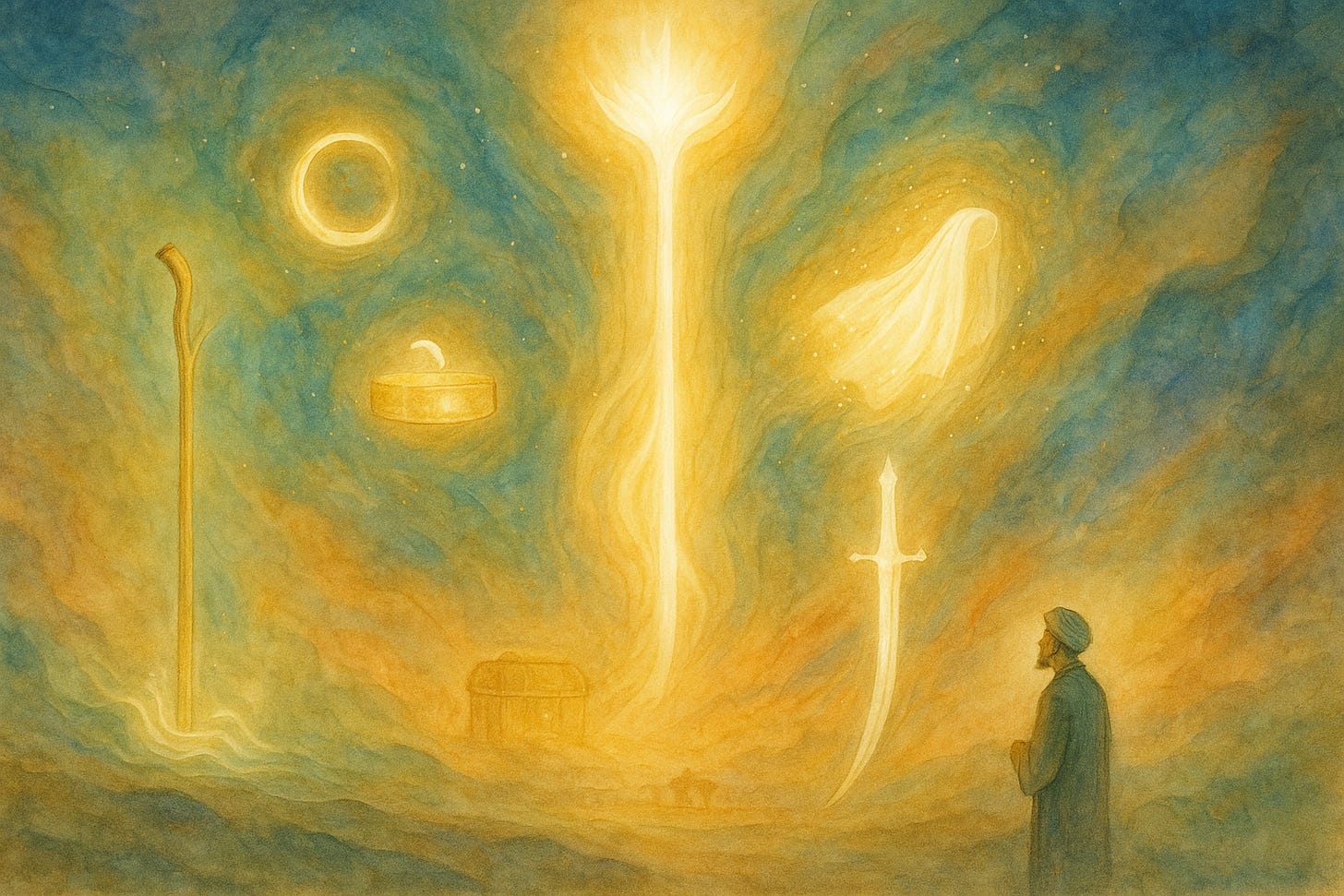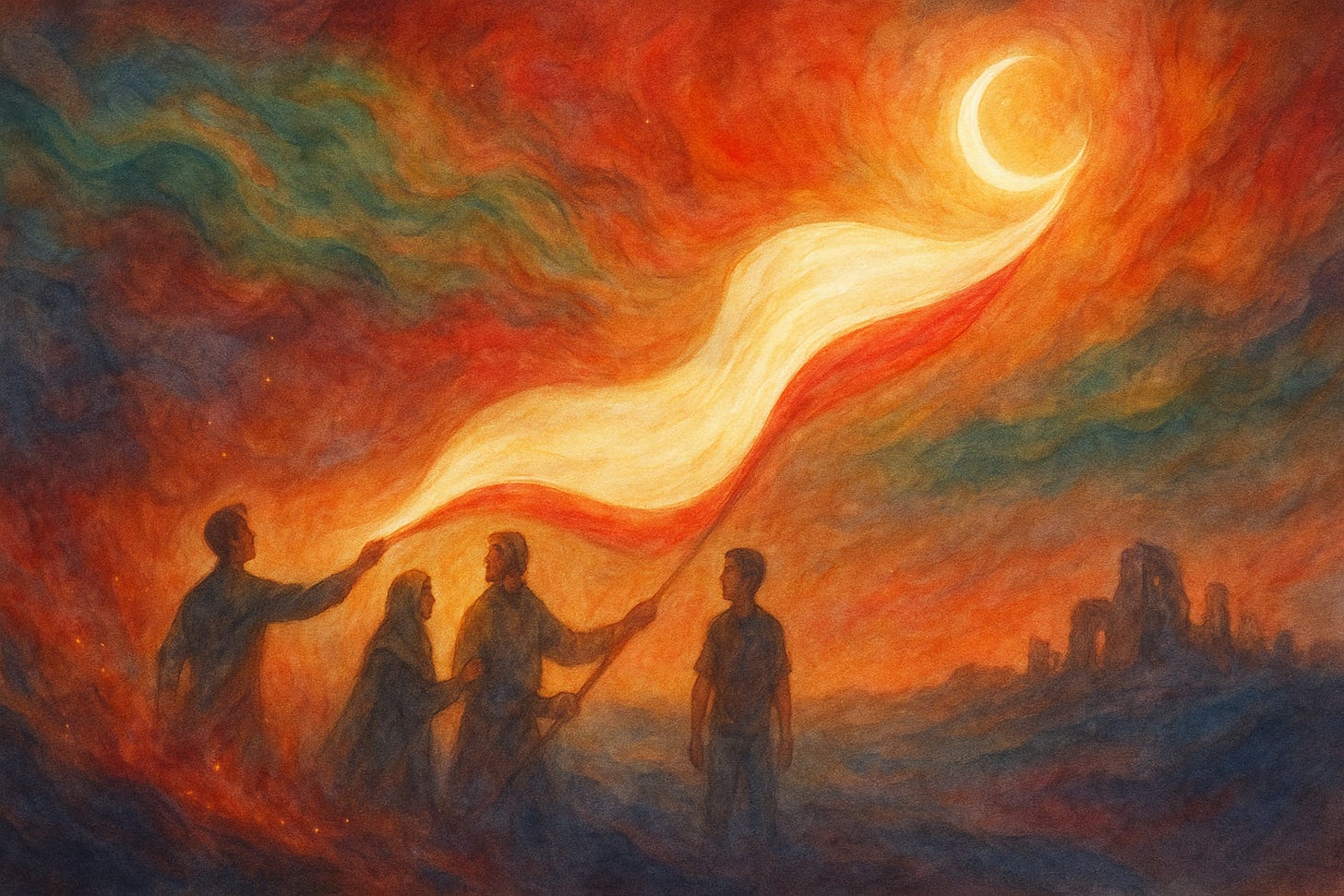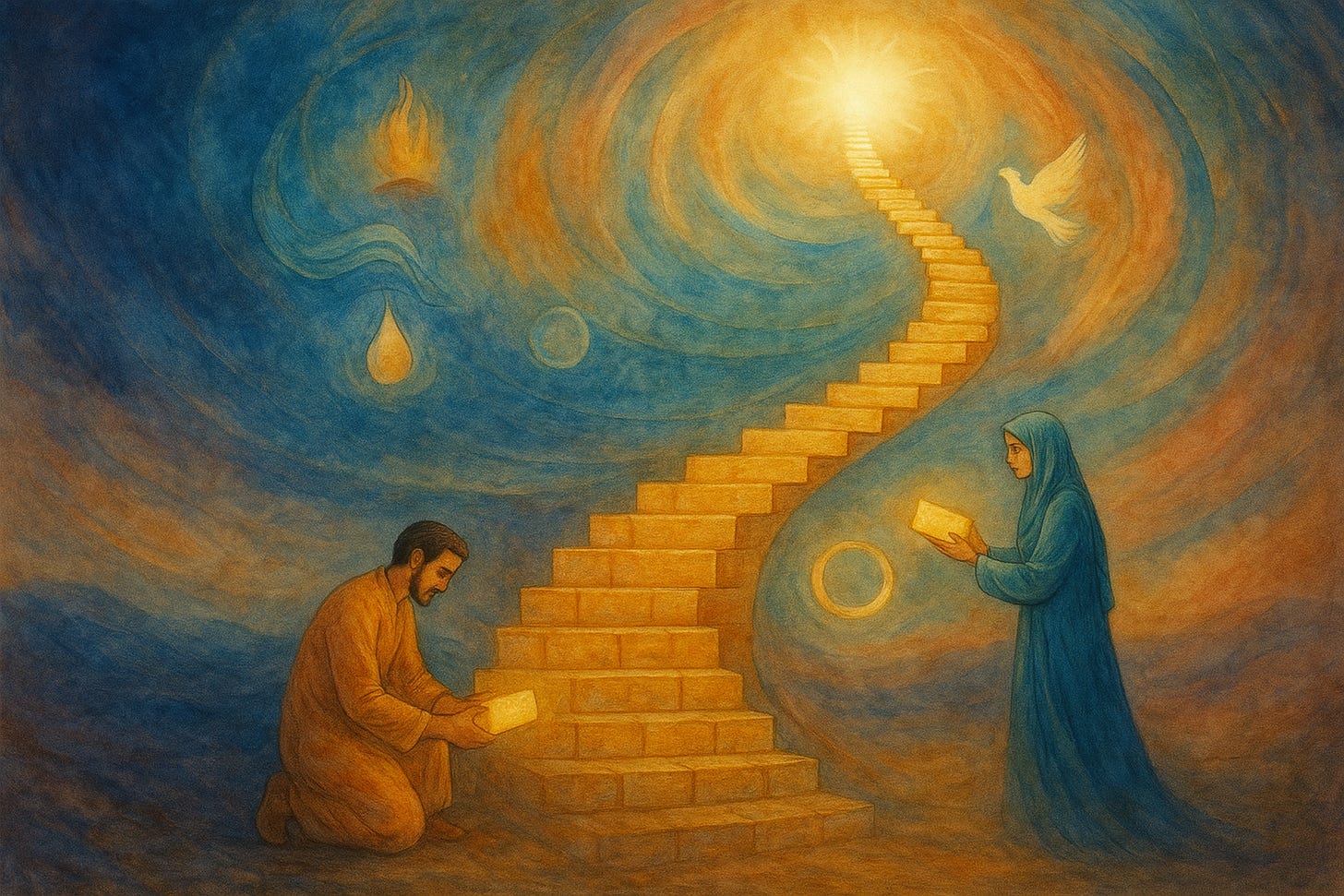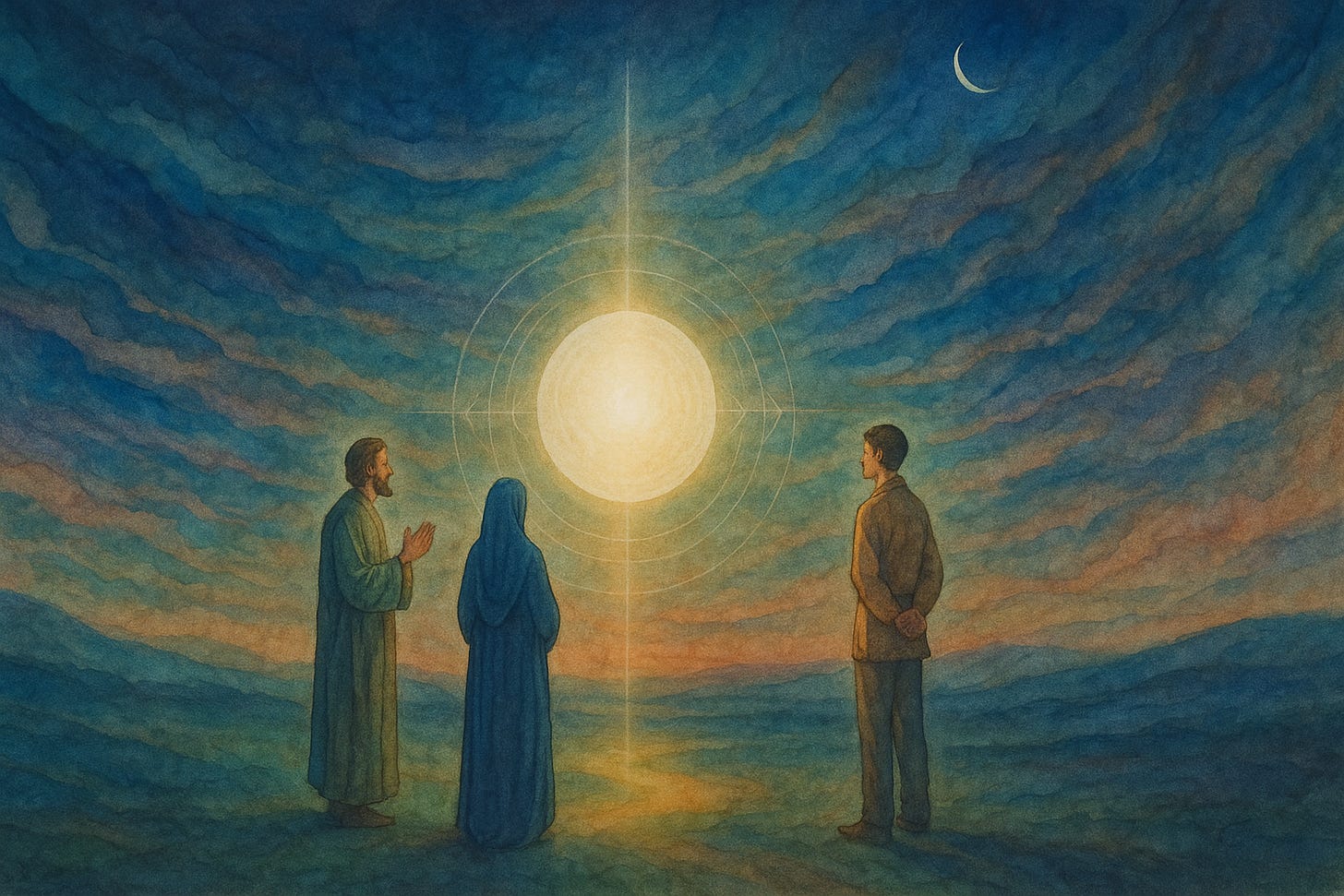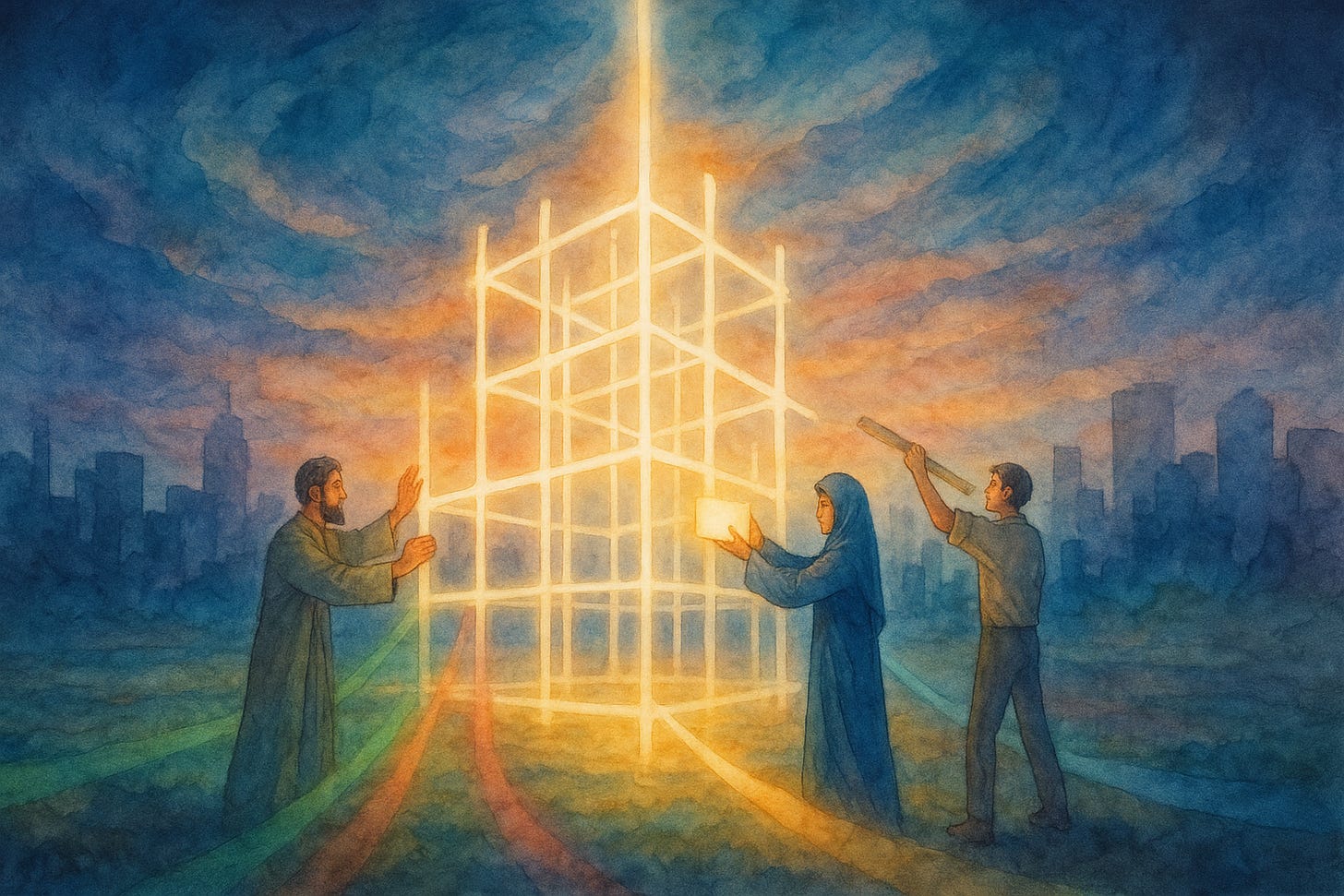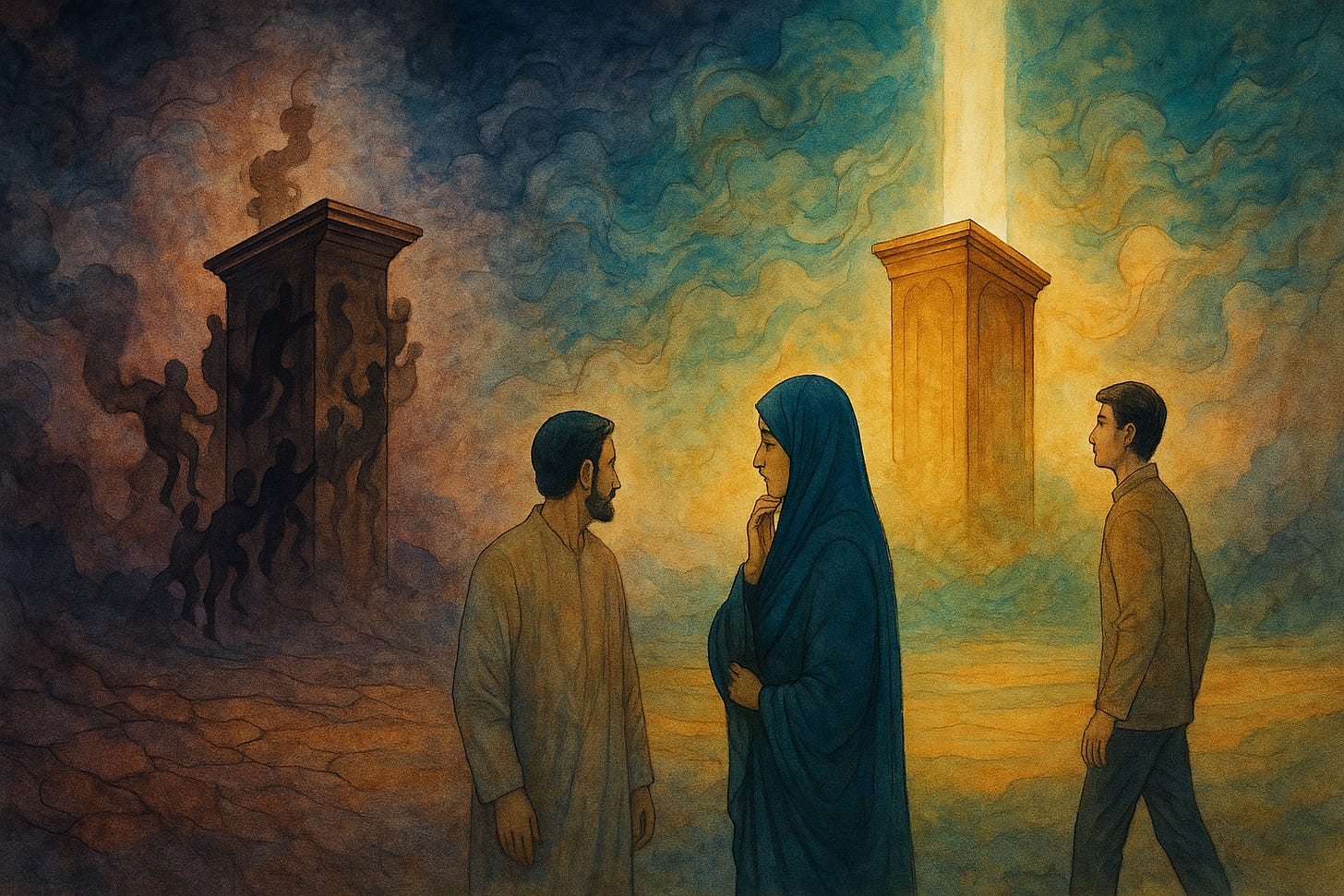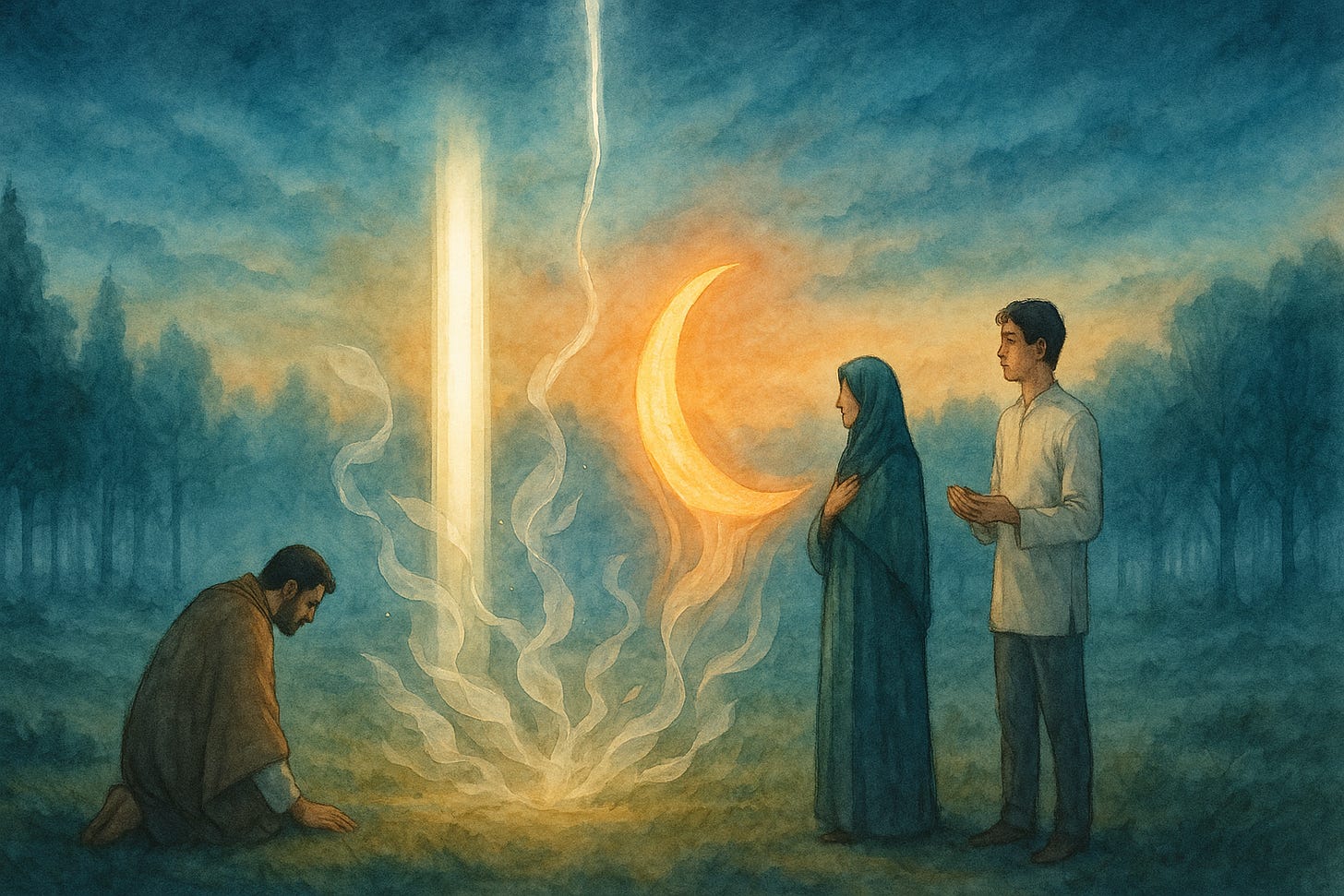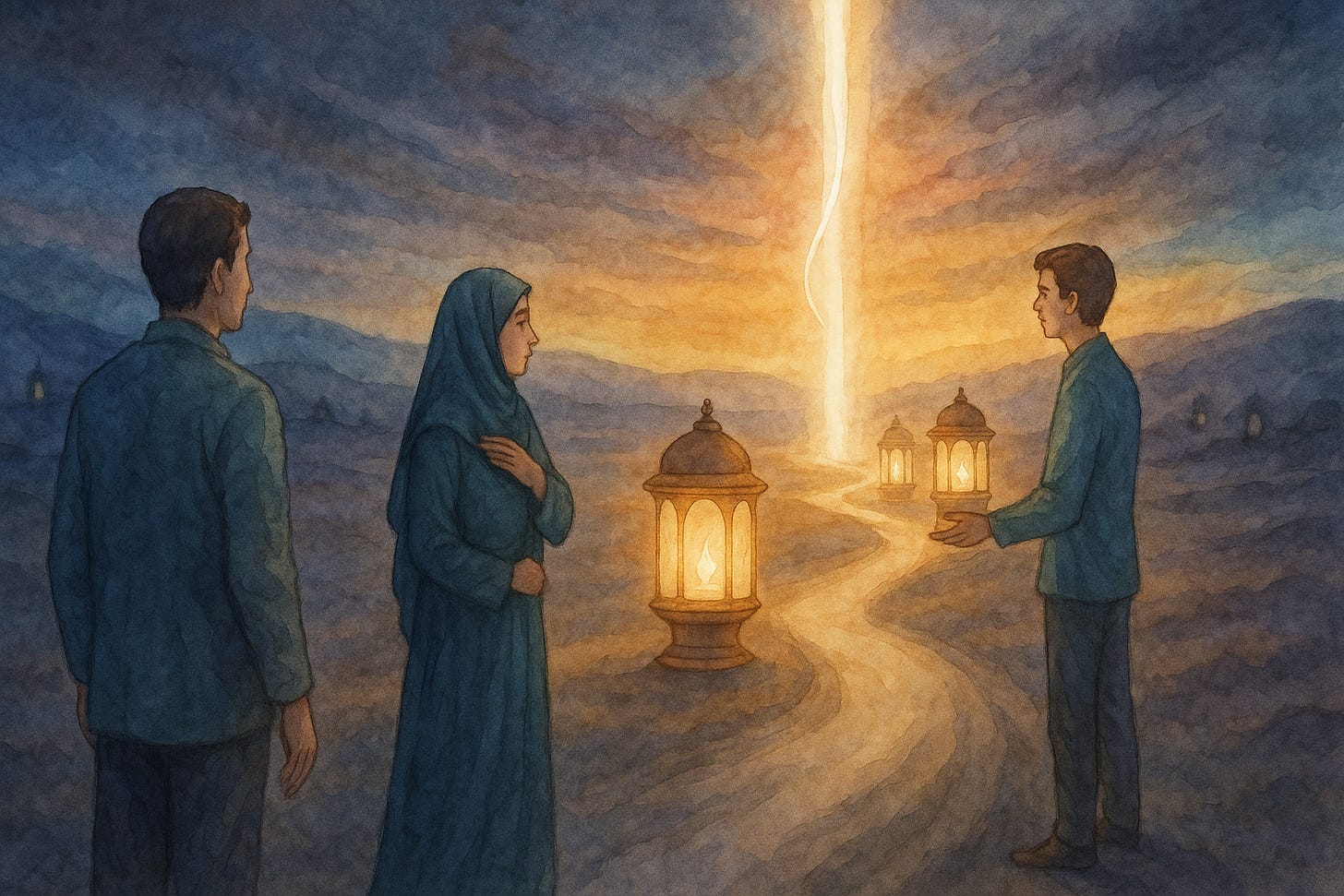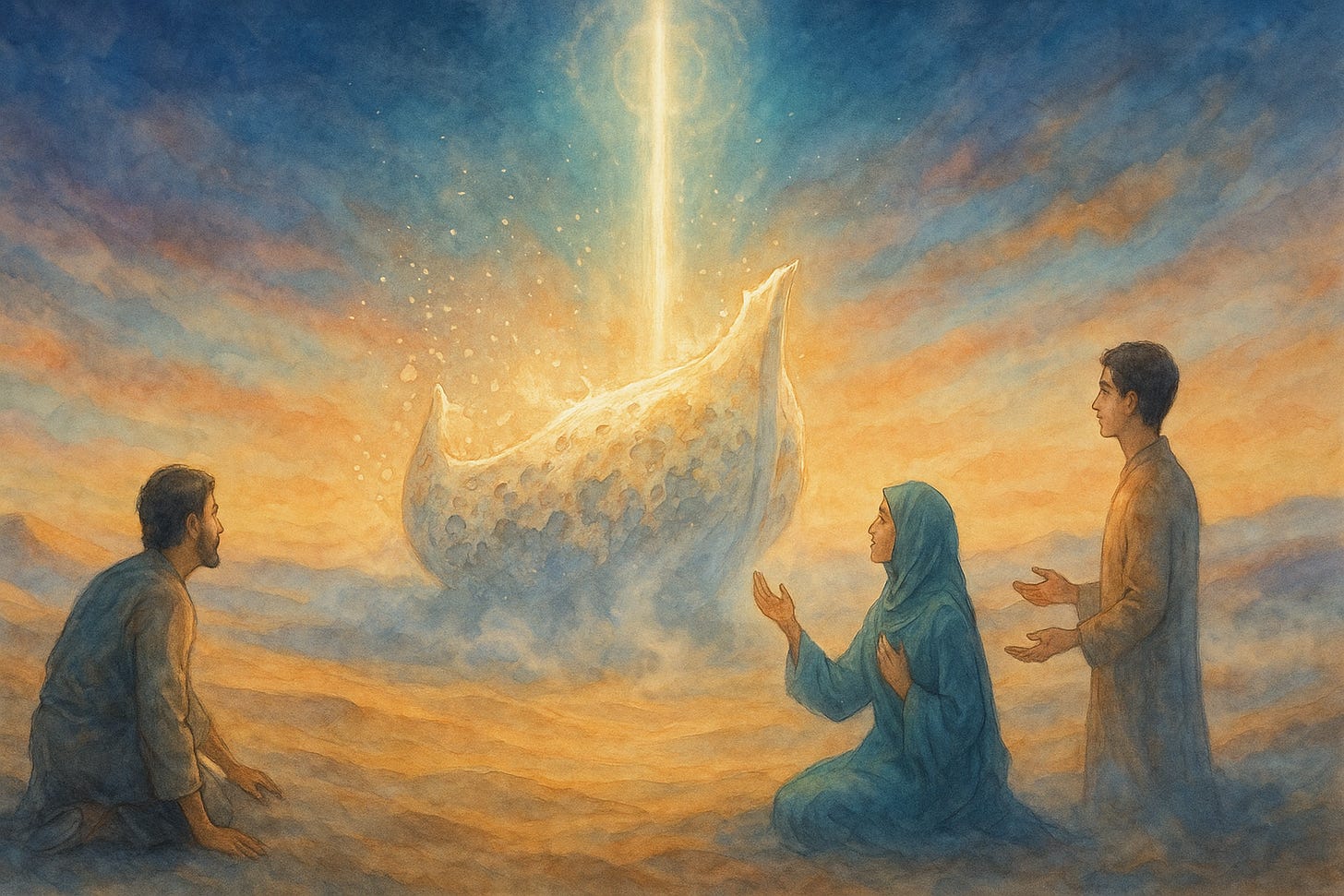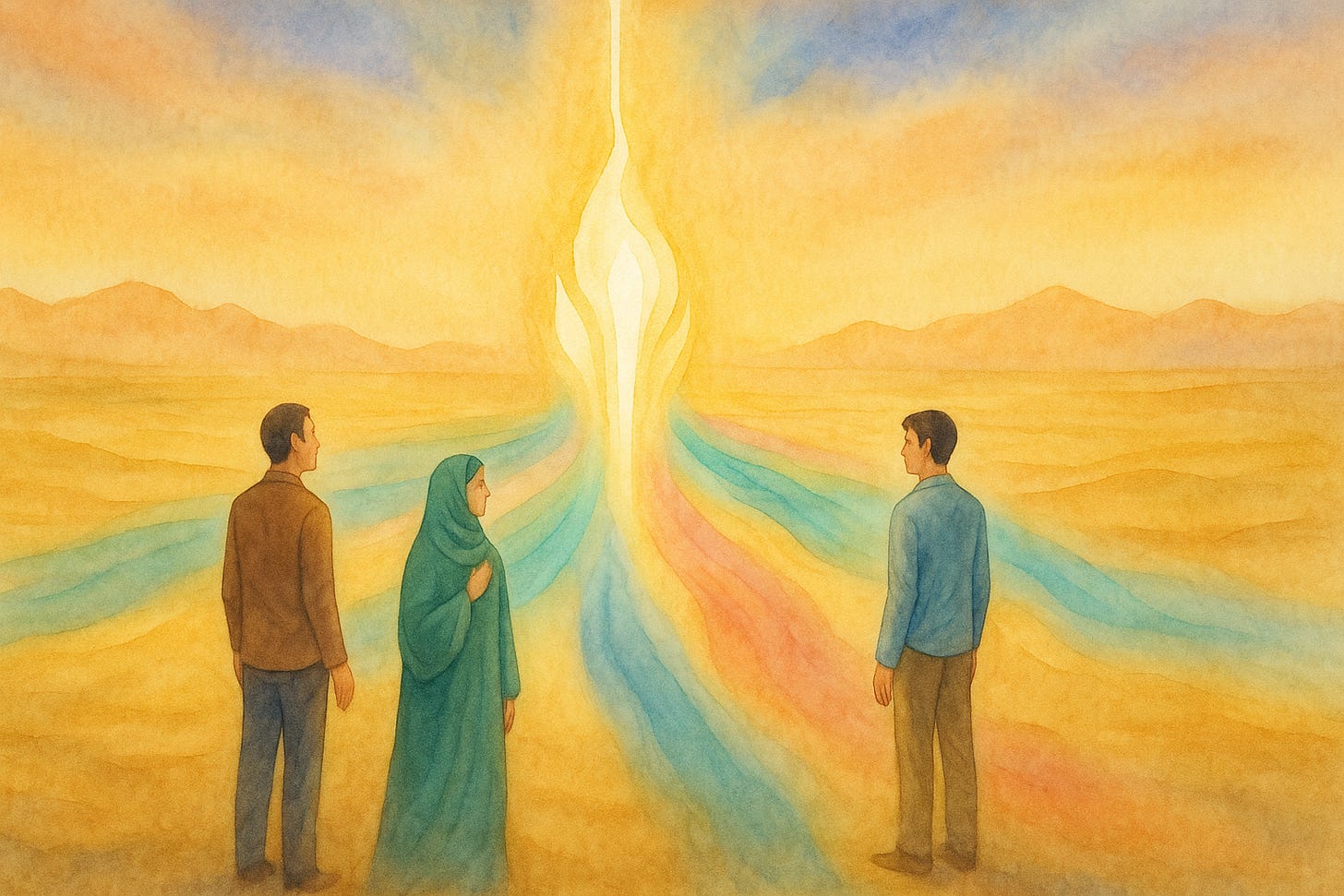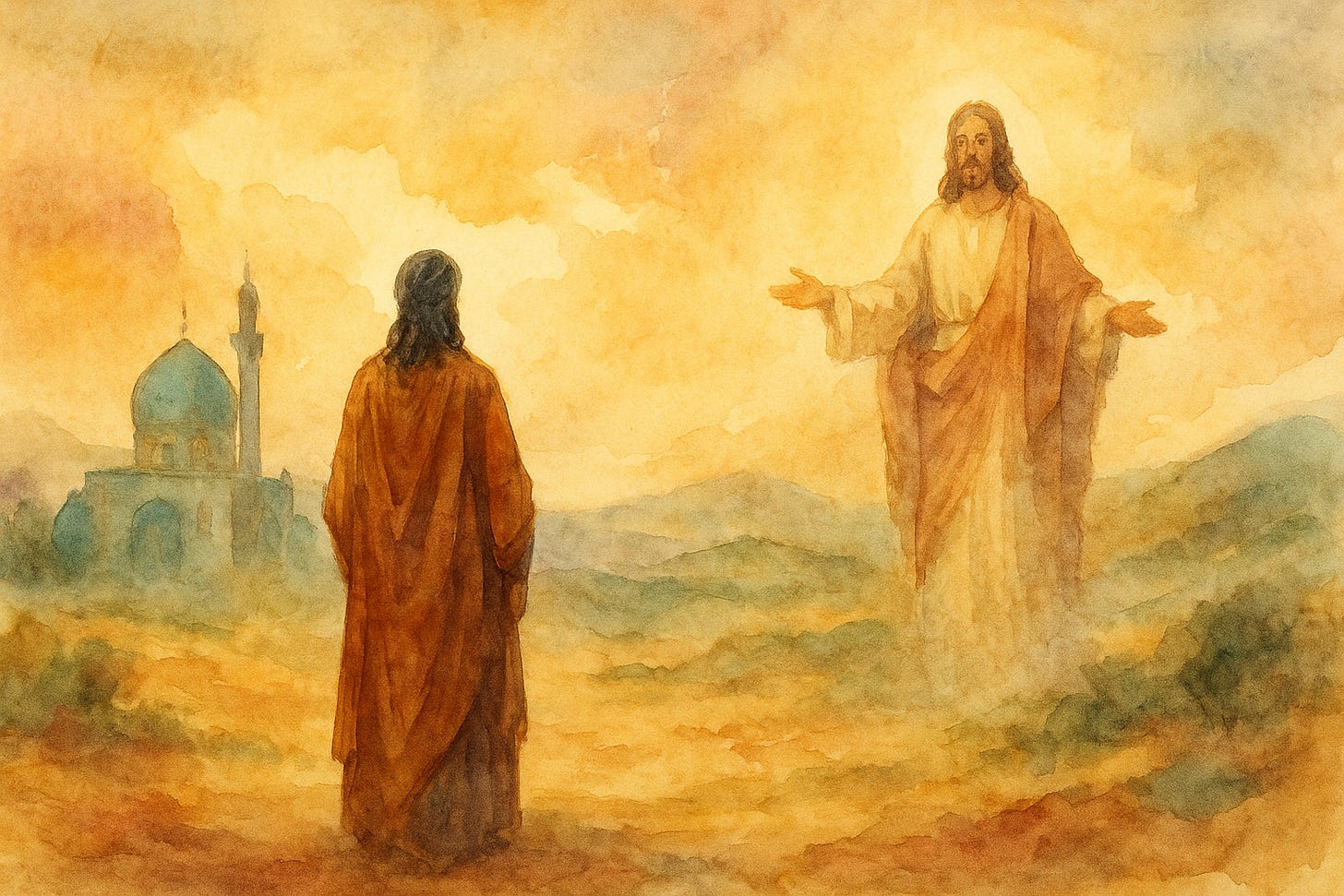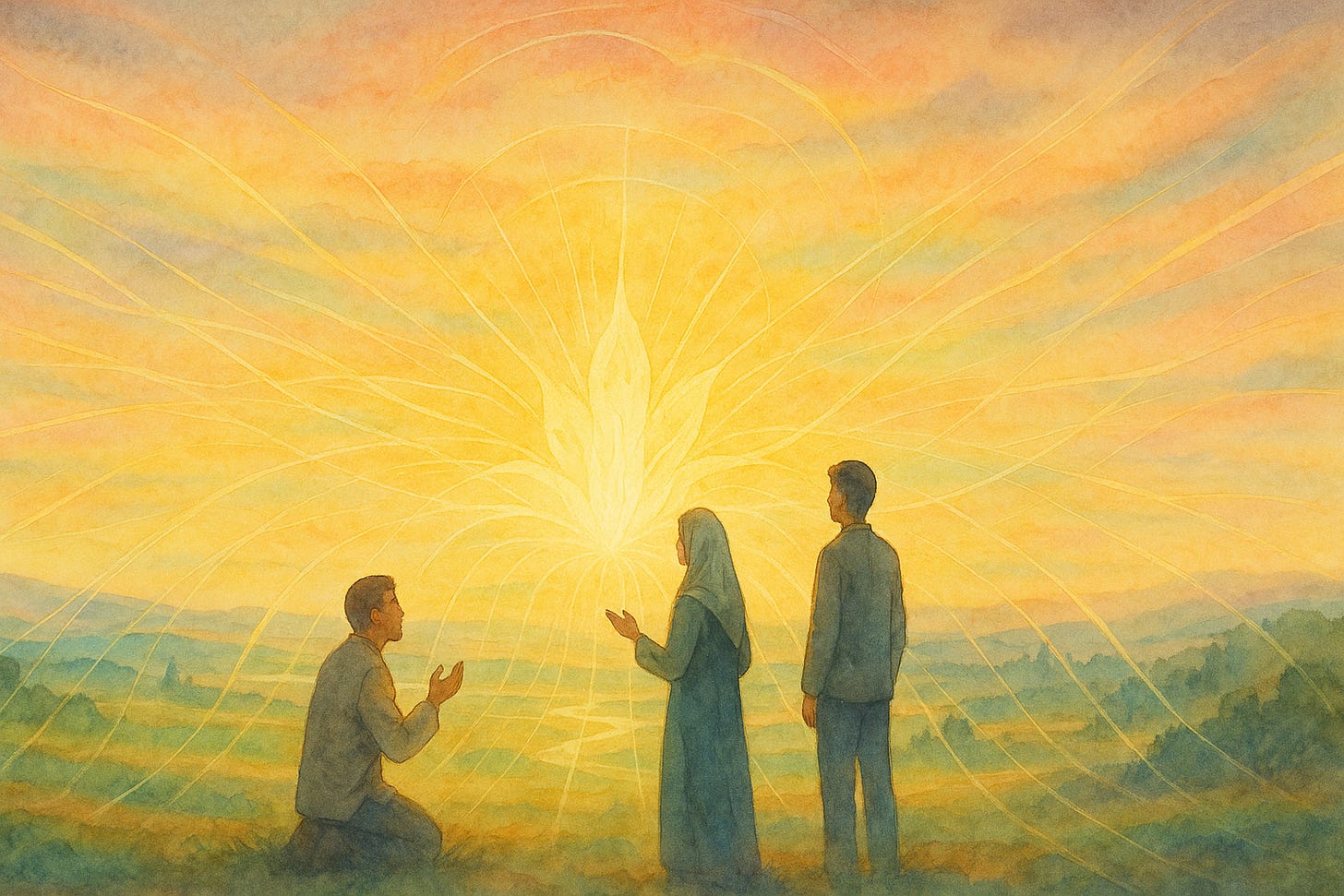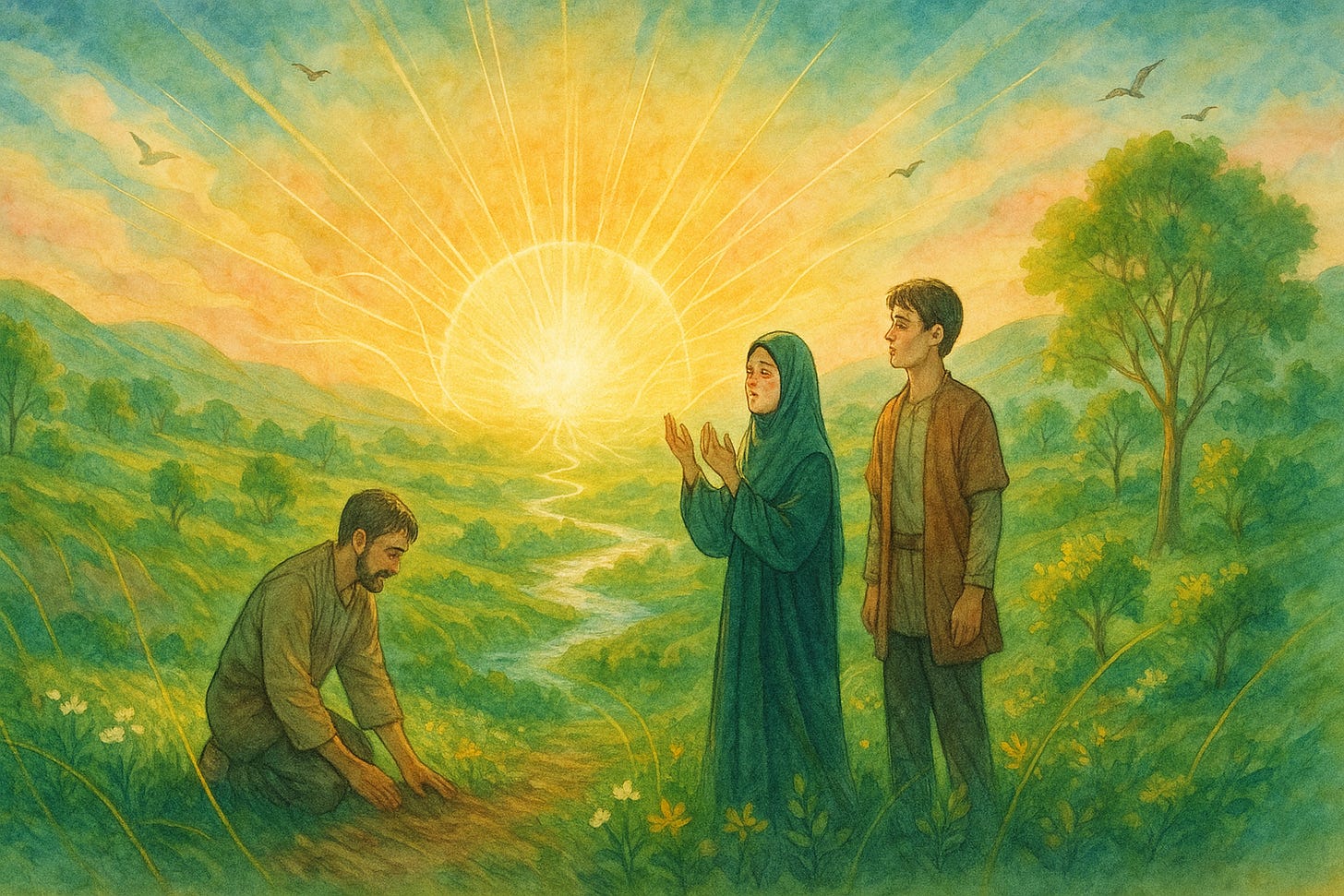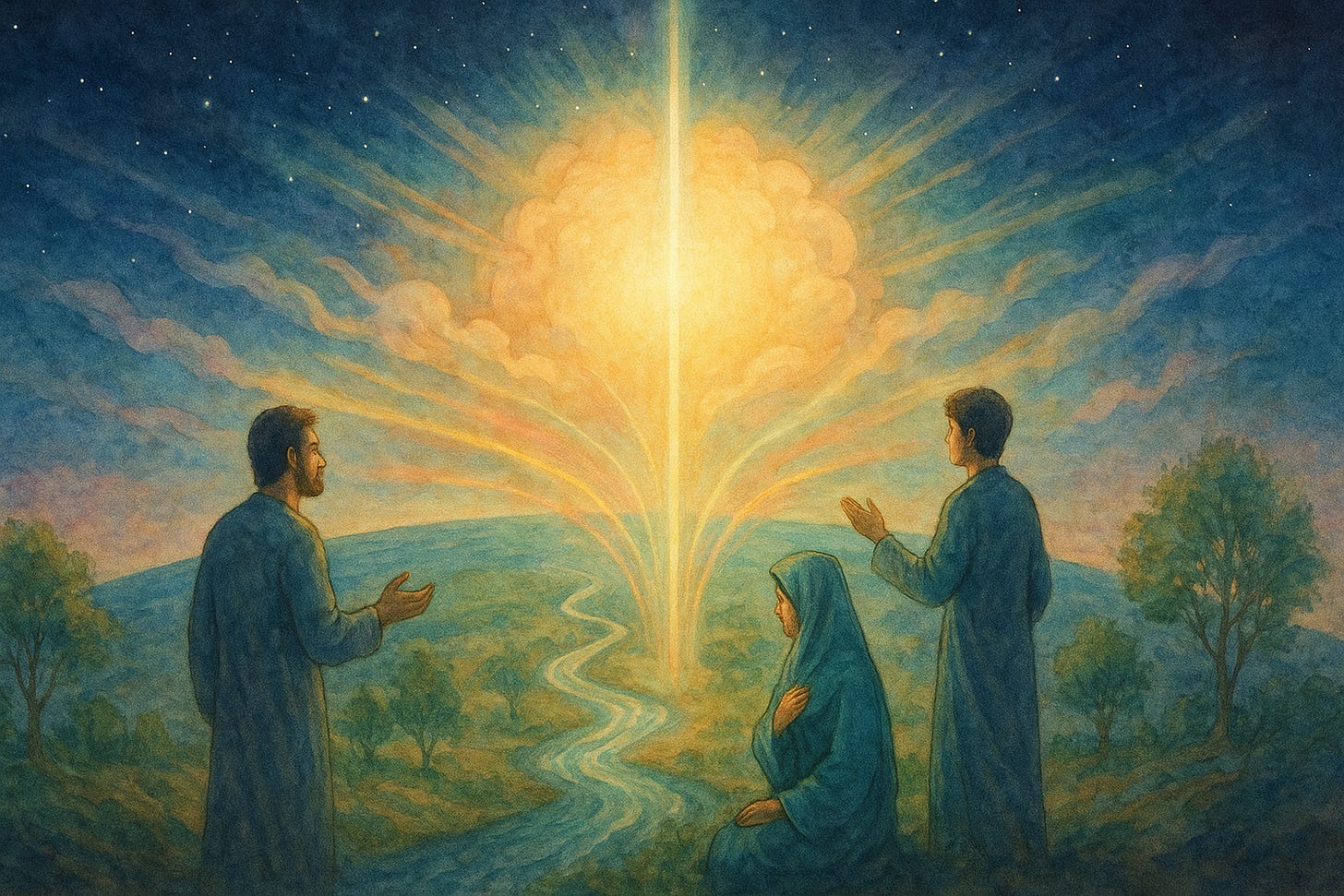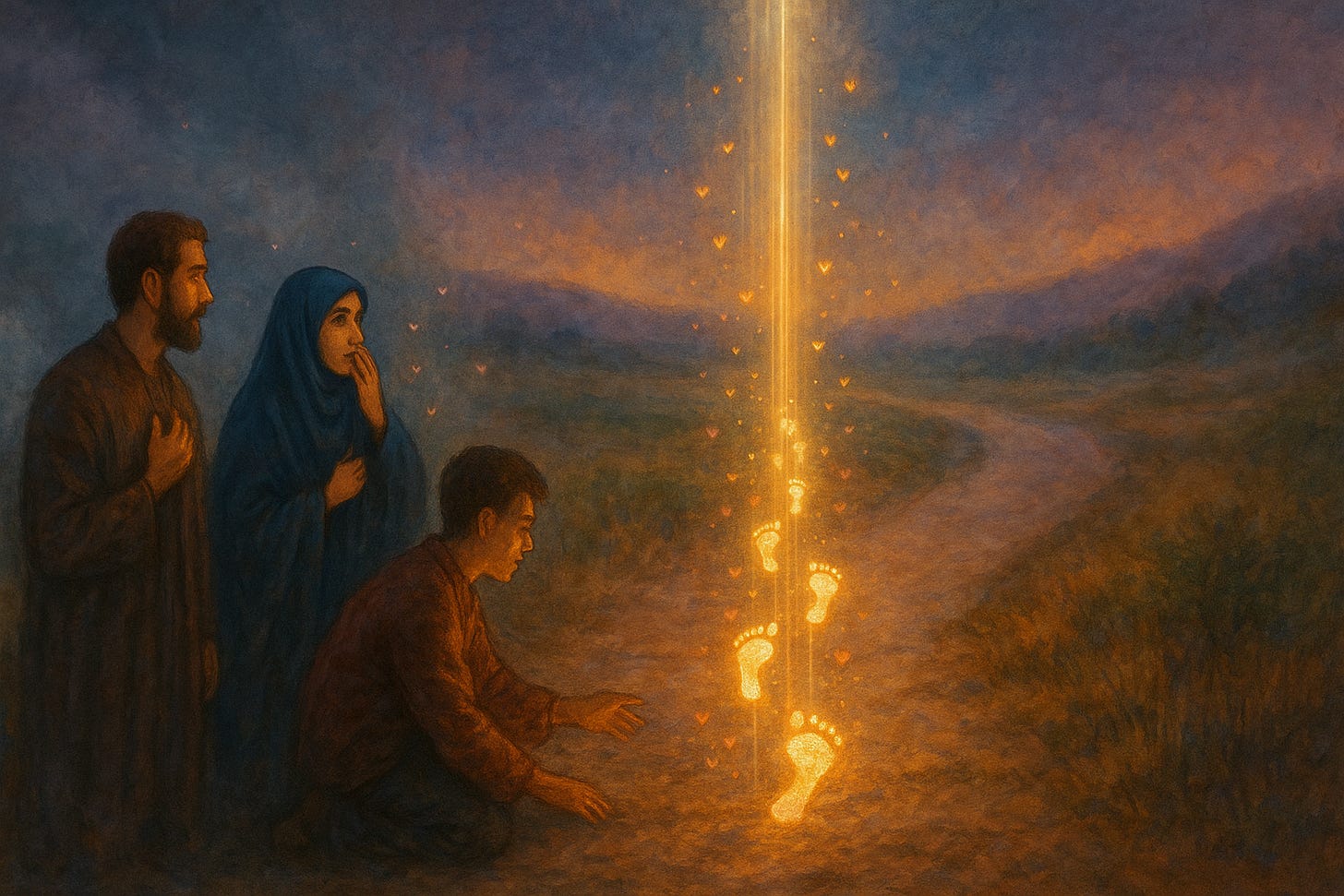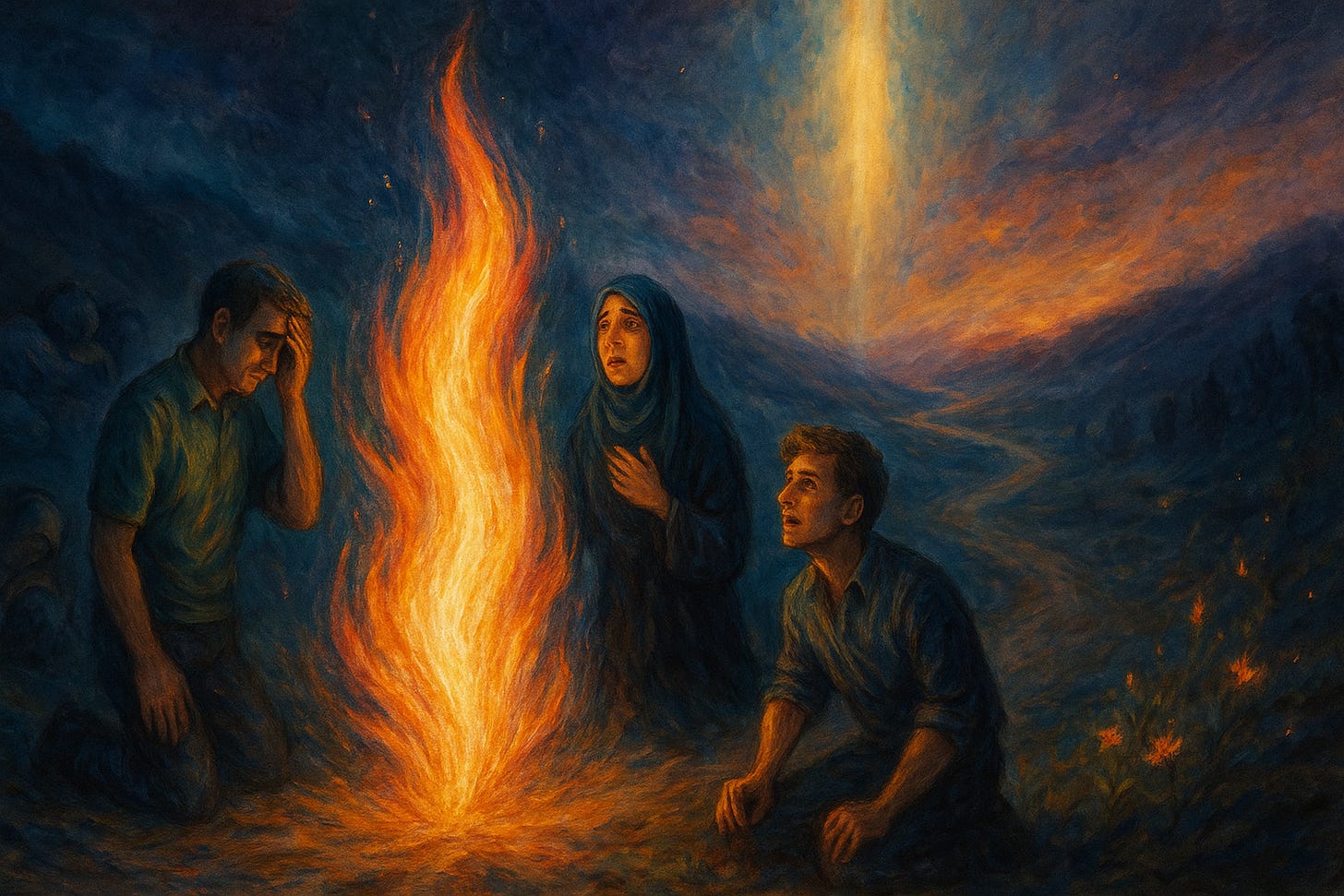[45] Mahdawiyyah (The Culminating Guidance) - Introduction to Mahdawiyyah - Part 1 - The Living Promise: Between Prophecy and Presence
A series of discussions on the teachings of Imam Sadiq (sixth Imam of the Muslims), from the book Misbah ash-Sharia (The Lantern of the Path)
In His Name, the Most High
The Architecture of Faith
A Note for First-Time Attendees
If this is your first gathering with us, we welcome you to what is perhaps the most pivotal discussion in our series.
While tonight’s exploration of Mahdawiyyah can stand as an independent theological truth, its full depth reveals itself when understood as the culmination of the journey we’ve traveled together.
The lives of the Imams we’ve studied—their suffering, their resistance, their preservation of truth—all point toward this moment.
The missions of the prophets we’ve examined—incomplete, interrupted, waiting—all converge in the one who will complete them.
The theological foundations we’ve established regarding Monotheism, Divine Justice, Prophethood, and Imamah form the bedrock upon which tonight’s truths stand.
If you find yourself yearning for deeper context, we encourage you to explore our previous sessions, particularly those on Wilayah and Imamah and the individual Imams.
But even without that background, let tonight plant a seed—for recognising the Mahdi as a living reality rather than a distant hope is itself transformative.
What you may miss in historical detail, you can gain in immediate recognition: the Saviour humanity awaits is not a future promise but a present reality, and understanding this changes everything.
Introduction
As we gather once more around the luminous teachings of the Lantern of the Path, we find ourselves at a profound threshold.
For forty-four sessions, we have journeyed together through the Lantern of the Path, each gathering building upon the last, weaving a tapestry of divine guidance that spans from the first moments of creation to this very breath we share tonight.
We embark today upon a necessary continuation of our theological journey.
Having traversed the foundations of creed, contemplated the mysteries of worship, and having established the structural pillars of Divine Leadership in our sessions on Imamah, we now arrive at the summit of that trajectory.
It is crucial to understand that the study of Mahdawiyyah—The Culminating Guidance—is not an isolated subject, nor is it a mere appendix to Islamic history.
Rather, it is the logical conclusion and the final chapter of the system of guidance we have previously established.
If Imamah is the divinely appointed system required to guide humanity, then Mahdawiyyah is the destination that system was designed to reach.
Tonight, we cross from the foundation of Imamah to the culminating guidance of Mahdawiyyah, from the theoretical framework of divine leadership to the tangible reality of the Leader of our time.
This is not merely a continuation but a culmination, for in studying the Promised One, we study the convergence point of all divine promises, the fruit of every prophet’s prayer, and the answer to creation’s primordial cry for justice.
We stand now at part forty-five of this ongoing series, and as always, we remind ourselves that this is not entertainment but education, not passive listening but active transformation.
Each session demands not just our attention but our commitment to apply what we learn, to be those who don’t merely await the Mahdi but actively prepare for his return.
We implore God, the Most High, for His assistance in understanding these profound truths.
We ask Him to grant us not just knowledge but wisdom, not just information but transformation.
We beseech Him to make us righteous and diligent servants of His final proof, our Master, the Imam of our Time—may our souls be his ransom.
O God, let us never be a source of pain or hurt or sadness to him.
Instead, make us those who bring joy to his blessed heart through our actions, our loyalty, and our preparation.
Make us those who are truly ready—not just in words but in deed—to respond to his call when it comes.
For readiness is not a feeling but a state of being, not a claim but a condition of the soul that manifests in every choice we make.
And in this moment of prayer, we ask:
O God, by the right of Your final proof, grant us the strength to be more than passive waiters.
Make us active preparers, those who work to create the conditions for his blessed return, those who strive to be worthy of being called his helpers and companions.
Recap
Our Journey Through Imamah - From Presence to Seclusion
Before we step into the realm of Mahdawiyyah—the culminating guidance—let us recall the sacred ground we have traversed, for this story cannot be understood without understanding the river of Imamate from which it flows.
It is impossible to grasp the concept of the “End Times” or the “Saviour” without firmly standing upon the intellectual bridge of Imamah.
The Foundation of Sacred Authority
We began our journey, following Prophet Muhammad and the Commander of the Faithful, Imam Ali, with Sayyedah Fatimah al-Zahra, discovering that she was not merely the daughter of the Prophet but the very Mother of Imamah itself—the one through whom the light of wilayah would flow to all humanity.
We learned how her brief life of eighteen years contained within it infinite dimensions of worship, knowledge, and sacrifice.
Her broken rib and the martyrdom of her unborn child Mohsin became the first blood spilled in defence of legitimate leadership. Through her, we understood that Imamah is not just political succession but a cosmic reality, a divine trust that demands everything from those who carry it and those who claim to follow it.
From the Mother of Imams, we moved to her eldest son, Imam Hasan al-Mujtaba, the embodiment of prophetic wisdom and strategic patience.
We witnessed how his peace treaty with Muawiyah was not weakness but strength, not compromise but chess played at the highest level.
Through him, we learned that sometimes the greatest jihad is knowing when not to fight, that preserving the community of believers can require swallowing poison—both literally and metaphorically.
His life taught us that divine leadership adapts its methods but never its principles.
The Preservation of Knowledge
We sat at the feet of Imam Muhammad al-Baqir, the one who split open knowledge itself.
In an era when the memory of the Prophet was being deliberately obscured, he became the fountain from which authentic Islam would flow again.
Through him, we saw how knowledge is not neutral but revolutionary, how teaching the truth is itself a form of resistance.
He showed us that in times of intellectual siege, the preservation and transmission of authentic knowledge becomes the highest form of jihad.
With Imam Ja’far as-Sadiq, we entered the golden age of Islamic sciences.
The Sword of Knowledge and Shield of Prudence taught us that true leadership creates institutions, not just followers.
His establishment of what would become the Shia school of jurisprudence was an act of civilisation-building in the midst of tyranny.
Through his thousands of students, he created an intellectual revolution that no caliph could suppress.
He proved that when political power is denied, intellectual and spiritual authority becomes the battlefield where truth prevails.
We witnessed the patient suffering of Imam Musa al-Kadhim, the Prisoner of Baghdad, who spent years in the dungeons of Harun al-Rashid (al-Abbasi).
Through him, we learned the power of dignified resistance, how a man in chains can be freer than his jailer, how loyalty is tested not in comfort but in crisis.
His life became a masterclass in maintaining faith when the whole world system is arranged against you.
The Divine Preparation for Occultation
We made pilgrimage to Sayyedah Fatimah al-Ma’soumeh, whose journey to find her brother became the foundation of a city of knowledge.
Through her, we understood that the women of the Ahl al-Bayt are not merely supporters but active participants in the divine mission, that a sister’s love can transform geography itself, turning Qom into the fortress of learning it remains today.
Now we must understand the historical prelude—how the trajectory of the Imamate immediately preceding the Mahdi reveals the Divine plan.
Starting with Imam Muhammad al-Jawad, who assumed the Imamate at eight years old, the community was tested on their ability to submit to a Divine Proof regardless of conventional expectations.
This child-Imam shattered every understanding of leadership, proving that when God appoints, He also empowers.
His Hirz became our spiritual fortress, teaching us that true protection comes not from walls but from absolute reliance on the Divine.
This trial intensified during the eras of Imam Ali al-Hadi and Imam Hasan al-Askari.
By moving these Imams to the military garrison of Samarra and placing them under severe house arrest, the ruling powers inadvertently facilitated a Divine preparation for the Occultation (Ghaybah).
Imam Ali al-Hadi spent twenty years under surveillance yet produced the most comprehensive charter of wilayah in our tradition—the Ziyarah al-Jami’ah al-Kabirah.
He proved that you can imprison a body but never a mission, that physical walls cannot contain spiritual authority.
The restrictions of Samarra were the training ground for the Greater Occultation.
The believers were conditioned to follow an Imam they could not physically see, relying instead on the network of representatives (Wikala) and written correspondence.
The community learned a vital lesson that serves us today: the authority of the Imam is not contingent upon his physical visibility, but upon his Divine appointment.
Through all these luminous lives, we discovered patterns that would prepare us for what was to come.
Each Imam faced increasingly sophisticated forms of oppression, yet each developed new methods of resistance and preservation.
They were building something—a structure that could survive the unthinkable: the physical absence of the divine proof.
The Divine plan gradually shifted the community from an era of direct access to an era of mediated guidance.
The Theological Necessity of the Living Imam
With the martyrdom of Imam al-Askari, the earth stood on the precipice of a theological crisis.
However, the Mercy of God dictates that the earth is never left devoid of a Divine Guide. The connection between the Heavens and the Earth is a constant stream of grace (faydh), and that stream requires a receiver—a perfect human conduit—to anchor it.
The Imam is the heart of the created universe.
Just as the physical body cannot survive without a beating heart, the earth cannot survive without a Divine Proof (Hujjah) upon it.
This is not merely a matter of political administration or social justice; it is a cosmic law.
The deprivation of the Infallible would result in the collapse of the natural order.
We find this foundational truth solidified in the authentic narrations of the School of Ahl al-Bayt:
لَوْ لَا الْحُجَّةُ لَسَاخَتِ الْأَرْضُ بِأَهْلِهَا
“Had it not been for the Proof (Hujjah), the earth would have surely swallowed its inhabitants.”
— Al-Kulayni, Al-Kafi, Volume 1, Page 179, Hadith 10
Therefore, when we discuss the Mahdi, we are not discussing a distant hope or a theoretical figure to be born in a future epoch.
We are discussing a necessity for the present.
To deny his existence in this moment is to argue that God has abandoned His creation and severed the link between Creator and creature—a proposition that is theologically impossible.
The Mahdi is the fulfilment of the promise given to Adam, the realised prayer of Abraham, and the living legacy of the Seal of the Prophets.
He ensures that the banner of guidance, passed from hand to hand throughout human history—and preserved through the difficulties of Samarra—never falls into the dust.
The Transformation of Waiting
The Imams taught us that leadership is not about commanding from thrones but about serving from whatever position God places you in.
They showed us that every form of oppression creates its own form of resistance, that truth finds a way to flow even when all apparent channels are blocked.
They demonstrated that the arc of history truly does bend toward justice, but it requires conscious actors to do the bending.
Most importantly, they prepared us to recognise that Imamate doesn’t end—it transforms.
The river doesn’t dry up—it goes underground, flowing beneath the surface of history, waiting for the moment when it will burst forth again with such force that it will reshape the entire landscape of human existence.
This is where we stand now—at the edge of understanding not just leadership but salvation itself, not just the guides but the destination toward which they have been guiding us.
The story of Imamah has prepared us to understand Mahdawiyyah, for how can we comprehend the significance of the Hidden Imam if we haven’t understood the magnificent tradition from which he emerges?
Tonight, we begin to explore what it means when divine leadership doesn’t disappear but becomes concealed, when the sun doesn’t set but becomes hidden behind clouds, continuing to provide light even when we cannot see its source directly.
We begin to understand that the Occultation is not God’s abandonment of humanity but perhaps His greatest test and His most profound mercy—forcing us to internalise the teachings, to become worthy of the return, to transform waiting from a passive state into an active preparation.
The Imams we have studied were not just teaching us history; they were preparing us for our present reality.
Every lesson they taught, every sacrifice they made, every institution they established was pointing toward this age—the age of waiting that is actually the age of preparing, the age of absence that is actually the age of profound presence, the age of Mahdawiyyah.
Now we embark on this new phase of our journey, carrying with us all the light we have gathered from the lives of our Imams.
For in understanding them, we begin to understand him—the one who carries all their qualities, embodies all their perfections, and will complete all their missions.
The one for whom we pray in every prayer, the one whose return will validate every sacrifice made and every tear shed in the path of truth.
This is our transition from Imamah to Mahdawiyyah—from learning about leadership to understanding salvation, from studying the guides to comprehending the destination, from reflecting on the past to actively building the future.
May God grant us success in this endeavour,
may He open our hearts to these truths,
and may He make us among those who don’t just wait for the Mahdi but work for him,
who don’t just long for his return but strive to be worthy of it.
Mahdawiyyah (The Culminating Guidance) - Introduction to Mahdawiyyah - The Living Promise: Between Prophecy and Presence
The Living Witness
Having established the theological necessity of the Imam, we must now distinguish between humanity’s abstract hope and our concrete reality.
The Universal Yearning
It is an undeniable truth that the expectation of a Saviour is not unique to the Shia, nor even to Islam.
It is a universal yearning etched into the spiritual DNA of humanity—a primordial memory of divine promise that refuses to be erased.
Survey the landscape of world religions and you find this golden thread:
The Zoroastrians await their Saoshyant, the beneficent one who will renovate the world
The Jews await their Mashiach, son of David, to rebuild the Temple
The Christians await the Parousia, the return of Christ in glory
The Hindus speak of Kalki, the tenth avatar who ends the age of darkness
Even secular philosophies dream of utopia, the perfect society that emerges from history’s contradictions
Our Sunni brethren too await a Reformer, the Mahdi who will emerge at the End of Time.
Humanity, in its collective conscience, understands that the story of the world cannot end in tragedy; it must culminate in justice. The arc of existence itself demands resolution.
But here lies the profound divergence—the chasm between hoping and knowing, between waiting for birth and recognising presence.
From Concept to Companion
For most of humanity, this Saviour remains a concept—a theological proposition, a future possibility, a blank canvas upon which they project their hopes.
They wait for an idea to take flesh, for a prophecy to begin, for history to produce its hero.
The School of Ahl al-Bayt stands upon entirely different ground.
We do not worship a hypothesis.
We do not await conception but revelation.
We are not anticipating arrival but return.
Consider the profound difference:
Others say: “One day, someone will be born”
We say: “He walks among us now”
Others say: “God will send a saviour”
We say: “God has sent him; we await his command”
Others say: “The world will produce its reformer”
We say: “The reformer grieves for the world’s refusal to reform”
This is not merely semantic—it is the difference between abstraction and encounter, between theory and relationship.
We speak not of a someday-saviour but of our contemporary, our witness, our living Imam who shares our epoch, breathes our air, and carries our sorrows.
The Weight of Witnessed Lives
This distinction transforms everything.
When you believe the Mahdi is a future event, your present conduct carries no immediate witness.
Your sins are abstract, your struggles unobserved, your victories uncelebrated by the one who matters most.
But when you understand that he is al-Shahid—the Witness—every moment becomes charged with meaning.
As our traditions tell us:
إِنَّ الْإِمَامَ يَرَى أَعْمَالَكُمْ وَيَعْرِضُ عَلَيْهِ
“Indeed, the Imam sees your deeds, and they are presented to him.”
— Al-Majlisi, Bihar al-Anwar, Volume 23, Page 345
Imagine the weight of this reality: when you stand for prayer at dawn, fighting sleep, he witnesses your struggle.
When you lower your gaze from the haram, he sees your jihad.
When you fail and fall into sin, his blessed heart grieves.
When you rise again in repentance, he rejoices.
We are not performing for a future audience but for a present observer.
This is why the great mystic and jurist Ayatullah Bahjat would weep when speaking of the Imam’s sorrow—not abstract sorrow for humanity’s condition, but the specific, personal sorrow of witnessing his followers’ struggles and sins in real-time.
Scripture’s Convergent Testimony
This truth—that the righteous shall inherit the earth—echoes across all divine revelations.
The Psalms of David declared it in Hebrew:
צַדִּיקִים יִירְשׁוּ־אָרֶץ וְיִשְׁכְּנוּ לָעַד עָלֶיהָ
“The righteous shall inherit the land, and dwell therein forever.”
— Old Testament, Psalms 37, Verse 29
The Qur’an confirms this ancient promise, making it universal and eternal:
وَلَقَدْ كَتَبْنَا فِي الزَّبُورِ مِن بَعْدِ الذِّكْرِ أَنَّ الْأَرْضَ يَرِثُهَا عِبَادِيَ الصَّالِحُونَ
“And We have written in the Psalms, after the Remembrance, that My righteous servants shall inherit the earth.”
— Qur’an, Surah al-Anbiya (the Chapter of the Prophets) #21, Verse 105
Even Sunni hadith literature leaves no ambiguity about this divine decree:
لَوْ لَمْ يَبْقَ مِنَ الدُّنْيَا إِلَّا يَوْمٌ، لَطَوَّلَ اللَّهُ ذَلِكَ الْيَوْمَ حَتَّى يَبْعَثَ فِيهِ رَجُلًا مِنِّي
“Even if only one day remained of this world, God would prolong that day until He sends a man from me... who will fill the earth with equity and justice as it was filled with oppression and tyranny.”
— Abu Dawud, Sunan Abu Dawud, Book 38, Hadith 4282
But while others wait for this prophecy to begin, we understand it is already in motion.
The man from the Prophet’s family is not future—he is the son of Imam Hasan al-Askari, born in 255 AH, present and breathing, hidden yet watching.
Lessons for the Present: The Architecture of Active Hope
In our age of sophisticated despair—where the machinery of oppression seems invincible, where Gaza bleeds while the world watches, where truth is inverted and justice seems impossible—Mahdawiyyah becomes not just belief but survival.
The enemies of God have mastered the production of despair.
They want us to believe that their empire is permanent, their injustice insurmountable, their narrative unopposable.
They weaponise hopelessness more effectively than any missile.
But we possess the antidote—not the passive hope of “maybe someday,” but the active certainty of “already in motion.”
We do not fight as those who might win; we fight as those who are already on the winning side, merely waiting for the victory to manifest.
As Imam Khamenei articulates this revolutionary hope:
این همان نور امیدی است که جوان را... سرشار از نشاط میکند، با توانمندی وارد میدان میکند، روحیه را در آنها زنده نگه میدارد، اضطراب را از آنها دور میکند
“This is that very light of hope that fills the youth with vitality, brings them into the field with capability, keeps the spirit alive in them, and removes anxiety from them.”
— Imam Khamenei, Speech on the birth anniversary of Imam Mahdi (may our souls be his ransom), August 17, 2008
This is not the hope of the desperate but the patience of the certain.
We are not gambling on a possibility but investing in an inevitability.
The difference is total—it changes how we plan, how we build, how we resist, how we endure.
This distinction between passive hope and active certainty returns us to the scholars’ warning we must heed - for those who make us passive, who tell us to simply wait without working, who separate current obedience from future appearance, may themselves be the barriers to his emergence.
The Call to Clarify: The Intimacy of Presence
Here we must go deeper.
The transition from “abstract saviour” to “living companion” demands a revolution in spiritual intimacy.
You cannot love an idea the way you love a person.
You cannot serve a concept the way you serve a leader.
You cannot grieve for a theory the way you grieve for your Imam’s sorrow.
This is why our tradition insists on personal connection—the daily renewal of bay’ah (allegiance) through Dua al-Ahad, the Thursday night vigils where we speak to him directly, the practice of writing areeza (letters) and casting them into water, knowing they reach him.
We are not maintaining diplomatic relations with a distant power but nurturing a relationship with one who knows our names, who prays for us by name, who carries our individual burdens.
As he himself wrote in his sacred tawqi’ (letter):
وَأَنَّا غَيْرُ مُهْمِلِينَ لِمُرَاعَاتِكُمْ، وَلَا نَاسِينَ لِذِكْرِكُمْ
“We are neither negligent of your affairs nor forgetful of your remembrance.”
— Al-Tabarsi, Al-Ihtijaj, Volume 2, Page 497
The Universal Hope gives humanity a reason to continue.
But the Living Reality gives us a relationship to cultivate.
Others wait for their saviour to arrive; we work to become worthy of our Imam’s emergence.
Others hope to meet their messiah; we know our Mahdi already knows us better than we know ourselves.
This is the first clarification we must achieve—not just in our intellects but in our hearts.
We must move from treating Mahdawiyyah as a chapter in theology to experiencing it as the most intimate relationship of our lives.
For in understanding that he lives, we begin to truly live ourselves.
The Named Presence
While we share humanity’s yearning for salvation, the School of Ahl al-Bayt refuses to dwell in the shadows of unnamed tomorrows.
Truth, by its nature, demands precision.
Beyond Anonymous Hope
The debate about the Mahdi often stalls at generalities:
Will a saviour come?
When will justice prevail?
But we do not stop at the “what”—we insist upon the “who.”
For most, the Mahdi is a blank space in history’s final chapter, a role waiting for an actor.
They debate whether he will be born at the End of Time or emerge from the masses when the hour arrives.
Their discussions are hypothetical, their preparations abstract.
But for the Shia, the chain of guidance is an unbroken golden thread.
To sever it for even a moment is to plunge creation into darkness.
The earth cannot survive a single breath without its Proof.
Therefore, we declare with absolute certainty:
The Mahdi is Muhammad ibn al-Hasan al-Askari (may our souls be his ransom).
He is not a myth awaiting construction by history.
He is a man with a birth certificate from heaven:
Born on the 15th of Sha’ban, 255 AH
In the garrison city of Samarra
Son of the eleventh Imam
Direct descendant of the Prophet through both Hasan and Husayn
Inheritor of the complete DNA of divine guidance
His mother was Sayyedah Narjis, a virtuous and honourable believing lady who, through her lineage, connected to the disciples of Jesus.
In him, the Abrahamic traditions converge—he is the answer to every prophet’s prayer, carrying the blood of Isaac (Ishaaq) and Ishmael (Ismail), the wisdom of Moses (Musa) and Jesus (Isa), the justice of Muhammad.
The Revolution of Ghaybah
Here we confront the most misunderstood doctrine in our theology: Ghaybah (Occultation).
For centuries, our detractors have mocked:
“How can you follow an absent leader?
How can you pledge allegiance to a ghost?”
Even some among our own community have internalised this misunderstanding, imagining the Imam in some ethereal realm, suspended between existence and non-existence.
This is where we must revolutionise our vocabulary.
Ghaybah does not mean Absence. It means Anonymity.
The difference is total:
Absence implies departure—he has left our realm
Anonymity implies presence—he remains among us, unrecognised
Absence suggests distance—a gap between us and him
Anonymity suggests proximity—he is closer than we imagine
Absence is passive—nothing to be done but wait
Anonymity is active—everything to be done to earn recognition
The Joseph Paradigm
Our Imam himself, in his sacred correspondence, gives us the key to understanding through the Qur’anic precedent:
أَلَا يَرَوْنَ إِلَى يُوسُفَ... وَإِنَّهُ لَيَخْتَلِفُ إِلَى أَسْوَاقِهِمْ وَيَطَأُ بُسُطَهُمْ وَهُمْ لَا يَعْرِفُونَهُ
“Do they not see the example of Joseph?... Indeed, he [the Mahdi] frequents their markets and steps on their carpets, yet they do not recognise him.”
— Al-Kulayni, Al-Kafi, Volume 1, Page 337, Hadith 4
Consider the profound implications:
Joseph’s brothers looked directly into his face, spoke with him, transacted with him—yet their own prejudices and assumptions blinded them to his identity.
He was simultaneously the most present and most hidden person in their lives.
This is our condition.
The Imam:
Walks in our markets—perhaps he has bought from your shop
Steps on our mosque carpets—perhaps he has prayed beside you
Attends our gatherings—perhaps he has sat through our majalis
Witnesses our struggles—certainly he knows your personal jihad
Every year at Hajj, our traditions affirm, he stands on the plains of Arafat.
Hundreds of thousands see him, none recognise him.
He is hidden not by divine invisibility but by human blindness.
The Architecture of Surveillance
This brings us to a profound theological reality about the nature of being witnessed.
We exist under multiple layers of observation:
The Divine Gaze
God’s knowledge encompasses all—nothing escapes His sight.
As we recite in Du’a Kumayl:
وَكُلُّ سَيِّئَة أَمَرْتَ بِإِثْبَاتِهَا الْكِرَامَ الْكَاتِبِينَ... وَكُنْتَ أَنْتَ الرَّقِيبَ عَلَيَّ مِنْ وَرَائِهِمْ وَالشَّاهِدَ لِمَا خَفِيَ عَنْهُمْ
“Every evil deed You have commanded the Noble Writers to record... while You were Yourself the Watcher over me behind them, and the Witness to what was hidden from them.”
— Dua Kumayl
And most powerfully:
وَلَا يُمْكِنُ الْفِرَارُ مِنْ حُكُومَتِكَ
“It is not possible to flee from Your dominion.”
— Dua Kumayl
The Human Witness
But beyond this divine surveillance, we have the Imam—a human being granted divine authority, who watches not with divine omniscience but with human emotion.
Imam Khomeini penetrates to the heart of this reality:
عین الله الناظره و اذنه السامعه... او جلو ماست
“He is the Seeing Eye of God and His Hearing Ear... He is right before us. If we truly believed he is observing our deeds, would we commit sins so easily?”
— Imam Khomeini, Sahifeh-ye Imam, Volume 20, Page 180
This human dimension adds a different quality to our accountability.
God sees all with divine justice.
But the Imam sees with human heartbreak.
God’s knowledge is infinite and eternal.
But the Imam’s witnessing happens in real-time, with real sorrow.
The Weight of Making Him Witness
Ayatullah Bahjat would weep when discussing this reality. He would ask his students:
آیا میدانید امام زمان از گناهان ما چقدر رنج میبرد؟
“Do you know how much Imam Zaman suffers from our sins?”
— Ayatullah Bahjat, Dar Mahzar-e-Bahjat, Volume 2, Page 12
The answer transforms our understanding of sin.
When you sin in private:
You are not alone—the room is populated
You force the Imam to witness what grieves him
You add to the mountain of sorrow he already carries
You delay his reappearance, for he waits for hearts worthy of his presence
But conversely, when you resist temptation:
He witnesses your jihad and rejoices
Your victory becomes his joy
Your steadfastness strengthens his hope for humanity
You hasten his return by proving readiness exists
The Discipline of Inhabited Spaces
This reality—that no space is empty, no moment unwitnessed—should revolutionise our concept of privacy.
We live in an age where people maintain multiple personas:
The public face of piety
The private indulgence of desire
The digital life of carefully curated image
The anonymous spaces where they think nobody watches
But Mahdawiyyah teaches us: There is no such thing as an empty room.
The consciousness of being watched by God should inspire awe (khawf).
But the consciousness of being watched by the Imam should inspire haya—a profound spiritual modesty born not from fear of punishment but from love and respect.
Consider the difference:
We avoid sin before God because He is our Judge
We avoid sin before the Imam because he is our beloved who suffers when we fall
God’s punishment is justice we fear
The Imam’s sorrow is heartbreak we cannot bear to cause
The Proximity of the Sacred
The great mystics understood this proximity as both comfort and responsibility.
Ayatullah Bahjat stripped away every notion of distance:
امام مهربانتر از پدر است... باید با احساس اینکه او همینجاست زندگی کنیم
“The Imam is more compassionate than a father... We must live with the feeling that he is right here.”
— Ayatullah Bahjat, Dar Mahzar-e Bahjat, Volume 2, Page 12
This “right here” is not metaphorical.
Our traditions preserve testimonies of actual, physical encounters—windows through the veil of occultation that remind us anonymity doesn’t mean absence.
Let us examine three archetypal encounters that illuminate different dimensions of his presence:
The Economics of Divine Intervention: When Poverty Meets Providence
Shaykh al-Saduq narrates in Kamal al-Din:
روى الشيخ الصدوق في كمال الدين... عن محمد بن الحسن بن الوليد، عن الحسن بن محمد بن سماعة، عن أبيه، عن أحد أصحابه، قال: كنتُ في بغداد، فمرّ بي غلام يقول: أنا أبو القاسم، فقلتُ: يا أبا القاسم، أنا امرأة مكلومة، لي ديون عليَّ، فأعطاني دراهم، ثم ذهب، فدفعتُ الديون، ووجدتُ الدراهم تتكاثر، فكانت بركة من الله ورسوله
“I was in Baghdad when a youth passed by me, saying, ‘I am Abu al-Qasim.’ I said, ‘O Abu al-Qasim, I am a distressed woman with debts upon me.’ He gave me dirhams and left. I paid my debts, and the dirhams multiplied as a blessing from God and His Messenger.”
— Al-Saduq, Kamal al-Din wa Tamam al-Ni’mah, Volume 2, Chapter 43, Hadith 15
In an age of predatory capitalism, where debt enslaves millions and poverty is systemised, this narration reminds us that the Imam witnesses economic injustice personally.
The woman didn’t need to explain her situation in detail—he already knew.
The multiplying dirhams weren’t magic but divine economics—resources freed from hoarding, distributed with justice.
Today, when we establish interest-free loan funds (Qard al-Hasanah), when we forgive debts, when we create economic systems that liberate rather than enslave, we participate in the Imam’s own methodology.
He doesn’t wait for his reappearance to address poverty—he acts now, through mysterious encounters and through us when we become his hands in economic justice.
The Geography of Guidance: When Direction Transcends Maps
Shaykh al-Tusi records in Al-Ghaybah:
عن أحمد بن إسماعيل البزار، عن محمد بن يحيى العطار، عن أبيه، قال: كنتُ في طريق الحج، فضللتُ الطريق في الصحراء، فمرّ بي فتىً على فرس، فقال: يا فلان بن فلان، أين تريد؟ قلتُ: إلى مكة. فقال: اتبعني، فأخذني إلى الطريق، ثم قال: إنَّ اللهَ يَقُولُ لِعِبَادِهِ الْمُؤْمِنِينَ... ثم اختفى، وكنتُ أعرفُ اسمي وأسراري
“I was on the Hajj road but lost my way in the desert. A youth on a horse passed by me and said, ‘O so-and-so son of so-and-so, where are you headed?’ I said, ‘To Makkah.’ He replied, ‘Follow me.’ He led me to the path, then said, ‘Indeed, God says to His believing servants...’ and then he vanished. He knew my name and my secrets.”
— Al-Tusi, Al-Ghaybah, Chapter 12, Hadith 7
We live in an age of GPS and satellites, yet humanity has never been more lost.
Depression, meaninglessness, and spiritual disorientation plague our youth.
The pilgrim wasn’t just geographically lost—he was existentially vulnerable, facing death in the desert.
The Imam knew his name—not just his given name but his essential identity, his “secrets.”
This teaches us that in our moments of profound lostness—career confusion, relationship crisis, spiritual drought—the Imam knows exactly who we are and where we need to go.
The guidance comes through “a youth on a horse”—perhaps today, a young activist who inspires us, a revolutionary movement that shows us the way, a sudden clarity that arrives when we need it most.
The key: the pilgrim had to follow.
Guidance without following remains theoretical.
The Imam provides direction, but we must take the steps.
The Scholarship of the Sacred: When Knowledge Transcends Books
Shaykh al-Saduq narrates in Kamal al-Din the detailed account of Ali ibn Mahziyar al-Ahwazi:
وَرَوَى الشَّيْخُ الصَّدُوقُ... عَنْ عَلِيِّ بْنِ مَهْزِيَارَ الْأَهْوَازِيِّ قَالَ: ...فَلَمَّا رَأَيْتُهُ بَدَرْتُهُ بِالسَّلَامِ، فَرَ دَّ عَلَيَّ أَحْسَنَ رَدٍّ... ثُمَّ قَالَ: يَا أَبَا الْحَسَنِ، مَا الَّذِي تُرِيدُ؟ قُلْتُ: الْإِمَامَ الْمَحْجُوبَ عَنِ الْعَالَمِ. قَالَ: مَا هُوَ مَحْجُوبٌ عَنْكُمْ، وَلَكِنْ حَجَبَهُ سُوءُ أَعْمَالِكُمْ “...
When I saw him, I hastened to greet him, and he replied in the best manner... He asked, ‘O Abu al-Hasan, what do you seek?’ I said, ‘[I seek] the Imam who is hidden from the world.’ He replied, ‘He is not hidden from you, but your evil deeds have hidden him from you.’”
— Al-Saduq, Kamal al-Din wa Tamam al-Ni’mah, Volume 2, Chapter 43, Hadith 18 (The Meeting of Ali ibn Mahziyar)
In an age of information overload, where we seek answers in algorithms and AI, this encounter reminds us that the barrier to truth is not intellectual—it is moral.
Ali ibn Mahziyar was a scholar, yet the Imam clarified the physics of guidance:
The Imam does not hide; we build walls.
The “impossible questions” of our time—how to maintain faith in a godless world, how to navigate modern ethics—are answered when we remove the “evil deeds” that act as static interference.
True knowledge in the era of Mahdawiyyah is not just about reading more books; it is about polishing the mirror of the heart so the Imam’s guidance can reflect in it.
The Imam is broadcasting constantly; we simply need to tune the receiver.
The Pattern of Presence
These three encounters reveal a pattern:
He appears at the moment of genuine need—not want, but need. The woman facing slavery to debt, the pilgrim facing death, the scholar facing intellectual impossibility.
He knows the personal before being told—names, secrets, situations. This isn’t supernatural knowledge but the attention of one who watches and cares.
He provides exactly what’s needed—not more (which would create dependency) nor less (which would leave the crisis unresolved).
He disappears without ceremony—no lingering for thanks, no establishment of personal cult, no creation of attachment to his person rather than his mission.
He leaves signs for recognition—multiplying wealth, perfect guidance, unprecedented knowledge. Not proof for skeptics but confirmation for believers.
From Superstition to Sociology
We must rescue this doctrine from the realm of superstition where our enemies have tried to place it.
The Imam is not:
Living in a mystical cave
Suspended in a parallel dimension
Existing in some non-physical state
Waiting on another planet
He is:
A citizen of this earth
A participant in human society
A witness to our civilisational choices
Waiting not in hiding but in plain sight for our maturity
The occultation is not a supernatural disappearing act but a sociological reality—he cannot govern a people who would reject or martyr him as they did his fathers.
He waits not for divine permission but for human readiness.
The Clarifying Call
We must teach our youth especially that believing in the Hidden Imam is not believing in a ghost story but understanding a sophisticated reality:
He is the stranger you helped who knew exactly what you needed to hear.
He is the worshipper beside you whose prayer elevated your own.
He is the voice of conscience that stopped you at the edge of sin.
He is more present than we imagine and closer than we comprehend.
The barrier between us and him is not his absence but our blindness—a blindness born from:
Spiritual immaturity that cannot recognise divine qualities
Moral compromise that clouds our vision
Attachment to systems that oppose his justice
Failure to prepare ourselves to be his companions
When we understand that he is named, present, and witnessing, our entire spiritual architecture must rebuild itself.
We are not waiting for someone to arrive; we are working to become worthy of someone already here.
We are not anticipating a meeting; we are already in the presence, preparing for recognition.
This is the second clarification we must achieve: The Mahdi is not a future event but a present reality.
He has a name, a lineage, a birthday, and most importantly—an address on this earth, walking among us, waiting not to exist but to emerge.
The Rising Heir
Having established that the Mahdi is a living reality with a specific identity, we must finally address his cosmic mission—not as epilogue but as culmination.
The Prophetic Continuum
There is a dangerous tendency to view the Mahdi as an isolated phenomenon—a post-script to Islamic history, a sectarian hope, a regional uprising.
This is theological blindness.
Mahdawiyyah is not an appendix to the book of Prophethood; it is the final chapter that makes the entire narrative coherent.
Remove the Mahdi, and the missions of every prophet remain suspended, incomplete, waiting.
Why?
Because the mission of the prophets was never merely to deliver messages or establish local communities.
The Qur’an reveals their true mission through a profound term: Ba’th (Resurrection/Raising).
لَقَدْ مَنَّ اللَّهُ عَلَى الْمُؤْمِنِينَ إِذْ بَعَثَ فِيهِمْ رَسُولًا
“Certainly God conferred a benefit upon the believers when He raised (ba’atha) among them a Messenger...”
— Qur’an, Surah Aal-e-Imran (the Chapter of the Family of Imran) #3, Verse 164
The prophet is not a preacher but a resurrector.
Their mission is ihya (revival)—to breathe life into humanity’s corpse, to awaken societies from the coma of heedlessness, to trigger resurrection on multiple levels:
The Internal Resurrection (Ba’th al-Nufus)
Awakening the dormant potential within human consciousness, reviving the fitrah (innate primordial nature) buried under layers of conditioning.
The Societal Resurrection (Ba’th al-Ummah)
Transforming social orders from the chaos of jahiliyyah (ignorance) to the harmony of divine justice, from structures of exploitation to systems of elevation.
The Civilisational Resurrection (Ba’th al-Hadharah)
Establishing not just communities but civilisations—complete alternatives to the dominant paradigms of oppression.
The Incomplete Symphony
History testifies to a pattern: while prophets succeeded in planting seeds of resurrection, the full flowering was always interrupted, sabotaged, incomplete.
Abraham’s Incomplete Victory
He awakened individuals to monotheism, shattered idols, established the Ka’bah—but Nimrod’s system of tyranny survived.
The fire couldn’t burn him, but the world continued burning.
Moses’s Partial Liberation
He freed the Israelites from Pharaoh, split the sea, received the Torah—but pharaonic consciousness infected even his own people.
The Pharaohs merely changed address, from Egypt to everywhere.
Jesus’s Unfinished Revolution
He breathed life into the dead, walked on water, elevated spirits to heaven—but the Roman Empire along with the Pharisees co-opted his message, crucified his teachings even if they couldn’t truly crucify him.
Muhammad’s Foundation Without Completion
Even our beloved Prophet Muhammad, who established the most complete model in Madinah, who left us the perfected religion—even he departed while the hypocrites plotted, while Quraysh waited to reclaim power, while the project of the “City of Divine Justice” had barely begun construction.
Each prophet lit a torch, but the winds of ignorance, the storms of oppression, the calculated betrayals of those who preferred darkness—all conspired to prevent the complete illumination of the earth.
The Earth Awaits Its Spring
This is where the Mahdi enters—not as another prophet bringing another message, but as the one who completes all messages, who brings every prophetic spring to its harvest.
The Qur’an speaks of this culminating moment:
اعْلَمُوا أَنَّ اللَّهَ يُحْيِي الْأَرْضَ بَعْدَ مَوْتِهَا
“Know that God gives life to the earth after its death...”
— Qur’an, Surah al-Hadid (the Chapter of the Iron) #57, Verse 17
Our Imams—who alone possess the authoritative interpretation—confirm this verse’s ultimate meaning.
Imam al-Baqir explains:
يُحْيِيهَا بِالْقَائِمِ عَلَيْهِ السَّلَامُ... فَيَعْدِلُ فِيهَا فَتَحْيَا الْأَرْضُ بِالْعَدْلِ بَعْدَ مَوْتِهَا بِالظُّلْمِ
“He will give it life through the Qa’im (The One Who Rises)... He will establish justice within it, so the earth will come alive through justice after its death through oppression.”
— Al-Saduq, Kamal al-Din wa Tamam al-Ni’mah, Volume 2, Chapter 58, Page 668, Hadith 13
And Imam al-Sadiq adds another dimension:
مَوْتُهَا جَوْرُ أَهْلِهَا... وَلَا يَخْرُجُ الْقَائِمُ حَتَّى يَقْرَأَ كِتَابَيْنِ
“Its death is the tyranny of its inhabitants... and the Qa’im will not emerge until he reads two books [establishes his proof]...”
— Al-Tusi, Al-Ghaybah, Page 178, Hadith 134
The earth is not merely polluted; it is dead.
Not merely unjust; it is in rigor mortis.
The Mahdi is not coming to reform a sick system but to resurrect a dead world.
The Museum of Sacred History
When he rises, the Mahdi doesn’t come as a revolutionary with a new ideology.
He comes as the inheritor carrying the accumulated treasures of all divine movements.
Our traditions describe him bearing the sacred artefacts of prophetic history:
The Staff of Moses (Asa Musa)
Not a walking stick but the rod that swallowed the illusions of magicians, that split rocks for water, that transformed into a serpent devouring falsehood.
Imam Muhammad al-Baqir reveals its profound lineage:
كَانَتْ عَصَا مُوسَى لِآدَمَ... وَهِيَ مَذْخُورَةٌ عِنْدَنَا... وَإِنَّهَا لَتَنْطِقُ إِذَا اسْتُنْطِقَتْ، أُعِدَّتْ لِقَائِمِنَا يَصْنَعُ بِهَا مَا كَانَ يَصْنَعُ مُوسَى
“The Staff of Moses originally belonged to Adam... It is stored with us... It speaks when it is spoken to. It has been prepared for our Qa’im, who will perform with it exactly what Moses performed with it.”
— Al-Kulayni, Al-Kafi, Volume 1, Page 231, Hadith 1
In his hands, it will again expose every Pharaoh’s magic as mere deception.
But even now, we see its echo - when truth-speakers expose propaganda as illusion, when resistance movements shatter the myth of invincible empires, when a single truthful voice causes entire narratives to collapse.
Every time we witness lies dissolving before simple truth - whether in Gaza’s reality piercing through media distortion or Yemen’s steadfastness exposing military hubris - we glimpse the power of Moses’s staff already at work.
The Ring of Solomon (Khatam Sulayman)
Not jewellery but the seal of cosmic authority, commanding wind and rain, jinn and animals.
Imam Ja’far al-Sadiq confirms this inheritance:
خَرَجَ الْقَائِمُ عَلَيْهِ السَّلامُ... وَمَعَهُ خَاتَمُ سُلَيْمَانَ وَعَصَا مُوسَى
“When the Qa’im emerges... he will have with him the Ring of Solomon and the Staff of Moses.”
— Al-Majlisi, Bihar al-Anwar, Volume 52, Page 323
Through it, he will demonstrate divine governance over all creation.
But we already witness its preliminary signs - when nature itself seems to fight alongside the oppressed: unexpected storms that ground invasion forces, droughts that weaken occupiers, even the very earth that refuses to accept the blood of tyrants.
When Iranian missiles penetrate supposedly impenetrable defences, when the poorest nation paralyses global shipping routes - these are whispers of the authority that will one day command all creation explicitly.
The Shirt of Joseph (Qamis Yusuf)
Not clothing but the garment that restored sight to the blind Jacob, that carried the scent of the beloved across impossible distances.
Al-Mufaddal ibn Umar asked Imam al-Sadiq about this sacred trust:
قُلْتُ: فَمَا صَارَ إِلَيْهِ؟ قَالَ: هُوَ عِنْدَ أَهْلِهِ، كُلُّ نَبِيٍّ وَرِثَ عِلْماً أَوْ غَيْرَهُ فَقَدِ انْتَهَى إِلَى مُحَمَّدٍ وَأَهْلِ بَيْتِهِ... فَلَمَّا خَرَجَ الْقَائِمُ لَبِسَهُ
“I asked: ‘What became of it?’ He said: ‘It is with his family [the Ahl al-Bayt]. Every Prophet who inherited knowledge or other things passed it to Muhammad and his Family... When the Qa’im emerges, he will be wearing that very shirt.’”
— Al-Kulayni, Al-Kafi, Volume 1, Page 232, Hadith 4
When he wears it, the world will recognise beauty it had forgotten existed—hearts blind to truth will suddenly see, the fragrance of paradise will awaken souls deadened by materialism.
The Sword of Divine Authority
The weapon of the Prophet, including Dhulfiqar—not merely a blade but the decisive separator of truth from falsehood.
Imam al-Sadiq explains its significance:
إِنَّمَا مَثَلُ السِّلاحِ فِينَا مَثَلُ التَّابُوتِ فِي بَنِي إِسْرَائِيلَ، حَيْثُمَا دَارَ التَّابُوتُ دَارَ الْمُلْكُ، وَأَيْنَمَا دَارَ السِّلاحُ فِينَا دَارَ الْعِلْمُ
“The likeness of the Weapon among us is like the Ark of the Covenant among the Children of Israel. Wherever the Ark went, the Kingdom went. Wherever the Weapon goes among us, Knowledge and Authority follow.”
— Al-Kulayni, Al-Kafi, Volume 1, Page 238, Hadith 1
And when he emerges:
فَإِذَا خَرَجَ الْقَائِمُ عَلَيْهِ السَّلامُ جَرَّدَ السَّيْفَ وَوَضَعَهُ عَلَى عَاتِقِهِ
“When the Qa’im emerges, he will unsheathe the Sword and place it upon his shoulder.”
— Al-Nu’mani, Al-Ghaybah, Chapter 13, Page 243, Hadith 42
This blade that cannot be resisted by any armour of deception, that cuts through complexity to reveal simplicity, through confusion to establish clarity.
The Living Legacy
These are not museum pieces but living instruments, each pulsing with accumulated divine power.
Notice how Imam al-Baqir says the Staff “speaks when spoken to”—these artefacts are conscious, waiting, prepared specifically for this moment.
They represent an unbroken chain of authority stretching from Adam’s expulsion from Paradise to Paradise’s return to Earth.
Each artefact tells a story:
Adam’s Staff → Moses’s liberation → The Mahdi’s global liberation
Solomon’s Ring → Prophetic kingdom → Universal divine government
Joseph’s Shirt → Family reunion after separation → Humanity’s reunion with its purpose
The Prophet’s Sword → Establishing the first Islamic state → Completing the global Islamic civilisation
He is not starting a new religion but resurrecting the original, uncorrupted deen (way) that was given to Adam and renewed by every prophet.
These artefacts are his credentials—proof that he is not an innovator but the ultimate traditionalist, carrying forward what every prophet carried, completing what every messenger began.
The Banner’s Journey Through Blood
This understanding transforms how we view contemporary resistance.
When we witness the struggles in Gaza, the resistance in Lebanon, the defiance in Yemen—we’re not seeing isolated conflicts over territory or resources.
We’re watching the latest chapter in an ancient story.
Sayyed Hassan Nasrallah, that mountain of resistance who now watches from the realm of martyrs, articulated this cosmic continuity:
إِنَّ هَذِهِ الرَّايَةَ لَنْ تَسْقُطَ... سَتُنْقَلُ مِنْ جِيلٍ إِلَى جِيلٍ... حَتَّى تَصِلَ إِلَى صَاحِبِ الزَّمَانِ
“This banner will not fall. It will be transferred from generation to generation, from hand to hand, until it reaches the Master of the Age.”
— Sayyid Hassan Nasrallah, Ashura Speech, 2012
Every martyr who falls doesn’t drop the banner—they pass it forward.
Every child in Gaza who dies with “O Mahdi” or “O God” on their lips adds another link to the chain connecting us to the final victory.
We are not losing; we are holding the line until the Commander arrives.
The Architecture of the Long Game
Understanding the Mahdi as prophetic culmination revolutionises our relationship with time.
We live in an age of instant everything—instant coffee, instant messages, instant gratification.
When we don’t see victory in a news cycle, we despair.
But when you understand that this project began with Adam’s tears of repentance, continued through Noah’s 950 years of persistent preaching, sustained through Abraham’s lone stand against his entire civilisation—your temporal framework shifts entirely.
Consider the mathematics of divine patience:
Adam to Noah: Thousands of years of waiting
Noah’s preaching: Nearly a millennium of apparent failure
Abraham to Moses: Centuries of slavery before liberation
Moses to Jesus: Generations of occupation and exile
Jesus to Muhammad: Six centuries of distortion before restoration
Muhammad to the Mahdi: Fourteen centuries and counting
This is what the mystics and warriors of our tradition call Nafas al-Tawil—the Long Breath.
Sayyed Hassan Nasrallah, that mountain of resistance, articulated this divine strategy with piercing clarity:
إن معركتنا مع الباطل هي معركة نَفَسٍ طَوِيل... العدو يراهن على مللنا، على تعبنا، على يأسنا. ولكن فاتهم أننا أبناء كربلاء، وأبناء من قال: “هيهات منا الذلة”. صاحب النَفَس الطويل هو الذي يملك اليقين بالوعد الإلهي. نحن لا نقاتل بتوقيت ساعتنا، بل بتوقيت الله
“Indeed, our battle against falsehood is a battle of the Long Breath... The enemy bets on our boredom, on our fatigue, on our despair. But they missed the fact that we are the children of Karbala, and the children of the one who said: ‘Humiliation is far from us.’ The possessor of the Long Breath is the one who possesses certainty in the Divine Promise. We do not fight according to the timing of our wristwatches, but according to the timing of God.”
— Sayyed Hassan Nasrallah, Speech on the Commemoration of the Martyr Leaders, February 16, 2015
This is not merely political strategy but cosmic consciousness.
We don’t measure victory by election cycles or quarterly reports but by divine epochs.
The enemy counts days; we count destinies.
But how does one acquire this supernatural stamina?
How does a finite being participate in an infinite project?
Ayatullah Misbah-Yazdi reveals the spiritual architecture behind this endurance:
انتظار یعنی آمادگی دائم. کسی که نفس طولانی دارد، افق نگاهش به قیامت متصل است. اگر انسان بخواهد در این مسیر خسته نشود، باید بداند که هر لحظه صبر او، بخشی از ساختمان ظهور است. نفسِ بریدن، صفت اهل دنیاست؛ اما مؤمن، نفسش به ابدیت گره خورده است
“Awaiting (Intizar) means permanent readiness. The one who possesses the Long Breath is the one whose horizon of vision is connected to the Day of Judgment. If a human being wishes not to tire on this path, he must know that every moment of his patience is a brick in the structure of the Reappearance. Shortness of breath is a trait of the people of this world; but the believer—his breath is tied to Eternity.”
— Ayatullah Misbah-Yazdi, Aftab-e Velayat (The Sun of Guardianship), Page 84
This transforms our understanding of patience from passive waiting to active construction.
Every moment we endure, every injustice we resist, every truth we preserve—none of it is wasted.
Each is a brick in the structure of the Reappearance.
We are not just passing time; we are building time, constructing the very conditions for his emergence.
The Long Breath is not the panting of sprinters but the measured breathing of those running a relay that began before recorded history and will culminate in the complete transformation of existence.
It is the breath that connects our lungs to eternity, our heartbeat to heaven’s rhythm, our struggle to the cosmic plan that no empire can abort.
The Preparation Protocol
This continuity demands specific preparations from us:
Intellectual Preparation
We must understand that we’re not promoting a sectarian hero but announcing the universal inheritor.
When Christians await Christ’s return, we say: “Yes, and he will pray behind the Mahdi.”
When Jews await the Messianic Age, we say: “Indeed, and it will be established by the son of Imam Hasan al-Askari.”
When humanists dream of universal justice, we say: “Precisely, and we know his name.”
Institutional Preparation
Every just institution we build—every interest-free loan fund, every resistance movement, every educational foundation—is infrastructure for his government.
We’re not just maintaining placeholder institutions; we’re building the skeleton of the coming order.
Spiritual Preparation
This is perhaps the most challenging dimension, for it requires us to prepare for a shock that will shake even the firmest believers.
Imam Ja’far al-Sadiq warns us with terrifying clarity:
لَوْ قَدْ قَامَ قَائِمُنَا لَأَنْكَرَهُ النَّاسُ، لِأَنَّهُ يَرْجِعُ إِلَيْهِمْ شَابًّا مُوَفَّقًا، وَلَا يَثْبُتُ عَلَيْهِ إِلَّا مَنْ قَدْ أَخَذَ اللَّهُ مِيثَاقَهُ فِي الذَّرِّ الْأَوَّلِ
“When our Qa’im rises, people will indeed deny him, because he will return to them as a young, successful man; and none will remain firm in belief in him except the one whose covenant God has already taken in the first pre-existential realm.”
— Al-Nu’mani, Kitab al-Ghaybah, Page 217
But the denial goes deeper than his youthful appearance.
The Imam reveals the true source of the coming cognitive dissonance:
وَلَوْ قَدْ قَامَ قَائِمُنَا وَتَكَلَّمَ مُتَكَلِّمُنَا ثُمَّ اسْتَأْنَفَ بِكُمْ تَعْلِيمَ الْقُرْآنِ وَشَرَائِعِ الدِّينِ وَالْأَحْكَامِ وَالْفَرَائِضِ كَمَا أَنْزَلَهُ اللَّهُ عَلَى مُحَمَّدٍ صَلَّى اللَّهُ عَلَيْهِ وَآلِهِ لَأَنْكَرَ أَهْلُ الْبَصَائِرِ فِيكُمْ ذَلِكَ الْيَوْمَ إِنْكَارًا شَدِيدًا
“When our Qa’im rises and our spokesman speaks, then begins anew with you the teaching of the Qur’an and the laws of the religion, and the rulings and the obligations as God sent them down upon Muhammad—the people of insight among you will strongly deny that on that day.”
— Ali al-Kurani, Ma’jam Ahadith al-Imam al-Mahdi, Volume 3, Page 419
Notice the terrifying precision: not the ignorant will deny him, not the enemies will reject him, but “ahl al-basa’ir”—the people of insight, the scholars, the devout, those who consider themselves the guardians of faith.
Why?
Because the tragedy of our condition is total:
فَمَا مِنْ شَيْءٍ عَلَيْهِ النَّاسُ الْيَوْمَ إِلَّا وَهُوَ مُنْحَرِفٌ عَمَّا نَزَلَ بِهِ الْوَحْيُ مِنْ عِنْدِ اللَّهِ
“There is nothing that people are upon today except that it is deviated from what was sent down by revelation from God.”
— Ali al-Kurani, Ma’jam Ahadith al-Imam al-Mahdi, Volume 3, Page 419
This is not hyperbole but diagnosis.
Fourteen centuries of accumulated interpretation, cultural adaptation, political compromise, and human innovation have created a religion that would be unrecognisable to the Prophet himself.
We practice not Islam as revealed but Islam as inherited—layers upon layers of deviation normalised through repetition.
The hadith continues with a chilling conclusion:
ثُمَّ لَا تَسْتَقِيمُونَ عَلَى دِينِ اللَّهِ وَطَرِيقِهِ إِلَّا مِنْ تَحْتِ حَدِّ السَّيْفِ فَوْقَ رِقَابِكُمْ
“Then you will not remain firm upon the religion of God and His path except under the edge of the sword upon your necks.”
— Ali al-Kurani, Ma’jam Ahadith al-Imam al-Mahdi, Volume 3, Page 419
This is not violence but metaphor for the severity of the transformation required.
The sword here is the blade of truth that cuts through centuries of comfortable compromise.
Most will find this correction unbearable, preferring the familiar distortions to the demanding original.
The Challenge of Unlearning
We must cultivate souls capable of the most difficult spiritual exercise: unlearning.
Can you imagine being told that your prayers have been wrong?
That your understanding of core concepts has been corrupted?
That practices you considered sacred are actually innovations?
This is why the hadith says only those whose covenant was taken in the pre-eternal realm will withstand this earthquake—it requires not acquired knowledge but primordial recognition.
The Humility Protocol
The preparation, therefore, is not to abandon religious discipline but to ground ourselves more firmly in authentic sources while maintaining humility about human interpretation.
We must distinguish between the unchangeable core of revelation and the accumulated layers of potentially flawed understanding.
The solution is not to hold our religion lightly but to hold it correctly—through the proper channels that God Himself established.
This means:
Understanding Legitimate vs. Illegitimate Authority
In this age of occultation, the Imam has not left us orphaned.
We have clear instruction to follow “the narrators of our traditions”—the righteous Maraji’ and above all the Wali al-Faqih, who serve as the Imam’s designated representatives.
To prepare for the Imam’s return while ignoring his current representatives is the height of self-deception.
But here we must exercise profound discernment, for the Prophet himself warned us about those who would corrupt religion from within.
This warning appears across all Islamic traditions.
In the Sunni collections, Hudhayfah ibn al-Yaman narrates:
يَكُونُ قُوَّامٌ عَلَى أَبْوَابِ جَهَنَّمَ، مَنْ أَجَابَهُمْ إِلَيْهَا قَذَفُوهُ فِيهَا
“There will be callers at the gates of Hell; whoever responds to them, they will throw him into it.”
Hudhayfah asked: “O Messenger of Allah, describe them to us.” The Prophet replied:
هُمْ مِنْ جِلْدَتِنَا، وَيَتَكَلَّمُونَ بِأَلْسِنَتِنَا
“They will be from our people and speak our language.”
— Al-Bukhari, Sahih, Kitab al-Fitan, Hadith 7083
— Al-Nayshabouri, Sahih, Kitab al-Imarah, Hadith 1847
The terrifying precision: they won’t be obvious enemies but those who appear as insiders, speaking the language of faith while leading to damnation.
Our Shia sources echo this warning with equal urgency.
In Bihar al-Anwar, describing the end times:
وَيَكُونُ فِي آخِرِ الزَّمَانِ أَقْوَامٌ يَدْعُونَ النَّاسَ إِلَى الضَّلَالَةِ، فَمَنْ أَجَابَهُمْ أَلْقَوْهُ فِي النَّارِ
“And in the end of times there will be people who call others to misguidance; whoever responds to them, they will cast him into the Fire.”
— Al-Majlisi, Bihar al-Anwar, Volume 52
The Prophet saw this corruption in a vision that distressed him so deeply that God sent down an entire surah to console him. Ali ibn Ibrahim al-Qummi narrates:
رَأَى رَسُولُ اللهِ صَلَّى اللهُ عَلَيْهِ وَآلِهِ فِي نَوْمِهِ كَأَنَّ قِرَدَةً يَصْعَدُونَ مِنْبَرَهُ، فَغَمَّهُ ذٰلِكَ، فَأَنْزَلَ اللهُ: إِنَّا أَنْزَلْنَاهُ فِي لَيْلَةِ الْقَدْرِ
“The Messenger of God saw in his sleep as though monkeys were ascending his pulpit, and this distressed him; so God revealed: ‘Indeed, We sent it down on the Night of Qadr.’”
— Al-Qummi, Tafsir al-Qummi, cited in Al-Bahrani, Al-Burhan fi Tafsir al-Qur’an, Volume 5, Page 715
These are the “monkeys upon the pulpits”—those who would climb to religious authority not through knowledge and piety but through political manoeuvring and proximity to power.
And more specifically about corrupted religious leadership, the Prophet warned:
إِذَا رَأَيْتُمُ الْعُلَمَاءَ عَلَى أَبْوَابِ الْمُلُوكِ فَقُولُوا بِئْسَ الْعُلَمَاءُ وَبِئْسَ الْمُلُوكُ، وَإِذَا رَأَيْتُمُ الْمُلُوكَ عَلَى أَبْوَابِ الْعُلَمَاءِ فَقُولُوا نِعْمَ الْعُلَمَاءُ وَنِعْمَ الْمُلُوكُ
“When you see scholars at the doors of kings, say: ‘Evil are such scholars and evil are such kings.’ But when you see kings at the doors of scholars, say: ‘Excellent are such scholars and excellent are such kings.’”
— Nahjul Balaghah, Hikmah 373
The convergence of warnings across all Islamic sources tells us: the greatest threat to faith comes not from external enemies but from those who wear the garb of religion while serving power.
The key is discernment: those who derive their authority from proximity to power rather than proximity to truth, who issue fatwas that comfort tyrants rather than challenge them, who use religion to sedate rather than awaken—these are the callers at Hell’s gates, regardless of their titles or turbans.
They will be the first to deny the Imam when he comes, for his justice threatens their privilege and his truth exposes their performance.
This is why following legitimate authority in our age becomes crucial preparation.
The representatives the Imam has designated—those who stand against oppression rather than sanctifying it, who make power uncomfortable rather than comfortable—these are our guides in the age of occultation.
To claim readiness for the Imam while rejecting his current representatives is the most dangerous self-deception.
Returning to Primary Sources
We must anchor ourselves in the Qur’an and authentic narrations of the Ahl al-Bayt, not in cultural traditions masquerading as religion or interpretations coloured by centuries of political compromise.
Following Legitimate Authority
In this age of occultation, the Imam has not left us orphaned.
We have clear instruction to follow “the narrators of our traditions”—the righteous Maraji’ and above all the Wali al-Faqih, who serve as the Imam’s designated representatives.
To prepare for the Imam’s return while ignoring his current representatives is the height of self-deception.
The Correct Understanding
When the Imam returns and “restarts teaching the Qur’an and religious laws as they were revealed,” he won’t be bringing a new religion—he’ll be removing the barnacles of innovation that have attached themselves to the ship of truth.
Those who have anchored themselves to authentic sources and legitimate authority will recognise this as purification, not contradiction.
This is why our greatest scholars always ended their legal rulings with “wallahu a’lam” (and God knows best)—not because they were uncertain about religion itself, but because they maintained humility about their human understanding while awaiting the one who has direct access to divine intent.
The spiritual preparation for his return is not to become less religious but to become more authentically religious—to follow the religion as transmitted through its proper channels rather than as interpreted by our desires or cultural preferences.
We must become students of the authentic tradition, ready to have our innovations corrected, not our faith overturned.
As the hadith states, only those whose covenant was taken in the pre-eternal realm will withstand this correction.
But those who follow the Imam’s current representatives, who ground themselves in authentic sources, who reject the scholars of sultans for the scholars of God—these souls are already aligned with that primordial covenant and will recognise the original when it appears.
The Universal Address
We must articulate Mahdawiyyah in language that transcends sectarian boundaries. The Mahdi is not coming as a Shia warlord to settle historical scores.
He comes as:
The Fulfiller of the Abrahamic Promise
The one through whom all nations will be blessed, establishing the global community of monotheism that Abraham envisioned.
The Establisher of the Mosaic Justice
The one who will finally implement the divine law that Moses received, not in tablets of stone but in living society.
The Completer of the Christian Kingdom
The one who will establish the Kingdom of Heaven on earth that Jesus preached, where the meek truly inherit the earth.
The Perfecter of the Muhammadan Light
The one who will universalise the mercy that Muhammad brought, making it not just available but actual for all creation.
He is not ours alone—he belongs to every oppressed person who has ever raised their hands to heaven asking “how long?”
He is the answer to every prophet’s prayer, every martyr’s sacrifice, every mother’s tears over injustice.
The Living Project
This is the final clarification:
The Mahdi represents not the end of history but its true beginning.
Everything until now has been prehistory—the long, painful preparation for the moment when humanity actually begins living as God intended.
When we speak of him, we speak not of apocalypse but of genesis—the second creation, when the earth will be as new, when justice will be as natural as breathing, when the knowledge of God will cover the earth as waters cover the sea.
We are not waiting for the end.
We are preparing for the beginning.
And every action we take, every injustice we resist, every truth we clarify—all of it is participation in the greatest project in human history: preparing the earth for its own resurrection.
The prophets planted.
We water.
He will harvest.
And the earth itself—dead though it appears—awaits that dawn when it will finally, fully, eternally come alive.
Conclusion
Tonight, we have erected three unshakeable pillars of truth that form the foundation of our existence in the age of occultation:
The Cosmic Necessity
The earth cannot survive a heartbeat without him. He is not optional but essential—the spiritual oxygen without which creation would suffocate. As surely as the earth needs the sun, existence needs its Proof. To deny his presence is to argue that God has abandoned His creation, a theological impossibility.
The Named Presence
He is not tomorrow’s promise but today’s reality. Muhammad ibn al-Hasan al-Askari walks among us, his blessed feet touching our earth, his sacred eyes witnessing our choices, his noble heart breaking at our betrayals and rejoicing at our resistance. He is closer than we dare imagine, hidden not by divine invisibility but by our spiritual blindness.
The Rising Heir
He carries in his very being the accumulated authority of every prophet, the consolidated wisdom of every revelation, the concentrated power of every divine mission. When he rises, Moses’s staff will speak again, Joseph’s shirt will restore sight again, Solomon’s ring will command creation again, and the sword of justice will separate truth from falsehood forever.
The Question That Burns
But this reality—this overwhelming, undeniable, present reality—leaves us with a question that should keep us awake at night:
If he is here, breathing our air... If he is watching, witnessing every choice we make... If he is waiting, not for divine permission but for human readiness...
Then what does that make us?
Are we spectators watching history’s greatest drama unfold?
Are we fans cheering from safe distances while others bleed?
Are we passengers waiting for someone else to steer the ship?
Or does the Imam expect something specific from us?
Is “waiting” (al-intidhaar) a passive state of patience, or is it an active state of preparation?
Is it the waiting of the pregnant woman who knows birth is inevitable, or the waiting of the farmer who must till, plant, water, and protect before harvest?
In our next session, we will shatter the mythology of passive waiting.
We will explore “The Philosophy of Intidhaar” and discover why Prophet Muhammad called waiting not a state of rest but:
أَفْضَلُ أَعْمَالِ أُمَّتِي انْتِظَارُ الْفَرَجِ
“The best deed of my Ummah is awaiting the relief.”
— Al-Saduq, Thawab al-Amal, Page 111, Hadith 27
— Al-Majlisi, Bihar al-Anwar, Volume 52, Page 123, Hadeeth 18
And why Imam al-Sadiq declared:
مَنْ مَاتَ مِنْكُمْ وَهُوَ مُنْتَظِرٌ لِهَذَا الْأَمْرِ كَانَ كَمَنْ هُوَ مَعَ الْقَائِمِ فِي فُسْطَاطِهِ
“Whoever dies among you while awaiting this matter is like one who is with the Qa’im in his tent.”
— Al-Kulayni, Al-Kafi, Volume 2, Page 135, Hadith 4
— Al-Majlisi, Bihar al-Anwar, Volume 52, Page 126, Hadith 25
We will discover that true waiting is the greatest jihad—not because it’s easy but because it is impossible without complete transformation of the self.
A Supplication-Eulogy for the Orphans of the Hidden Son
In the Name of God, the Most Gracious, the Most Merciful
The Breaker of Tyrants and the Refuge of the BrokenO God,
We turn to You tonight not with the eloquence of orators but with the stammering of orphans.
Not with the confidence of the righteous but with the shame of the sinful.
Not with demands but with confessions.We complain to You as Your Prophet taught us to complain:
اللَّهُمَّ إِنَّا نَشْكُو إِلَيْكَ فَقْدَ نَبِيِّنَا، وَغَيْبَةَ وَلِيِّنَا، وَكَثْرَةَ عَدُوِّنَا، وَقِلَّةَ عَدَدِنَا، وَشِدَّةَ الْفِتَنِ بِنَا، وَتَظَاهُرَ الزَّمَانِ عَلَيْنَا
“O God, we complain to You of the loss of our Prophet, the occultation of our Guardian, the multitude of our enemies, the paucity of our numbers, the severity of tribulations upon us, and the conspiracy of time against us.”
— Dua al-Iftitah
O Master of the Age,
O Son of al-Hasan,
O Grandson of Husayn,
O Descendant of the Pure Ones,
O Light of the Luminous Moons...The earth has become narrow for us despite its vastness.
The sky has become brass above our heads.
The blood of innocents has become cheap—
spilled in Gaza like water,
scattered in Lebanon like seeds,
flowing in Yemen like rivers of grief.From every rubble-covered school,
from every bombed hospital,
from every mother cradling a martyred child,
the cry rises:أَيْنَ الطَّالِبُ بِذُحُولِ الْأَنْبِيَاءِ وَأَبْنَاءِ الْأَنْبِيَاءِ
“Where is the one who will avenge the blood of the Prophets and their children?”
— Dua al-Nudbah
We are ashamed, O our Master.
Ashamed that we laugh while you weep.
Ashamed that we feast while you fast in sorrow.
Ashamed that we sleep in comfort while you keep vigil in anguish.
Ashamed that we sin carelessly while you witness carefully.
Ashamed that our disobedience adds to the mountain of grief you already carry.
Ashamed that we may be the very clouds that hide your son.Yet we are also certain, O our Master.
Certain that every drop of innocent blood is recorded.
Certain that every tear of the oppressed is counted.
Certain that every cry of “Ya Mahdi” reaches you.
Certain that the promise is true and the victory is coming.
Certain that the earth will be yours as surely as the dawn follows the darkest night.O God, Grant us life until we see his blessed face.
But if death—which You have written for all— comes between us and his return,
then we ask what Your Prophet Isa asked:كُونُوا أَنصَارَ اللَّهِ
Let us be helpers of God even from our graves.أَخْرِجْنَا مِنْ قُبُورِنَا شَاهِرِينَ سُيُوفَنَا مُتَقَلِّدِينَ أَسْيَافَنَا مُلَبِّينَ دَعْوَةَ الدَّاعِي فِي الْحَاضِرِ وَالْبَادِي
Bring us out from our graves, our swords unsheathed, our spears at ready, answering the call of the Caller in the cities and the desert.
— Dua al-Ahad
O God, Renew for him through us—
on this night and every night, in this breath and every breath—
a covenant (bay’ah) a contract (‘aqd) and an allegiance (mithaq) upon our necks.An allegiance we will never break though our bones break.
A covenant we will never betray though the world betrays us.
A contract written not in ink but in intention,
sealed not with wax but with worship,
witnessed not by notaries but by angels.We declare:
We are not waiting—we are preparing.
We are not sitting—we are standing.
We are not watching—we are working.
We are not fans—we are soldiers.
We are yours, utterly and only yours.الْعَجَلَ الْعَجَلَ يَا مَوْلَايَ يَا صَاحِبَ الزَّمَانِ
Hasten! Hasten! O my Master, O Master of the Age!For the earth is pregnant with injustice and creation groans for delivery.
The labour pains have begun,
and only you are the midwife of the new world.Come to us, or take us to you.
Appear to us, or prepare us for appearance.
Use us, or replace us with better servants.
But do not, O Master, abandon us to ourselves,
for we are nothing without you,
less than nothing,
shadows searching for our sun.And may the blessings of God be upon Muhammad,
the Seal of the Prophets,
and upon his Family,
the Inheritors of Light,
especially upon our Living Imam,
the Hidden yet Present,
the Absent yet Watching,
the Silent yet Speaking Master of our Age.آمِينَ رَبَّ الْعَالَمِينَ
Amen, O Lord Sustainer of the Universes
Amen, O Most Merciful of the Merciful
And from Him alone is all ability, and He has authority over all things.




